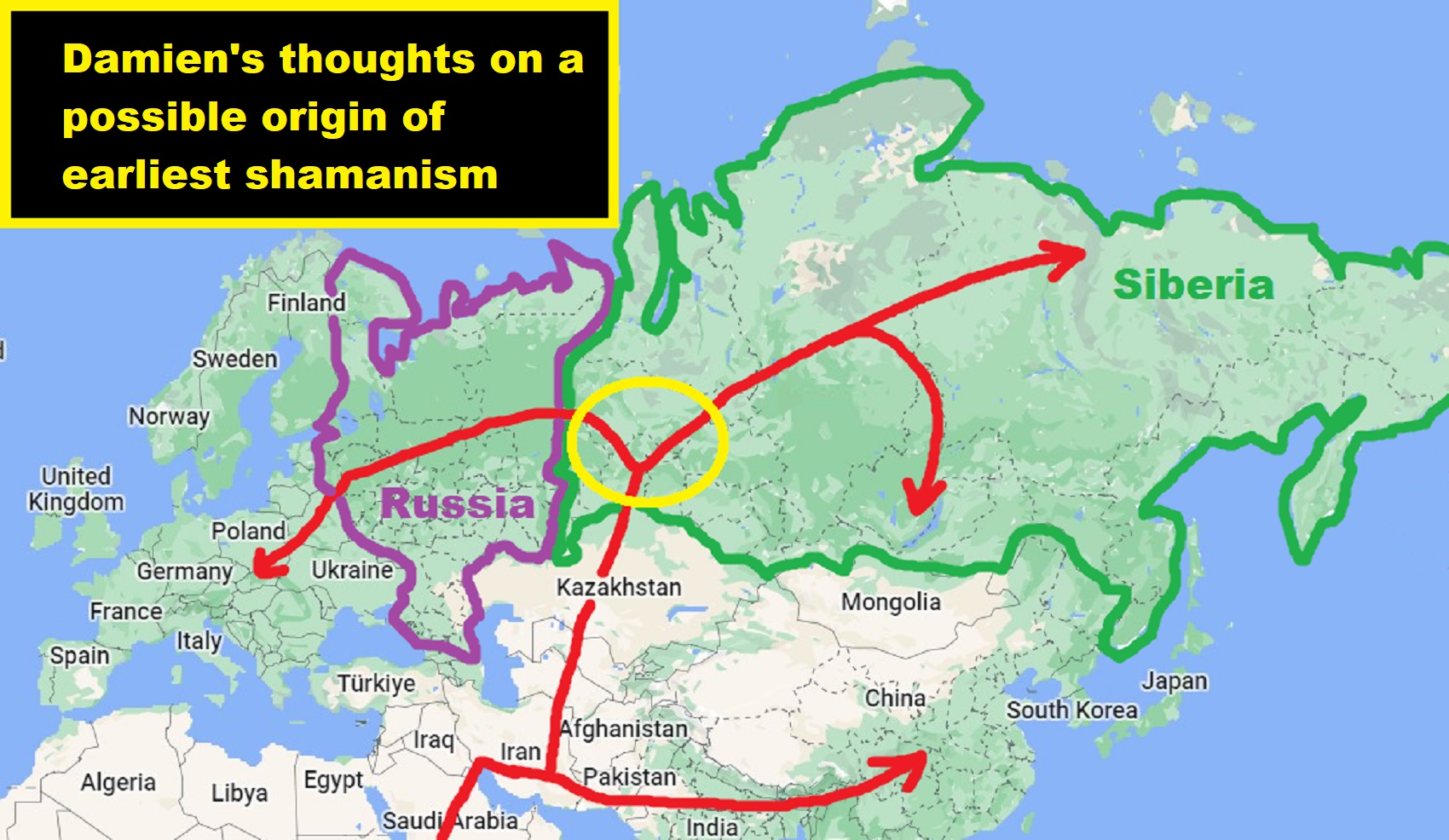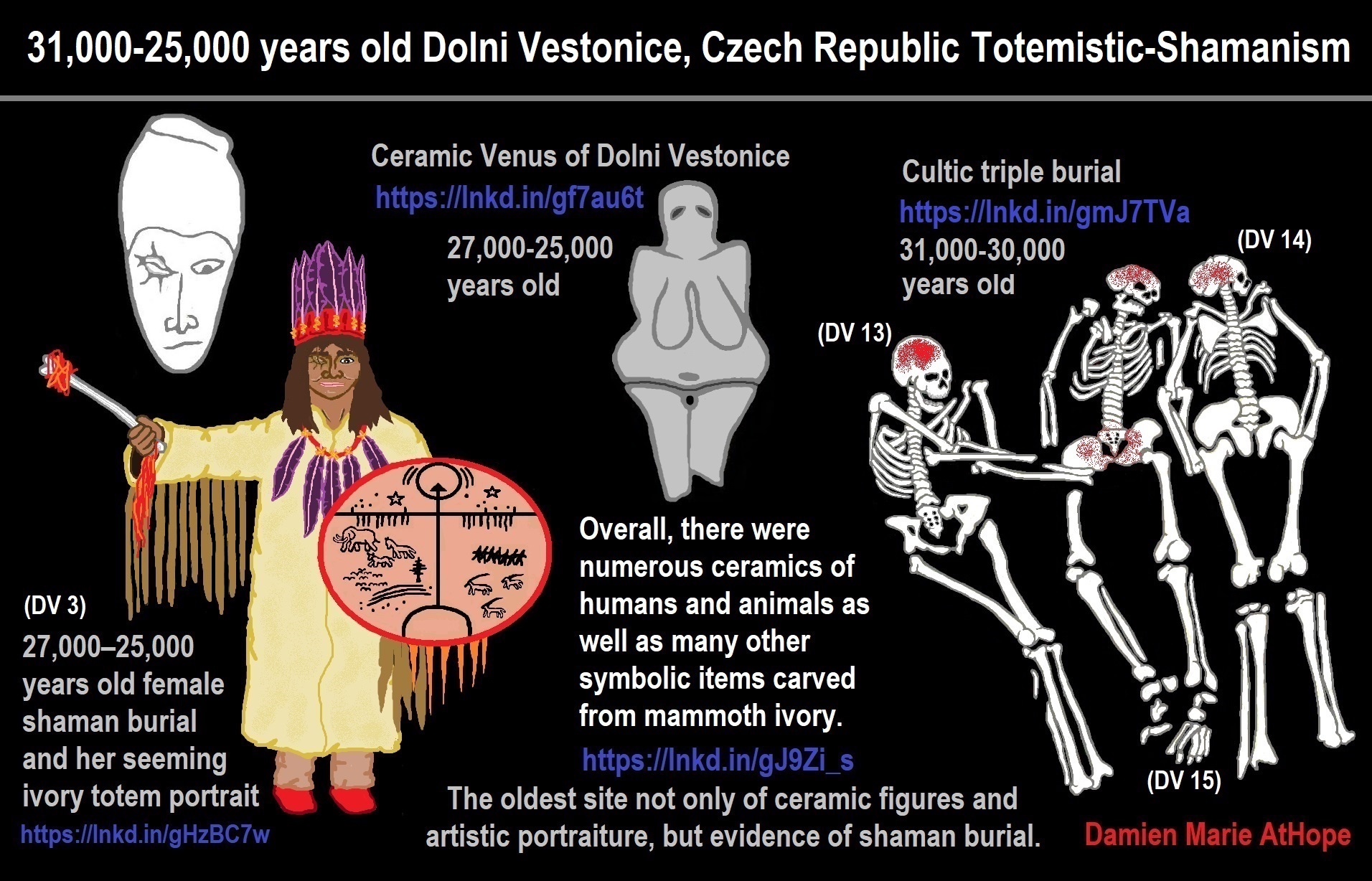“Haplogroup U is a human mitochondrial DNA haplogroup (mtDNA). The clade arose from haplogroup R, likely during the early Upper Paleolithic. Its various subclades (labeled U1–U9, diverging over the course of the Upper Paleolithic) are found widely distributed across Northern and Eastern Europe, Central, Western, and South Asia, as well as North Africa, the Horn of Africa, and the Canary Islands. Basal U was found in the 26,000-year-old remains of Ancient North Eurasian, Mal’ta boy (MA1). The age of U5 is estimated at between 25,000 and 35,000 years old, roughly corresponding to the Gravettian culture. and is the DNA associated with the seeming first Gravettian shaman burial seen in the Pavlovian culture, around Dolní Věstonice in southern Moravia. One of the Dolní Věstonice burials, located near the huts, revealed a human female skeleton aged to 40+ years old, ritualistically placed beneath a pair of mammoth scapulae, one leaning against the other. Surprisingly, the left side of the skull was disfigured in the same manner as the aforementioned carved ivory figure, indicating that the figure was an intentional depiction of this specific individual. The bones and the earth surrounding the body contained traces of red ocher, a flint spearhead had been placed near the skull, and one hand held the body of a fox. This evidence suggests that this was the burial site of a shaman. This is the oldest site not only of ceramic figurines and artistic portraiture, but also of evidence of female shamans.” ref, ref, ref, ref
“Approximately 11% of Europeans (10% of European-Americans) have some variant of haplogroup U5. U5 was the predominant mtDNA of mesolithic Western Hunter Gatherers (WHG). U5 has been found in human remains dating from the Mesolithic in England, Germany, Lithuania, Poland, Portugal, Russia, Sweden, France, and Spain. Neolithic skeletons (~7,000 years old) that were excavated from the Avellaner cave in Catalonia, northeastern Spain included a specimen carrying haplogroup U5. Haplogroup U5 and its subclades U5a and U5b today form the highest population concentrations in the far north, among Sami, Finns, and Estonians. However, it is spread widely at lower levels throughout Europe. This distribution, and the age of the haplogroup, indicate individuals belonging to this clade were part of the initial expansion tracking the retreat of ice sheets from Europe around 10,000 years ago. The modern Basques and Cantabrians possess almost exclusively U5b lineages (U5b1f, U5b1c1, U5b2).” ref
6 Ice Age Humans (30,000 Years Ago)
“Abstract: Starting about 35,000 years ago, humans seem to have made a great leap forward culturally. The authors argue that this wasn’t because of genetic changes that caused the human brain to have increased capacity. It was because some groups culturally evolved the “social tools” that allowed them to maintain connections and share information over long distances. The groups with the most effective social tools managed to stay connected and to survive, and their descendants inherited this culture of connectedness. It’s likely that forming greater connectedness and more complex culture was necessary in order to survive the periods of high climate variability that were a feature of the last ice age.” ref
“Archaeologists usually describe two regional variants: the western Gravettian, known mainly from cave sites in France, Spain, and Britain, and the eastern Gravettian in Central Europe and Russia. The eastern Gravettians, which include the Pavlovian culture, were specialized mammoth hunters, whose remains are usually found not in caves but in open air sites. Gravettian culture thrived on their ability to hunt animals. They utilized a variety of tools and hunting strategies. Compared to theorized hunting techniques of Neanderthals and earlier human groups, Gravettian hunting culture appears much more mobile and complex. They lived in caves or semi-subterranean or rounded dwellings which were typically arranged in small “villages”. Gravettians are thought to have been innovative in the development of tools such as blunted-back knives, tanged arrowheads, and boomerangs. Other innovations include the use of woven nets and oil lamps made of stone. Blades and bladelets were used to make decorations and bone tools from animal remains.” ref
“Gravettian culture extends across a large geographic region, as far as Estremadura in Portugal. but is relatively homogeneous until about 27,000 years ago. They developed burial rites, which included simple, purpose-built offerings and/or personal ornaments owned by the deceased, placed within the grave or tomb. Surviving Gravettian art includes numerous cave paintings and small, portable Venus figurines made from clay or ivory, as well as jewelry objects. The fertility deities mostly date from the early period; there are over 100 known surviving examples. They conform to a very specific physical type, with large breasts, broad hips and prominent posteriors. The statuettes tend to lack facial details, and their limbs are often broken off. During the post glacial period, evidence of the culture begins to disappear from northern Europe but was continued in areas around the Mediterranean. The Mal’ta Culture (c. 24,000 years ago) in Siberia is often considered as belonging to the Gravettian, due to its similar characteristics, particularly its Venus figurines, but any hypothetical connection would have to be cultural and not genetic: a 2016 genomic study showed that the Mal’ta people have no genetic connections with the people of the European Gravettian culture (the Vestonice Cluster).” ref
“Fu et al. (2016) examined the remains of fourteen Gravettians. The eight males included three samples of Y-chromosomal haplogroup CT, one of I, one IJK, one BT, one C1a2, and one sample of F. Of the fourteen samples of mtDNA, there were thirteen samples of U and one sample of M. The majority of the sample of U belonged to the U5 and U2. Teschler et al. (2020) examined the remains of one adult male and two twin boys from a Gravettian site in Austria. All belonged to haplogroup Y-Haplogroup I. and all had the same mtDNA, U5. According to Scorrano et al. (2022), “the genome of an early European individual from Kostenki 14, dated to around 37,000 years ago, demonstrated that the ancestral European gene pool was already established by that time.” ref
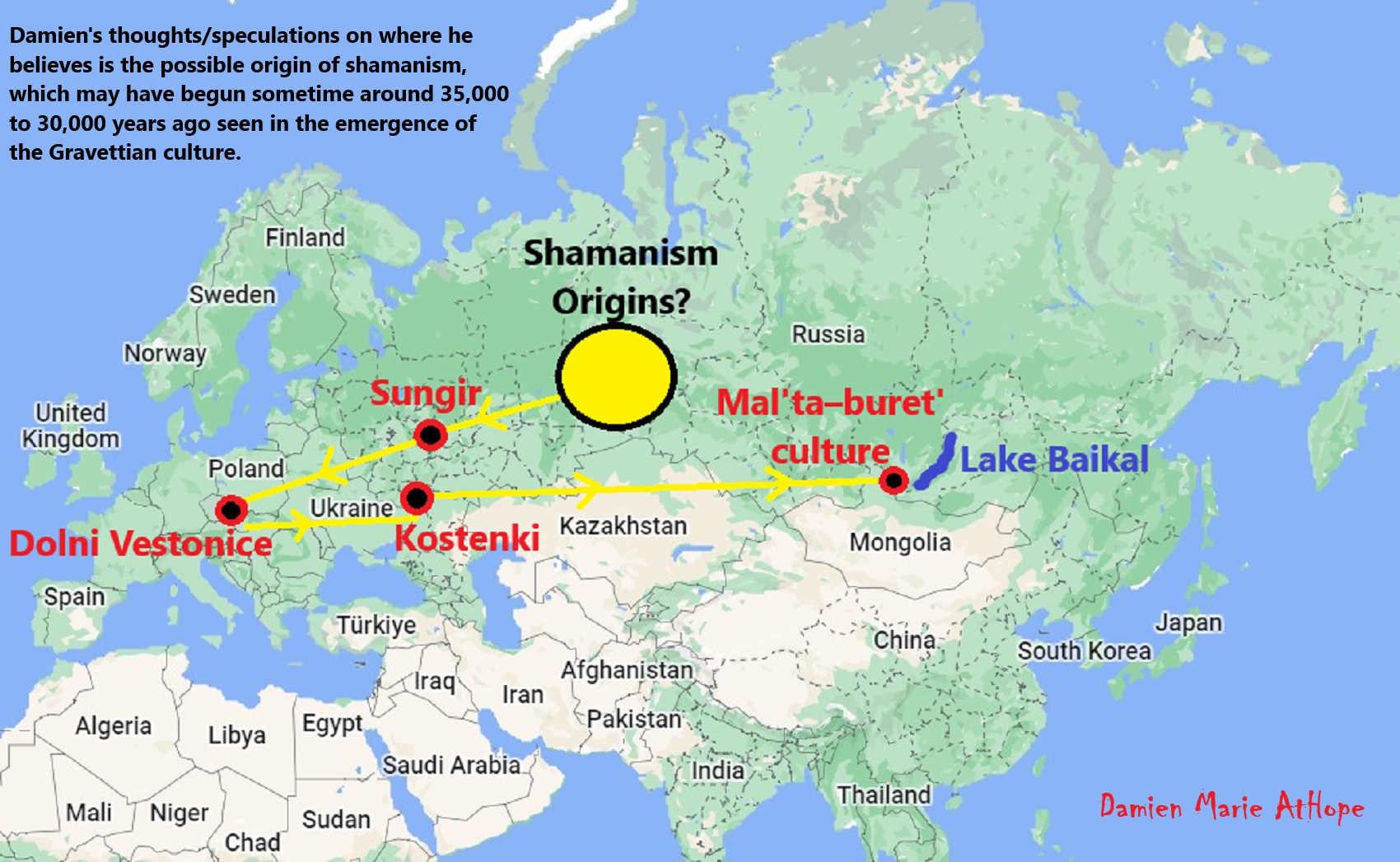
Here are Damien’s thoughts/speculations on where he believes is the possible origin of shamanism, which may have begun sometime around 35,000 to 30,000 years ago seen in the emergence of the Gravettian culture, just to outline his thinking, on what thousands of years later led to evolved Asian shamanism, in general, and thus WU shamanism as well. In both Europe-related “shamanism-possible burials” and in Gravettian mitochondrial DNA is a seeming connection to Haplogroup U. And the first believed Shaman proposed burial belonged to Eastern Gravettians/Pavlovian culture at Dolní Věstonice in southern Moravia in the Czech Republic, which is the oldest permanent human settlement that has ever been found. It is at Dolní Věstonice where approximately 27,000-25,000 years ago a seeming female shaman was buried and also there was an ivory totem portrait figure, seemingly of her.
“The Pavlovian is an Upper Paleolithic culture, a variant of the Gravettian, that existed in the region of Moravia, northern Austria, and southern Poland around 29,000–25,000 years ago. Its name is derived from the village of Pavlov, in the Pavlov Hills, next to Dolní Věstonice in southern Moravia. The culture used sophisticated stone age technology to survive in the tundra on the fringe of the ice sheets around the Last Glacial Maximum. Excavation has yielded flint implements, polished and drilled stone artifacts, bone spearheads, needles, digging tools, flutes, bone ornaments, drilled animal teeth, and seashells. Art or religious finds are bone carvings and figurines of humans and animals made of mammoth tusk, stone, and fired clay.” ref
“One of the burials, located near the huts, revealed a human female skeleton aged to 40+ years old, ritualistically placed beneath a pair of mammoth scapulae, one leaning against the other. Surprisingly, the left side of the skull was disfigured in the same manner as the aforementioned carved ivory figure, indicating that the figure was an intentional depiction of this specific individual. The bones and the earth surrounding the body contained traces of red ocher, a flint spearhead had been placed near the skull, and one hand held the body of a fox. This evidence suggests that this was the burial site of a shaman. This is the oldest site not only of ceramic figurines and artistic portraiture, but also of evidence of female shamans.” ref
“A burial of an approximately forty-year-old woman was found at Dolní Věstonice in an elaborate burial setting. Various items found with the woman have had a profound impact on the interpretation of the social hierarchy of the people at the site, as well as indicating an increased lifespan for these inhabitants. The remains were covered in red ochre, a compound known to have religious significance, indicating that this woman’s burial was ceremonial in nature. Also, the inclusion of a mammoth scapula and a fox are indicative of a high-status burial.” ref
“In the Upper Paleolithic, anatomically modern humans began living longer, often reaching middle age, by today’s standards. Rachel Caspari argues in “Human Origins: the Evolution of Grandparents,” that life expectancy increased during the Upper Paleolithic in Europe (Caspari 2011). She also describes why elderly people were highly influential in society. Grandparents assisted in childcare, perpetuated cultural transmission, and contributed to the increased complexity of stone tools (Caspari 2011). The woman found at Dolní Věstonice was old enough to have been a grandparent. Although human lifespans were increasing, elderly individuals in Upper Paleolithic societies were still relatively rare. Because of this, it is possible that the woman was attributed with great importance and wisdom, and revered because of her age. Because of her advanced age, it is also possible she had a decreased ability to care for herself, instead relying on her family group to care for her, which indicates strong social connections.” ref
“Furthermore, a female figurine was found at the site and is believed to be associated with the aged woman, because of remarkably similar facial characteristics. The woman was found to have deformities on the left side of her face. The special importance accorded with her burial, in addition to her facial deformity, makes it possible that she was a shaman in this time period, where it was “not uncommon that people with disabilities, either mental or physical, are thought to have unusual supernatural powers” (Pringle 2010).” ref
“In 1981, Patricia Rice studied a multitude of female clay figurines found at Dolní Věstonice, believed to represent fertility in this society. She challenged this assumption by analyzing all the figurines and found that, “it is womanhood, rather than motherhood that is symbolically recognized or honored” (Rice 1981: 402). This interpretation challenged the widely held assumption that all prehistoric female figurines were created to honor fertility. The fact is that we have no idea why these figurines proliferated nor of their purpose or usage.” ref
“Haplogroup U5 is estimated to be about 30,000 years old, and it is primarily found today in people with European ancestry. Both the current geographic distribution of U5 and testing of ancient human remains indicate that the ancestor of U5 expanded into Europe before 31,000 years ago. A 2013 study by Fu et al. found two U5 individuals at the Dolni Vestonice burial site in the Czech Republic that has been dated to 31,155 years ago. A third person from the same burial was identified as haplogroup U8. The Dolni Vestonice samples have only two of the five mutations ( C16192T and C16270T) that are found in the present day U5 population. This indicates that the U5-(C16192T and C16270T) mtDNA sequence is ancestral to the present day U5 population that includes the additional three mutations T3197C, G9477A and T13617C.” ref
“Haplogroup U5 is thought to have evolved in the western steppe region and then entered Europe around 30,000 to 55,000 years ago. Results support previous hypotheses that haplogroup U5 mtDNAs expanded throughout Northern, Southern, and Central Europe with more recent expansions into Western Europe and Africa. The results further allow us to explain how U5 mtDNAs are now found with high frequency in Northern Europe, as well as delineate the origins of the specific U5 subhaplogroups found in that part of Europe.” ref
“Haplogroup U5 is found throughout Europe with an average frequency ranging from 5% to 12% in most regions. U5a is most common in north-east Europe and U5b in northern Spain. Nearly half of all Sami and one fifth of Finnish maternal lineages belong to U5. Other high frequencies are observed among the Mordovians (16%), the Chuvash (14.5%) and the Tatars (10.5%) in the Volga-Ural region of Russia, the Estonians (13%), the Lithuanians (11.5%) and the Latvians in the Baltic, the Dargins (13.5%), Avars (13%) and the Chechens (10%) in the Northeast Caucasus, the Basques (12%), the Cantabrians (11%) and the Catalans (10%) in northern Spain, the Bretons (10.5%) in France, the Sardinians (10%) in Italy, the Slovaks (11%), the Croatians (10.5%), the Poles (10%), the Czechs (10%), the Ukrainians (10%) and the Slavic Russians (10%). Overall, U5 is generally found in population with high percentages of Y-haplogroups I1, I2, and R1a, three lineages already found in Mesolithic Europeans. The highest percentages are observed in populations associated predominantly with Y-haplogroup N1c1 (the Finns and the Sami), although N1c1 is originally an East Asian lineage that spread over Siberia and Northeast Europe and assimilated indigenous U5 maternal lineages.” ref
“The age of haplogroup U5 is uncertain at present. It could have arisen as recently as 35,000 years ago, or as early was 50,000 years ago. U5 appear to have been a major maternal lineage among the Paleolithic European hunter-gatherers, and even the dominant lineage during the European Mesolithic. In two papers published two months apart, Posth et al. 2016 and Fu et al. 2016 reported the results of over 70 complete human mitochondrial genomes ranging from 45,000 to 7,000 years ago. The oldest U5 samples all dated from the Gravettian culture (c. 32,000 to 22,000 years ago), while the older Aurignacian samples belonged to mt-haplogroups M, N, R*, and U2. Among the 16 Gravettian samples that yielded reliable results, six belonged to U5 – the others belonging mostly to U2, as well as isolated samples of M, U*, and U8c. Two Italian Epigravettian samples, one from the Paglicci Cave in Apulia (18,500 years ago), and another one from Villabruna in Veneto (14,000 years ago), belonged to U5b2b, as did two slightly more recent Epipaleolithic samples from the Rhône valley in France. U5b1 samples were found in Epipalaeolithic Germany, Switzerland (U5b1h in the Grotte du Bichon), and France. More 80% of the numerous Mesolithic European mtDNA tested to date belonged to various subclades of U5. Overall, it appears that U5 arrived in Europe with the Gravettian tool makers, and that it particularly prospered from the end of the glacial period (from 11,700 years ago) until the arrival of Neolithic farmers from the Near East (between 8,500 and 6,000 years ago).” ref
“Carriers of haplogroup U5 were part of the Gravettian culture, which experienced the Last Glacial Maximum (LGM, 26,000 to 19,000 years ago). During this particularly harsh period, Gravettian people would have retreated into refugia in southern Europe, from which they would have re-expanded to colonise the northern half of the continent during the Late Glacial and postglacial periods. For reasons that are yet unknown, haplogroup U5 seems to have resisted better to the LGM to other Paleolithic haplogroups like U*, U2 and U8. Mitochondrial DNA being essential for energy production, it could be that the mutations selected in early U5 subclades (U5a1, U5a2, U5b1, U5b2) conferred an advantage for survival during the coldest millennia of the LGM, which had for effect to prune less energy efficient mtDNA lineages.” ref
“It is likely that U5a and U5b lineages already existed prior to the LGM and they were geographically scattered to some extent around Europe before the growing ice sheet forced people into the refugia. Nonetheless, founder effects among the populations of each LGM refugium would have amplified the regional division between U5b and U5a. U5b would have been found at a much higher frequency in the Franco-Cantabrian region. We can deduce this from the fact that modern Western Europeans have considerably more U5b than U5a, but also because the modern Basques and Cantabrians possess almost exclusively U5b lineages. What’s more, all the Mesolithic U5 samples from Iberia whose subclade could be identified belonged to U5b.” ref
“Conversely, only U5a lineages have been found so far in Mesolithic Russia (U5a1) and Sweden (U5a1 and U5a2), which points at an eastern origin of this subclade. Mesolithic samples from Poland, Germany and Italy yielded both U5a and U5b subclades. German samples included U5a2a, U5a2c3, U5b2 and U5b2a2. The same observations are valid for the Neolithic and Chalcolithic periods too, with U5a1 being found in Russia and Ukraine, U5b in France (Cardium Pottery and Megalithic), U5b2 in Portugal. U5b1b1 arose approximately 10,000 years ago, over two millennia after the end of the Last Glaciation, when the Neolithic Revolution was already under way in the Near East. Despite this relatively young age, U5b1b1 is found scattered across all Europe and well beyond its boundaries. The Saami, who live in the far European North and have 48% of U5 and 42% of V lineages, belong exclusively to the U5b1b1 subclade. Amazingly, the Berbers of Northwest Africa also possess that U5b1b1 subclade and haplogroup V.” ref
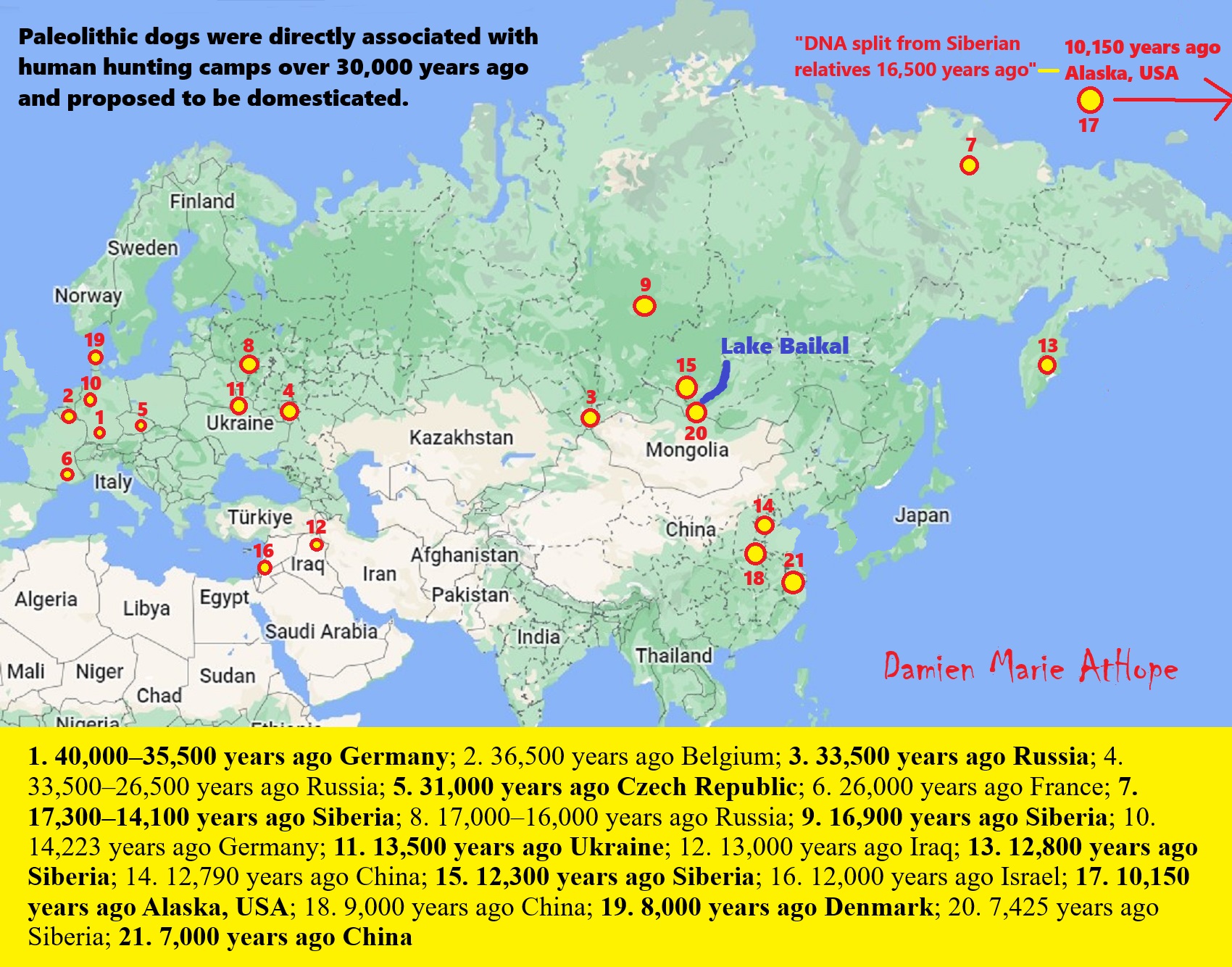
“The Paleolithic dog was a Late Pleistocene canine. They were directly associated with human hunting camps in Europe over 30,000 years ago and it is proposed that these were domesticated. They are further proposed to be either a proto-dog and the ancestor of the domestic dog or an extinct, morphologically and genetically divergent wolf population. There are a number of recently discovered specimens which are proposed as being Paleolithic dogs, however, their taxonomy is debated. These have been found in either Europe or Siberia and date 40,000–17,000 years ago. They include Hohle Fels in Germany, Goyet Caves in Belgium, Predmosti in the Czech Republic, and four sites in Russia: Razboinichya Cave in the Altai Republic, Kostyonki-8, Ulakhan Sular in the Sakha Republic, and Eliseevichi 1 on the Russian plain.” ref
- 40,000–35,500 years ago Hohle Fels, Schelklingen,Germany
2. 36,500 years ago Goyet Caves,Samson River Valley, Belgium
3. 33,500 years ago Razboinichya Cave, Altai Mountains, (Russia/Siberia)
4. 33,500–26,500 years ago Kostyonki-Borshchyovo archaeological complex, (Kostenki site) Voronezh, Russia
5. 31,000 years ago Predmostí, Moravia, Czech Republic
6. 26,000 years ago Chauvet Cave, Vallon-Pont-d’Arc, Ardèche region, France
7. 17,300–14,100 years ago Dyuktai Cave, northern Yakutia, Siberia
8. 17,000–16,000 years ago Eliseevichi-I site, Bryansk Region, Russian Plain, Russia
9. 16,900 years ago Afontova Gora-1, Yenisei River, southern Siberia
10. 14,223 years ago Bonn–Oberkassel, Germany
11. 13,500 years ago Mezine, Chernigov region, Ukraine
12. 13,000 years ago Palegawra, (Zarzian culture) Iraq
13. 12,800 years ago Ushki I, Kamchatka, eastern Siberia
14. 12,790 years ago Nanzhuangtou, China
15. 12,300 years ago Ust’-Khaita site, Baikal region, Siberia
16. 12,000 years ago Ain Mallaha (Eynan) and HaYonim terrace, Israel
17. 10,150 years ago Lawyer’s Cave, Alaska, USA
18. 9,000 years ago Jiahu site, China
19. 8,000 years ago Svaerdborg site, Denmark
20. 7,425 years ago Lake Baikal region, Siberia
21. 7,000 years ago Tianluoshan archaeological site, Zhejiang province, China ref
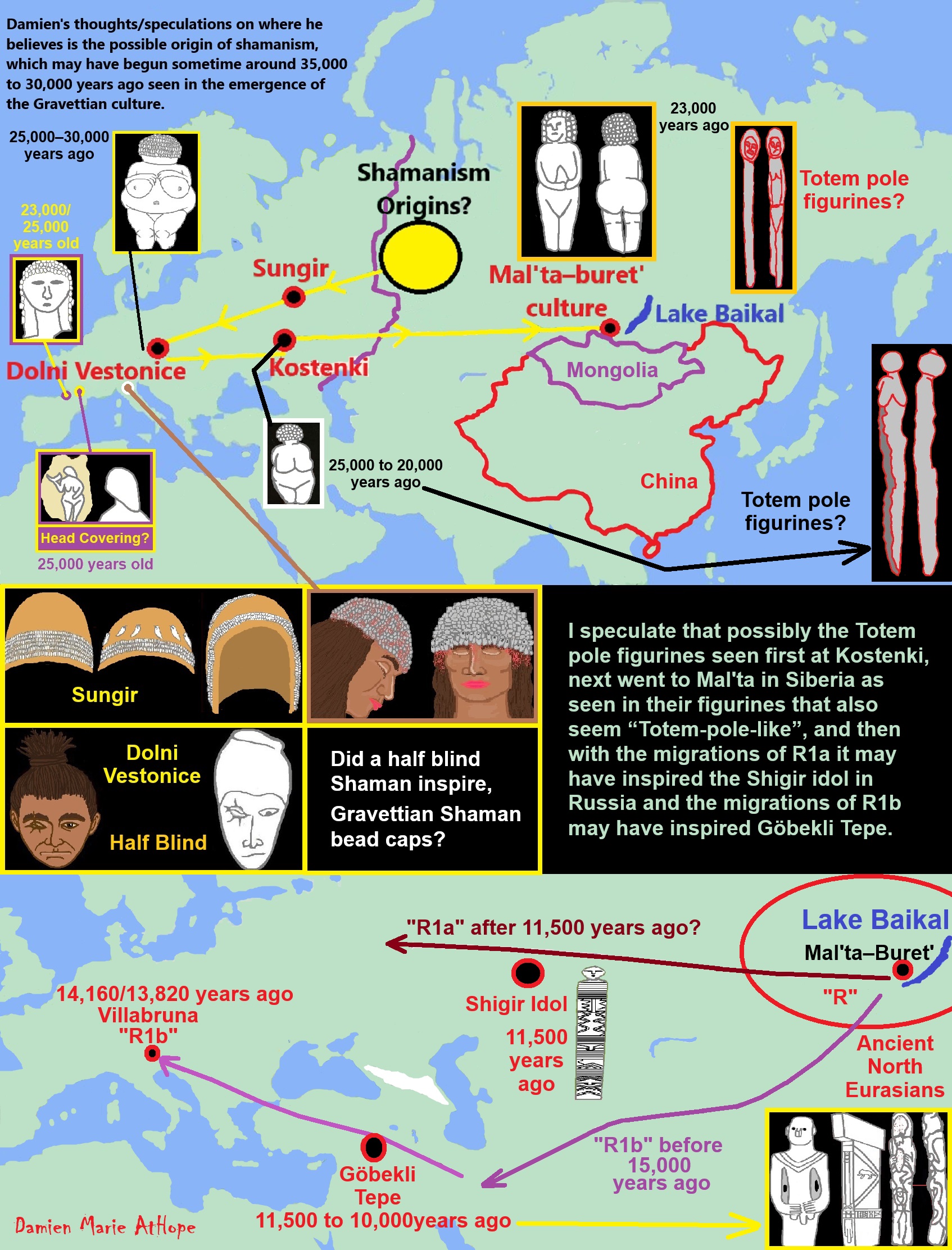
ref, ref, ref, ref, ref, ref, ref, ref, ref, ref, ref, ref, ref, ref, ref, ref, ref, ref, ref
Here are my thoughts/speculations on where I believe is the possible origin of shamanism, which may have begun sometime around 35,000 to 30,000 years ago seen in the emergence of the Gravettian culture, just to outline his thinking, on what thousands of years later led to evolved Asian shamanism, in general, and thus WU shamanism as well. In both Europe-related “shamanism-possible burials” and in Gravettian mitochondrial DNA is a seeming connection to Haplogroup U. And the first believed Shaman proposed burial belonged to Eastern Gravettians/Pavlovian culture at Dolní Věstonice in southern Moravia in the Czech Republic, which is the oldest permanent human settlement that has ever been found. It is at Dolní Věstonice where approximately 27,000-25,000 years ago a seeming female shaman was buried and also there was an ivory totem portrait figure, seemingly of her.
And my thoughts on how cultural/ritual aspects were influenced in the area of Göbekli Tepe. I think it relates to a few different cultures starting in the area before the Neolithic. Two different groups of Siberians first from northwest Siberia with U6 haplogroup 40,000 to 30,000 or so. Then R Haplogroup (mainly haplogroup R1b but also some possible R1a both related to the Ancient North Eurasians). This second group added its “R1b” DNA of around 50% to the two cultures Natufian and Trialetian. To me, it is likely both of these cultures helped create Göbekli Tepe. Then I think the female art or graffiti seen at Göbekli Tepe to me possibly relates to the Epigravettians that made it into Turkey and have similar art in North Italy. I speculate that possibly the Totem pole figurines seen first at Kostenki, next went to Mal’ta in Siberia as seen in their figurines that also seem “Totem-pole-like”, and then with the migrations of R1a it may have inspired the Shigir idol in Russia and the migrations of R1b may have inspired Göbekli Tepe.
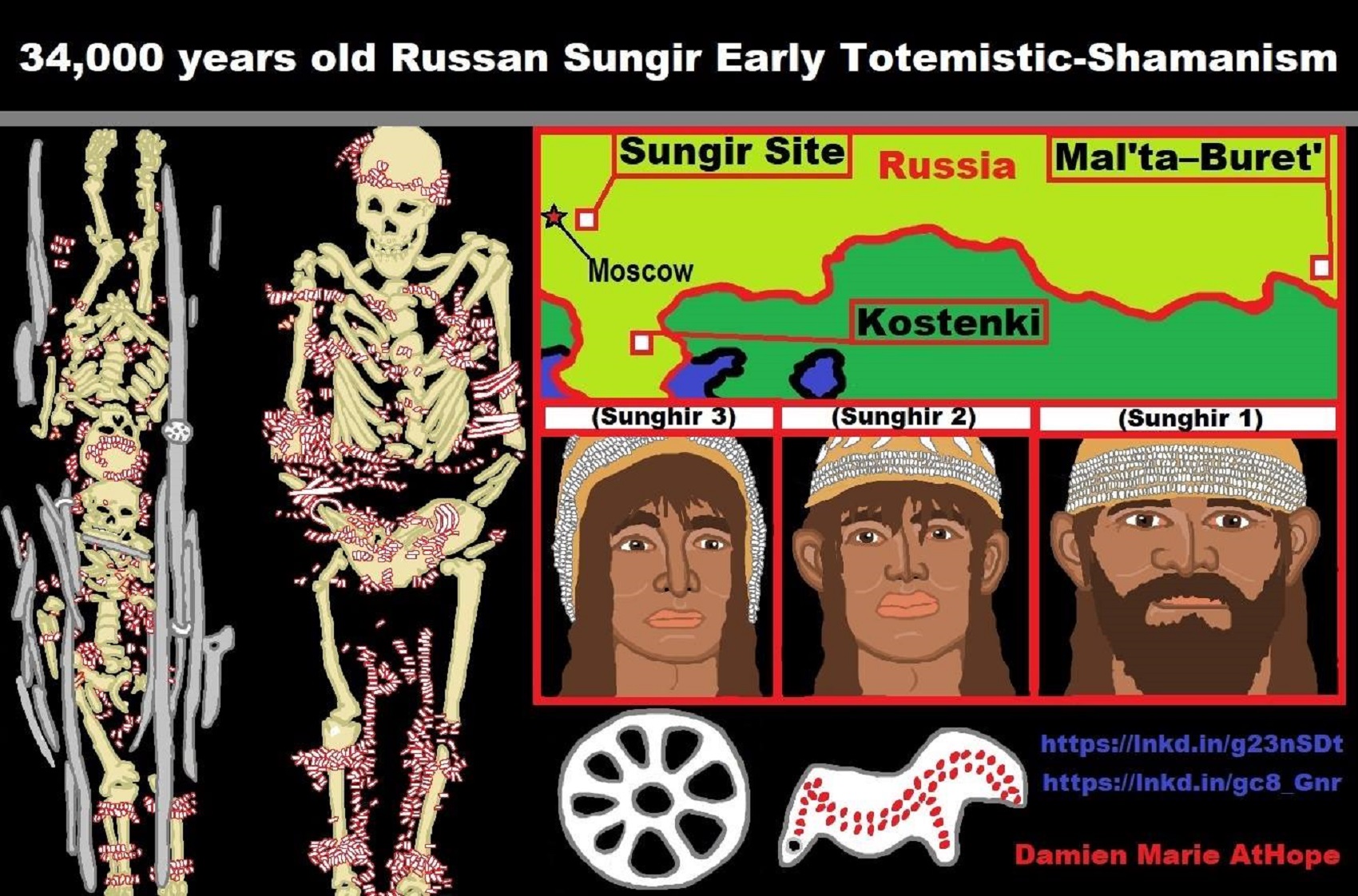
Early Shamanism around 34,000 to 20,000 years ago:
Sungar “Gravettian culture” (Russia) and
Dolni Vestonice Pavlovian/Gravettian culture (Czech Republic)
“notes, I gathered and somewhat arranged for my book, but most will go, it’s just more fun more fully explained”
30,000 Years Ago – (Eurasia), found evidence that the earliest human burial practices varied widely, with some graves are ornate while the vast majority were fairly plain but it seems to be a more common ritual showing the further solidification of ritualizing was blooming. Overall, between 35,000 years ago and 10,000 years ago there is a wide variation in human burial customs. http://www.sciencedaily.com/releases/2013/02/130221084747.htm
32,050 – 19,000 Years Ago – Sungar (Russia), found posable evidence of shamanistic Gravettian culture burials and that seem to match the latter indigenous American shamanistic burials in Alaska at the Tanana River site with around 11,500 years old duel infant burial very similar shamanistic grave offerings like decorated stone weapons.
To further a clear connection is the Bluefish Cave (Yukon Territory Canada) that held bones with cut marks which is possibly as old as 24,000 to 19,650 years ago and the youngest are around 12,000 years old seem to offer strong support for the “Beringian hypothesis” human population dispersed to North and South America.
To me, is seems Siberian is the general origin of native Americans at least by around 11,000 years ago, by the land bridge “Beringia” from Asia by way of Siberia in Russia over to Alaska in the Americas, which the Paleoindians had crossover on, finally flooded over by rising sea levels and was submerged. Siberia has a large variety in climate, vegetation, and landscape. Siberia’s Prehistory demonstrates several distinct cultures sometimes transferring ideas, other times not, and some split from earlier cultures creating new ones often in illation, mainly starting with hunter-gatherer nomadism. During glaciation around 115,000 to 15,000 years ago, the Siberia tundra extended south and an ice sheet covered area of Russia around the Ural Mountains that while some of the oldest mountains are more like large hills, and the area to the east of the lower Yenisei River basin, which in the general area of central and southern Siberia. Some of the first nomadic peoples entered Siberia about 50,000 years ago. Ancient nomadic tribes such as the Ket people and the Yugh people a separate but similar group lived along its banks. Shamanism among Kets shares characteristics with those of Turkic and Mongolic peoples thus not at all homogeneous in expression though neither is shamanism in Siberia in general. As for shamanism among Kets had several types of Ket shamans and shared characteristics with those of Turkic and Mongolic peoples.
The Yana River sites, in Siberia, demonstrate that modern human populations had reached Western Beringia by 32,000 years ago then engaging in an early dispersal possibly by 24,000 years ago. At around 45,000 years old human remains (Ust’-Ishim man) found in Western Siberia the beginning fought that went to central Siberia then eastern and then over to the Americas maybe beginning as early as 30,000 years ago, though based on genetic from Haplogroup Q studies sometime around 15,000 years ago. the artefacts found are similar to the Dyuktai culture in Eastern Siberia possibly originating as early as 22,000–20,000 years ago. Moreover, the Ust’-Ishim man, a hunter-gather found at the Irtysh River whose source is in the Mongolian Altai. The Altai Mountains first colonization came from Southwest Asia around 38,000 years ago. Ust’-Ishim man, with DNA seeming to connect to the first wave of humans to migrate out of Africa into Eurasia and now closely related to modern indigenous peoples of the Americas, East Asian, Oceanian, and Eurasia populations, such as the current residents of the Ust’-Ishim area located in southwestern Siberia sharing borders with Kazakhstan to the south. Modern Tibetans have the most in common with Ust’-Ishim man but Siberian and East Asian populations shared 38% similar ancestry. Ust’-Ishim man has genetic links to the 24,000 years ago 4-year-old Mal’ta boy part of the Mal’ta–Buret’ culture from south-central Siberia west of Lake Baikal, who’s shamanistic burial including a presumed anthropomorphic female figurine as well as connects to 14-38% similar ancestry to Native Americans.
One of 29 female figurine “horn/bone cut Mal’ta Venuses” with a gaunt face “possibly sacred” portable art for a nomadic portable people at Mal’ta, near Lake Baikal dated to around 23,000 years ago expressing similarities to both the around 13,500-year-old shamanistic totem the “stone cut Urfa man” with a gaunt faced man from Southeast Turkey and the around 11,000-year-old shamanistic totem the “wood cut Shigir Idol” with a gaunt faced man from in Russia and Shaman’s cache schematic figure that is similar to both Urfa man’s face and the Mal’ta Venus’ face as well as tapered end. It is other figurines in carved bone, ivory, and antler most commonly depicting of birds and human females believed to cold significance as a totemistic fertility rite. Generally, these figurines were tapered at the bottom, and it is believed that this was done so they could have been stuck into the ground or placed upright and could have symbolized totem “spirit dolls”, which seen in ritual use nearly world-wide, including currently in Siberia. The Mal’ta–Buret’ culture from south-central Siberia west of Lake Baikal is closely related to Ochre Grave/Yamna culture peoples the Yamnaya, Siberians, Native Americans, indigenous Mansi Western Siberia, indigenous Nganasans north Siberia descendants of Paleo-Siberian peoples who were culturally assimilated by various Samoyedic peoples, indigenous Yukaghirs one of the oldest peoples in North-Eastern Asia ranging originally from Lake Baikal to the Arctic Ocean and Kets in central and southern Siberia. “Avam people.”
The Avam-Nganasans refer to themselves as “friend tribe,” “Avam” signifying the “real people” which is also what they call the neighboring tribe the Madu Enets, whereas the Vadeyev Nganasans to the East prefer to refer to themselves as “brother,” which is also what they call the neighboring tribes the Evenk or Dolgan. The Yukaghir peoples still practice shamanism with ancestral spirits, the spirits of Fire, Sun (highest cult), Hunting, Earth, and Water. Dead spirits go to “Aibidzi” watching and helping whereas when a shaman “Alma” dies they were often treated as a kind of deity spirit thus the vary bones of the dead shaman-god parts where then seen as sacred clan totem relics. Also, among Kets differing shamans was different sacral rites, power, and associated animals (deer or bear) and many other Siberian peoples like the Karagas who all seem to have a shared iconography using skeleton symbols. These skeleton symbols, could be a precursor to the later skull cult motivation in the fertile crescent, it may be bones of a helper animal or an ancestor used by a shaman, possibly joining the air and underwater worlds for a kind of shamanic rebirth expressed among some other Siberian cultures. The term “shamanism” which probably originates from the southwestern dialect derived from the Sym-Evenki peoples, connects to the Evenki word “Saman.” The Evenki language has three large dialect groups: the northern, the southern and the eastern dialects formerly known as Tungus or Solon member of the northern group of Tungusic languages (“Tungusic” referring to the Evenks/Evenki Indigenous peoples of Siberia, Northeast China 56 ethnic groups/ Mongolia 535 ethnic groups referred to as Khamnigan; a Mongolic language spoken east of Lake Baikal in Russia, located in southern Siberia) and especially the Oroqen language.
The general area that is believed to be the native land of Evenki people involves a vast regions of Siberia between Lake Baikal and the Amur River. The Ewenki language forms the northern branch of the Manchu-Tungusic language group and is closely related to Even and Negidal in Siberia. Moreover, the term “shamanism” was first applied the ancient religion of the Turks, Mongols, Tungusic, and Samoyedic-speaking peoples but now describe even unrelated magico-religious practices in ethnic religions in Asia, Africa, Australasia and the Americas; which do to the seeming similarity in some themes and practices. 11,000 years The Shigir Idol (Totem pole) wooden sculpture of what seems to be a man with seven faces, only one is developed along (images of spirits/ansestors) with geometric symbols, wavy lines or zigzag symbolised the watery element, snake, in the peat bog Kirovgrad, Sverdlovsk region, in the Ural Mountains western Siberia. The Shigir peat bog contains 68 sites and this artifact Seems similar to totem pole symbols the animistic peoples of western North America, word totem derives from the Algonquian (most likely Ojibwe) meaning “kinship group” and carvings may symbolize or commemorate cultural beliefs that recount familiar legends, clan lineages, or notable events. symbol to the animistic peoples of western North America. The Okunev culture Southern Siberia left large numbers of ‘masks’ and engravings, on totem pole like rocks several of feet tall and are seen as the Siberian ethnic grouping most closely related to Native Americans.
The Okunev culture often used the images of animals in their carvings, such as, one with a shamanistic being depicting a gaunt-faced and shake at either side and rays shooting out the head. There is a special burial dated to around 4,500 to 3,800 years ago of a shaman or noblewoman’s grave was found in the Khakassia region of Siberia f note was an incense burner in the grave goods that shows drawings of the sun and match rock art found in the region. Her burial contained a child seeming to clutch her left side around the level of her pelvis was with around 100 decorations made from the teeth of different animals, items carved from bone and horn, two jars, cases with bone needles, a bronze knife, and more than 1,500 beads that on a seeming special funeral costume. The woman and child with a stone box grave common to these peoples are thought to have belonged to the Okunev people who DNA and cranial studies have suggested are the long-ago ancestors of hunter-gatherers that traveled from southern Siberia to North America some 12,600 years ago.
In southern Turkey Gobekli Tepe totemism somewhat similar massive temple stone totems that involve anthropomorphic/zoomorphic one of which is clearly a “totem like fertility” and most others are “T-shaped pillars” generally consisting of a circle. One of importance is at the sites central temple with a dynamiter of over 30 ft that consists of intermittently spaced 13 ft. zoomorphic (animal reliefs) stone pillars totems and two anthropomorphic (human like reliefs) 18 ft. central pillars in the circle of pillar stones constructed at around 12,000 to 11,000 years ago. Gobekli Tepe totemism similarities match nearby Nevali Cori cult buildings dated to around 10,400 years ago and the Shigir Idol in Russia is seen in a stone head (broken from a larger source) found with a similar strong nose but rather featureless face. In addition, this around 11,000-year-old shamanistic totem the “Big wood cut Shigir Idol” semis to have a face representation to the 13,500-year-old shamanistic totem the Urfa man/Balikligol statue, is a human-size statue of a gaunt faced man Southeast Turkey around the time and general area as the Gobekli Tepe manmade religious temple complex with the T-shapes seen with similar V-shape neck design as well as the significance of the referencing of embracing the navel and birth to the Urfa man embracing his genitals as all possibly totem iconography seems to be expressing a fertility cult in likely in a shamanistic/animistic religious persuasion. Around the time of 11,700 to 8400 years ago was a period totemistic ritual and shamanistic cultic objects such as human busts, plaster human skull, Kfar HaHoresh in northern Israel, human mask at Jericho in the West Bank eastcentral Israel, human busts and human figurines grouped at Ain Ghazal in western Jordan all of which have similarities in face symbiology to bot the Urfa man Idol and the Shigir Idol.
Moreover, The Urfa man Idol is around the same age as the anthropomorphic (expressionless faced man) to featureless face represented at Nevali Cori that also has a ” human head and bird-like body stone totem pole and also a gaunt faced man similar to the Shigir Idol in a stone statue at Gobekli Tepe with a protruding erection that points to fertility symbolism. Speaking of fertility, a comparison of Ust-Ishim and Kum6 to an Asian Upper Paleolithic individual confirms that Kum6 shows more affinity to early Europeans. Kum6 6,700-years-old individual (at Kumtepe in northwestern Turkey) carries a DNA frequently found in early farmers of Europe and the Near East that falls between modern-day West Asians and Europeans as well as shows the greatest genetic similarity to Sardinians (an island in the Mediterranean located west of Italy), Greeks, and Cypriots (an island in the Mediterranean located south of Turkey) but also a genetic link that is the most common in Europe and the Near East which likely originated in the Near East 25,000–30,000 years ago and is also observe in a more limited amount in the later Yamnaya culture who were part of a wave of nomadic herders that interbred with local farmers beginning around 5,000 years ago involving a large migration in different directions, including Europe, Siberia to Scandinavia to originating peoples who lived in the Minusinsk Basin and the Altai Mountains that originally colonized by Southwest Asia around 38,000 years ago. Southern Siberia and Mongolia around 5,500 to 4,500 years ago whose burials where in a flexed position covered in ochre and included animal bones under mounds and were among the first people to drive carts with wheels and tame horses also links them to people in central and eastern Europe including the later Yamnaya culture. The Tekkekoy Caves in northcentral Turkey at the Black Sea coast seems to demonstrate that people that lived between 60,000 to 12,000 years ago. Moreover, genetically the Yamnaya of the northern steppe of Russia were indistinguishable from the Yenesey region of southern Siberia.
The ancient DNA of two closely related 7,700-year-old women from a mountainous cave in far east Russia Chertovy Vorota Cave, the humans were found with pottery, harpoons, and the remnants of nets and mats woven from twisted blades of wild sedge grass. Interestingly enough, there is evidence of a Paleoindian wrapped in tule matting around 12,000 to 11,000 years ago from Nevada in America where several Native American groups make tules into many waved items. These women from 7,700 years ago most closely relate to the “Ulchi” an indigenous people live in Khabarovsk Krai, the Russian Far East that has genetic similarities to Native American groups. Moreover, the Native American A–D DNA originated in different parts of Siberia, northwestern and northern Siberia to which the indigenous Mansi and the Ket belong thus a confirming commonality in a Siberian ancestor of Paleoindians. Moreover, the closest genetic relatives to the indigenous peoples of the Americas B2 DNA originated in the indigenous Tubalar the Altai region and the indigenous Tuvan/ Uriankhai in southern Siberia whose religion of Tuvans is a type of Turkic animistic shamanism similar to Tengrism.
Tengrism is a Central Asian religion characterized by shamanism, animism, totemism, ancestor worship and polytheism/monotheism as well as was the prevailing religion of the Turks, Mongols, Hungarians, Xiongnu, Huns, and the religion of the five ancient Turkic states: Gokturk Khaganate, Western Turkic Khaganate, Great Bulgaria, Bulgarian Empire and Eastern Tourkia (Khazaria). Tengri is mentioned as god of Turks and in modern Turkey, Tengrism is known as the (“Sky God religion”) which sems to also connect to how Mongolians still pray to Munkh Khukh Tengri (“Eternal Blue Sky”). A movement similar to Tengrism is Burkhanism concentrated in Altay situated at the Altai Mountains. Burkhan means “god/buddha” in Mongolic languages, yet but is not limited to Buddhist is used in shamanistic beliefs like how in Mongolian Shamanism, the most sacred mountain is Burkhan Khaldun “god Mountain” situated in northeastern Mongolia, with mountain worship going back sever thousands of years. In southern Turkey Gobekli Tepe’s totemism/shamanism is somewhat similar to the massive Shigir Idol totem with its massive temple stone totems, that involve anthropomorphic/zoomorphic one of which is clearly a “totem like fertility” and most others are “T-shaped pillars” generally consisting of a circle. One of importance is at the sites central temple with a dynamiter of over 30 ft that consists of intermittently spaced 13 ft. zoomorphic (animal reliefs) stone pillars totems and two anthropomorphic (human like reliefs) 18 ft. central pillars in the circle of pillar stones constructed at around 12,000 to 11,000 years ago. Gobekli Tepe totemism similarities match nearby Nevali Cori cult buildings dated to around 10,400 years ago and the Shigir Idol in Russia is seen in a stone head (broken from a larger source) found with a similar strong nose but rather featureless face. In addition, this around 11,000-year-old shamanistic totem the “Big wood cut Shigir Idol” semis to have a face representation to the 13,500-year-old shamanistic totem the Urfa man/Balikligol statue, is a human-size statue of a gaunt faced man Southeast Turkey.
Around the time and general area as the Gobekli Tepe manmade religious temple complex with the T-shapes seen with similar V-shape neck design as well as the significance of the referencing of embracing the navel and birth to the Urfa man embracing his genitals as all possibly totem iconography seems to be expressing a fertility cult in likely in a shamanistic/animistic religious persuasion. Moreover, The Urfa man Idol is around the same age as the anthropomorphic (expressionless faced man) to featureless face represented at the Two female figurines at Tell Fekheriye dated to around 11,000 to 9,000 years ago with bitumen and stone inlays and at Nevali Cori dated to around 10,400 to 10,100 years ago with also has a human head and bird-like body stone totem pole and also a gaunt faced man similar to the Shigir Idol in a stone statue at Gobekli Tepe with a protruding erection that points to fertility symbolism. Speaking of fertility, a comparison of Ust-Ishim and Kum6 to an Asian Upper Paleolithic individual confirms that Kum6 shows more affinity to early Europeans. Kum6 6,700-years-old individual (at Kumtepe in northwestern Turkey) carries a DNA frequently found in early farmers of Europe and the Near East that falls between modern-day West Asians and Europeans as well as shows the greatest genetic similarity to Sardinians (an island in the Mediterranean located west of Italy), Greeks, and Cypriots (an island in the Mediterranean located south of Turkey) but also a genetic link that is the most common in Europe and the Near East which likely originated in the Near East 25,000–30,000 years ago and is also observe in a more limited amount in the later Yamnaya culture who were part of a wave of nomadic herders that interbred with local farmers beginning around 5,000 years ago involving a large migration in different directions, including Europe, Siberia to Scandinavia to originating peoples who lived in the Minusinsk Basin and the Altai Mountains that originally colonized by Southwest Asia around 38,000 years ago.
There seems to be a connection between southern Siberia and Mongolia around 5,500 to 4,500 years ago whose burials where in a flexed position covered in ochre and included animal bones under mounds and were among the first people to drive carts with wheels and tame horses also links them to people in central and eastern Europe including the later Yamnaya culture. Moreover, genetically the Yamnaya of the northern steppe of Russia were indistinguishable from the Yenesey region of southern Siberia. The ancient DNA of two closely related 7,700-year-old women from a mountainous cave in far east Russia Chertovy Vorota Cave, the humans were found with pottery, harpoons, and the remnants of nets and mats woven from twisted blades of wild sedge grass. Interestingly enough, there is evidence of a Paleoindian wrapped in tule matting around 12,000 to 11,000 years ago from Nevada in America where several Native American groups make tules into many waved items.
These women from 7,700 years ago most closely relat to the “Ulchi” an indigenous people live in Ulchsky District of Khabarovsk Krai in the Russian Far East who have genetic similarities to several Native American groups. Moreover, the Native American A–D DNA originated in different parts of Siberia, northwestern and northern Siberia to which the indigenous Mansi and the Ket belong thus a confirming commonality in a Siberian ancestor of Paleoindians. Moreover, the closest genetic relatives to the indigenous peoples of the Americas B2 DNA originated in the indigenous Tubalar the Altai region and the indigenous Tuvan/ Uriankhai in southern Siberia whose religion of Tuvans is a type of Turkic animistic shamanism similar to Tengrism. Tengrism is a Central Asian religion characterized by shamanism, animism, totemism, ancestor worship and polytheism/monotheism as well as was the prevailing religion of the Turks, Mongols, Hungarians, Xiongnu, Huns, and the religion of the five ancient Turkic states: Gokturk Khaganate, Western Turkic Khaganate, Great Bulgaria, Bulgarian Empire and Eastern Tourkia (Khazaria). Tengri is mentioned as god of Turks and in modern Turkey, Tengrism is known as the (“Sky God religion”) which seems to also connect to how Mongolians still pray to Munkh Khukh Tengri (“Eternal Blue Sky”). A movement similar to Tengrism is Burkhanism concentrated in Altay situated at the Altai Mountains. Burkhan means “god/buddha” in Mongolic languages, yet but is not limited to Buddhist is used in shamanistic beliefs like how in Mongolian Shamanism, the most sacred mountain is Burkhan Khaldun “god Mountain” situated in northeastern Mongolia, with mountain worship going back sever thousands of years. Another link of importance is a Okunev culture grave of importance on shore of Lake Itkul, Siberia containing a one-year-old infant, which was also dated to around 4,500 years ago with anthropomorphic and zoomorphic engraving.
A total of eight 3-inch long carved figurines with the faces of humans, birds, elk and a boar were on the infant’s chest strung in a necklace of figurine pendants similar to shrunken totem poles. This shamanistic/totemistic pendant neckless were intricately carved from antlers some are hollow seeming rattles that may have held some shamanistic charm quality more evident in how the traces of red paint are in the grooves of the carved figurines possibly to protect against evil spirits. The indigenous Koryak wood masks depicting gaunt-faced men for purging kalas (evil spirits) seem to have a similar imagery to the face of the Shigir Idol similar to masks from Barrow, Alaska but Koryak wood masks are only human rather than animal or semi-human form as in Americas. immediately north of the Kamchatka Peninsula in Kamchatka Krai and inhabit the coastlands of the Bering Sea that create human rather than animal or semi-human form as in America. Similarly, Koryak women would use an anthropomorphic fireboard thin male depicting gaunt-faced person similar imagery to the face of the Shigir Idol and was also use to protect against evil spirits like many other charms. The Male face of the Shigir Idol could demonstrate an indigenous symbiology understood as “Man/men, people.” The term Ket means “man” (plural understood as “men, people”) thought to be the only survivors of an ancient nomadic people believed to have originally lived throughout central and southern Siberia descendants of the tribes of fishermen and hunters of the Yenisey taiga, who adopted some of the cultural ways of those original Ket-speaking tribes, who are suggested to be part of the Na-Dene language family represents a distinct migration of people from Asia to the New World. Na-Dene languages seem likely to connect to the Yeniseian languages of central Siberia into a Dene–Yeniseian in which it has been purposed the Na-Dene languages of North America seem to connect to the Yeniseian languages of central Siberia into a Dene–Yeniseian family as a common origin in a language spoken in Beringia, between the two continents. Na-Dene (Proto-Athabascan–Eyak–Tlingit) also his also been purposed to have a connection to Haida, thus seemingly linking several isolated languages between the Asian and North American continent spreading religious thought. The Athabaskan languages, thus could possibly connect with both Northern (mainly northern parts of North America) and Southern (mainly southern parts of North America) Athabaskan of Native languages in the Americas. Northern Athabaskan connected dialects seem to be associated with such indigenous speakers in Alberta, British Columbia, Manitoba, Northwest Territories, Nunavut, Saskatchewan, Yukon, Alaska, parts of Oregon, and northern California. and the American Southwest to northern Mexico. And in Southern Athabaskan or Apachean, and includes Apache and Navajo languages.
Furthermore, the origin of the Evenks seems to involve a complex mixing of different ancient aboriginal tribes from the north of Siberia with tribes related in language to the Turks and Mongols. The language of these tribes took precedence over the languages of the aboriginal population “Vasilevich” meaning the Tungusic languages aborigianals the Kets in Evenkia and Yukagirs in Yakutia. A chum (similar to a Native American “tipi”) came from Komi word “com” or Udmurt word “cum” which both mean “tent like shelter” is a temporary dwelling used by the nomadic Uralic people of northern Ural (Nenets, Nganasans, Enets, Khanty, Mansi, Komi) reindeer herders of northern/northwestern Siberia of and the Tyvan Todzhans of southern Siberia have a similar chum/tipi structure. The Evenks, Tungusic peoples, tribes, in Russia, the southernmost reindeer herders, of the Todzha region of the Republic of Tyva as well as their over-the-border relatives in northern Mongolia and China all use chums/tipis. Around 115,000 to 15,000 years ago, Siberia was a time if glaciation generally consisting of a cold dry clement with tundra extending far south and some forest formations in the river valleys while an ice sheet covered area of Russia around the Ural Mountains that while some of the oldest mountains are more like large hills, and the area to the east of the lower Yenisei River basin, which in the general area of central and southern Siberia. Some of the first nomadic peoples entered Siberia about 50,000 years ago.
The nomadic tribes Ket people Yugh people lived along the Yenisei River. The Yenisei basin originating Mongolia following north through central Siberia rock art images of shamans from the Middle Yenisci River flows north and the Middle lena River which flows northeast just 4 mi west of Lake Baikal that relatively connects to the Altai region, “Altai” means “Gold Mountain” there are images depicted on historical shamanic drums demonstrate a striking similarity with what is shown on the rock engravings. Images were painted on a drum·skin and served as symbols and sources of secret knowledge. Some of the pairings on existing drums are almost exact duplicates of the images on the rocks seemingly demonstrates a possible relationship between the shaman and the decoration of drums in a shamans totem to help take them to other spheres of the universe, as another form of a protective covering that makes the drum noise of war animals and believed as a model of the universe itself embodying the ancestral connection to the owner of the drum and the female or male shaman him or herself drum owner. Some Siberian people perceived a drum as having once been a “female being” later transformed by a new ‘owner’, the shaman, who received the rights to the drum by undergoing a ceremonial marriage with the rocks (shamanistic rock art. These images, perhaps have a relationship between the medicine weal symbol seen in some Native American cultures as a metaphor for a variety of spiritual concepts and was also made into stone monument that illustrates this shaman’s totem. Medicine (“medicine” denotes sacred) weal symbols (similar to a metaphor concept used by multiple Native Americans tribes) sacred hoop of life) where often constructed with stones circle and with internal spokes formed into patterns on the ground on the ground oriented to the four directions. by several different Indigenous peoples in North America, especially those of the Plains nations.
Seen as sacred architecture associated with religious ceremonies where the Circle of Life teachings are believed to promote the creation of knowledge through relationship building and take into consideration the four elements of being: physical, mental, spiritual, and emotional traditional drumming circles may also have a Circle of Life/ medicine weal symbiology achieving balance between these four elements. Stone medicine wheels are sited throughout the northern United States and southern Canada, specifically South Dakota, Wyoming, Montana, Alberta and Saskatchewan. The majority of the approximately 70 documented stone structures still extant are in Alberta, Canada. Ceremonial Drums are painted with Hand drums as Aboriginal women hand-drumming practices has been an integral part of Aboriginal cultures likely far into prehistory where to some the drumbeat represents the kind of heartbeat of Mother Earth and interestingly the North American Aboriginal cultures Ojibwe tradition suggests that, historically, drumming was predominantly the role of men, accept Ojibwe women traditionally used medicine drums, in particular the water drum. Water drums are used all over the world, including American Indian music made of various materials, with a membrane stretched over a pot. Water drumming is actually of African origin simplest form involves striking the surface of water directly with one’s hands. Aboriginal women had a hand drum to sing lullabies to their babies believing it helps the baby connect with its mother’s heart beat again as well as become connected to the spiritual culture. The Painted Drum (a sacred Ojibwe drum) in traditional views surrounding Indigenous birthing and mother-child relationship ceremony.
The story of the drum, is a traditional story a little girl brought the two nations together around the traditional drum as the Creator had explained to her, to play the drum together and unite the Mohawks and Ojibwe nation who before where always at war started to play, they played loud, and proud, providing Mother Earth’s heartbeat ending the waring. The drum may be seen in Siberia as one of the essential shamanic aubrites, of crucial assistance in attaining an altered state of conciseness. this ritual confirmed the drum as a living entity. and it was following this act that images were created on it. The painting of the drum-skin with different motifs thus completing the final action in the process of drum creation. The drum and drumstick together there after became personal attributes of the shaman who then was believed to gain the ability to change the essence of things and (0 transform themselves into anything that the shaman might need in the course of his or her activities from things like a spiritual journey or during a struggle with the shaman’s enemies. Many shamanistic figurines seem to have the Shigir Idol face iconography in many places through a vast amount of time, here are a just a few, such as, 9,000 years old stone masks in Israel, possibly a shaman’s cult regalia many of which like dead people others look like mischievous of malevolent but all seem to have a similar shamanistic face representation as the Shigir Idol. Furthermore, a stone sculpture of two women embracing found at Catal Hoyuk in central Anatolia and the faces of dogu figurines one of which hold similarities the Shigir Idol was made around 8,000-year-old. Around 7,000 The “Thinker and his Wife” which are two sitting figures that seem to have faces that are similar to the Shigir Idol attributed to the Karanovo Culture in eastern Bulgarian found in the same grave. Moreover, this face iconography is also seen in other Karanovo culture figurines with faces that is similar to the Shigir Idol such as the “Lady of Pazardzik” figurine of a siting woman dated to around 6,500 years ago.
Lastly a Jomon goddess dates to around 5,000 and another from japan dates to around 4,000 years ago statue of a “Masked Goddess.” Speaking of Japan in relation to Siberian and indigenous peoples of the Americans, which is that bout 25,000 years ago it seems genetically that a group of people in Western Europe that started moving east, mixed with some people in central Siberia, and that genetic group of people kept on going east further possibly mixing with some east Asians, possibly northern Japanese and eventually crossed the land bridge to the Americas leaving a genetic lineage in the indigenous peoples of the Americans. Until around 15,000 years ago Japan was connected to several land bridges, one connecting Hokkaido to Sakhalin and the Siberian mainland allowing mixing, another linking the Ryukyu Islands to Taiwan and Kyushu, and yet and another linking Kyushu to the Korean peninsula. Likewise, the Philippines and Indonesia were also connected to the Asian mainland allowing migrations from China and Austronesia towards Japan, about 35,000 years ago. These were the ancestors of the modern Ryukyuans (Okinawans), and the first inhabitants of all Japan. Taiwanese aborigines are the Austronesian peoples, with linguistic and genetic ties to other Austronesian which includes other ethnic groups in the Philippines, Malaysia, China, Japan, Madagascar and Oceania. The Ainu came from Siberia and settled in Hokkaido and Honshu some 15,000 years ago, just before the water levels started rising again.
By around 13,700 years ago the sea level was about 245 ft. below present, and by 8700 years ago the sea level was still some 65 ft. below present. In modern times the Ryukuyans, the Ainus and the Japanese are considered three ethnically separate groups. the Austronesian language family is proposed to originate in mainland southern China and the Hemudu or the Liangzhu culture. First the Hemudu culture inhabitants worshiped a sun spirit as well as a fertility spirit. They also enacted shamanistic rituals to the sun and believed in bird totems and an afterlife and ancestor ghosts and this relates to the Shamanistic roots of Chinese culture around 3,700 years ago. Chinese shamanism called Wuism Wu (shaman, sorcer), features connections to the cultures like the Hongshan culture. Relics of Xinglongwa Culture the origin of Hongshan Culture seem to have a similar face to the Shigir Idol and how the Xinglongwa Culture’s masks dated to around 8000 appear similar to the 9,000 years old stone masks in Israel. Chinese shamanic traditions are intrinsic to Chinese folk religion encapsulating all the indigenous religions of China. Also, Taoism has some of its origins from Chinese shamanism such as striving for the status of a xian (“mountain man”, “holy man”). A Wuism “shaman/wizard/spirit medium”, believed to commune with “spirits”, “gods” was first recorded during the Shang dynasty, which was around 3,600-3,046 years ago, a time when a wu could be either sex onwards and shamanistic and/or totemistic worship developed around ancestral worship with the main gods being are virtuous deified. The term “wu” was is considered to possibly to mean “female shaman/shamaness/witch/sorceress, and not until around 2,400 years ago the word “xi” was created to refer to “male shaman/warlock/sorcerer.” Interestingly the Sino-Tibetan root word mjaɣ “magician/sorcerer” seems similar to Chinese wu, Tibetan ‘ba’-po “sorcerer” and ‘ba’-mo “sorcereress/ female shamaness” in Bon a Tibetan religion.
There is thinking that the Bon religion like the Oroqen peoples in northeast China possibly connects parallels between the ancient shamanic traditions of Tibet with the Siberian shamanic tradition of Lake Baikal. The Dorset culture a pre-Inuit people are noted on Greenlandand ganedicly have a larger connection with several Siberian populations such as the Naukan, Chukchi, Koryak and Yukaghir over other Native Americans, including Aleuts. Moreover, genetics from an around 40,000-year-old Tianyuan individual from China whoes autosomal DNA very close to Circum-Pacific populations (East Asians, Native Americans and Australasian Aborigines) but after splitting from West Eurasians. But most interesting is that the Tianyuan remains of Northern China show not a tad of greater affinity to East Asians (nor to Native Americans) than to West Eurasians. Also, of note both the indigenous Tujia an Ethnic minority and indigenous Oroqen also a recognized ethnic minority in China are way more ancient a people than most of East Asian peoples to Tianyuan but also to Anzick-1 the Paleo-Indian male infant found in western Montana Tungus shamanism. The Tujia peoples a Tibeto-Burman language mainly worships a white tiger totem and some in western Hunan worship a turtle totem. Oroqen shamans called jardalanin (“second spirit”) who accompanies the rituals and interprets the behavior of the shamanbut jardalanin is not a shaman as well as if the second spirit is female, she must be an experienced adult, just as how no menstruating female can be present during healing rituals. The Oroqen language a Northern Tungusic language, is very similar to the Evenki language to the point that the word similarities mean 70% of the other language can be understood by the other language’s speaker.
The Oroqen accounts of a shaman identified Buni as the ritual journey to the lower world, which is a term was similar to the Nanai people of Siberia identifie accounts of shamans for the lower world or land of the dead is identical to similar usage by the Nanai people of Siberia in accounts of shamans identified seemingly linking the two. Moreover, the Chinese term wu has been linguistically linked to not only with Sino-Tibetan languages, as well as with Mongolic, Austronesian, Mon–Khmer, Turkic, and Indo-Iranian language groups. Genomic analysis of cultivated coconut (Cocos nucifera) has shed light on the movements of Austronesian peoples. By examining 10 microsatelite loci, researchers found that there are 2 genetically distinct subpopulations of coconut – one originating in the Indian Ocean, the other in the Pacific Ocean. However, there is evidence of admixture, the transfer of genetic material, between the two populations. Given that coconuts are ideally suited for ocean dispersal, it seems possible that individuals from one population could have floated to the other. However, the locations of the admixture events are limited to Madagascar and coastal east Africa and exclude the Seychelles.
This pattern coincides with the known trade routes of Austronesian sailors. Additionally, there is a genetically distinct subpopulation of coconut on the eastern coast of South America which has undergone a genetic bottleneck resulting from a founder effect; however, its ancestral population is the pacific coconut, which suggests that Austronesian peoples may have sailed as far east as the Americas. Let’s back to Sungar Russia and the shamanistic Gravettian culture burials that seem to match the latter indigenous American shamanistic burials in Alaska in addition, the Gravettian people’s origin seems to appear simultaneously all over Europe including Russia. Like their Aurignacian predecessors, they are well-known for their Venus figurines some of which may connect to a fertility rite. And the Gravettian peoples of eastern Europe where quite religiously shamanistic which seems expressive with their Venus figures and unique burials. The Kostenkian, Kostenki-Avdeevo and Kostenki-Streletskaya cultures are the examples of the cultures of the eastern European Gravettian. Not far from Sungir also in Russia, there is another well-known Gravettian site in western Russia at Gagarino seems to further follow this ritualistic/totemism/shamanism of the dual burial’s significance with an interesting dual head to head figurine sculptures found there, which can be interpreted to shows a woman/girl and a man/boy in a way similar to that of Sungir. One of these highly-ritualized graves is of a man buried with ivory beads, with partial burning to the bones of his feet, suggesting that he was placed on embers. In the settlement area, there was three additional burials one of an older man and two adolescent children all where adorned with elaborate grave goods that included ivory-beaded jewelry which included more than 13,000 beads, clothing, and spears, Red ochre covered these four burials along with the examples of elaborate grave goods demonstrate these where early examples of ritual burials and thus constitutes important evidence of the antiquity of human religious practices.
In addition, two human skeletons outside the settlement area without grave goods which could also be evidence of classes or different social status. found evidence of modern human ritual graves consisting of an adult male in a single grave and a duel grave with a girl and a boy all buried wearing very heavily beaded clothing and grave goods. The male was around 50-65 years of age covered in red ochre buried in an extended position with his hands folded over his groin. He also had a beaded cap with some fox teeth, along with mammoth ivory bracelets some showing red and black paint and several thousand mammoth ivory beads. Moreover, a female skull had been placed beside a stone slab in an area stained with red ochre, and was found overlying the old man’s burial. The double burial is of a boy, 12-14 years old and a girl, 9-10 years old, buried head to head in a long, narrow grave, covered with red ochre, and ornamented with grave goods. Artifacts with the burials include several thousand mammoth ivory beads, hundreds of perforated arctic fox teeth, ivory pins, disc-shaped pendants, and ivory in geometric and animal carvings. Such as a small horse pendant next to the boy’s shoulder. He also had a beaded cap with some fox teeth and a decorated belt of polar fox teeth and an ivory pin at his throat. On his chest was a carved ivory pendant in the form of an animal. A long spear of straightened mammoth ivory almost 8 feet long on one side as well other smaller ones where placed alongside the double child’s burial. The girl also wore a beaded cap and an ivory pin at her throat, but her burial contains no fox teeth though at her side where two pierced antler batons, one of them decorated with rows of drilled dots. Moreover, a headless skeleton was found immediately on top of the two adolescents. Overall, there is an extraordinary mastering of technology expressed in quite a wide range of techniques cutting, sawing, scraping was used to create collections of bones, antler and ivory artifacts. Furthermore, it seems ivory tools were only used as hunting, art or ornament objects and that such things were also found in the burials may have a symbolic meaning. Lastly, two human skeletons outside the settlement area without cultural remains.
- http://donsmaps.com/sungaea.html
- http://phys.org/news/2016-04-archaeologists-tools-sungarian.html#jCp
- https://en.wikipedia.org/wiki/Sungir
- https://en.wikipedia.org/wiki/Prehistory_of_Siberia
- https://en.wikipedia.org/wiki/Na-Dene_languages
- https://en.wikipedia.org/wiki/Yenisei_River
- https://en.wikipedia.org/wiki/Shamanism
- https://en.wikipedia.org/wiki/Evenki_language
- https://en.wikipedia.org/wiki/Khamnigan_Mongol
- https://en.wikipedia.org/wiki/Evenks
- https://en.wikipedia.org/wiki/Chum_(tent)
- https://en.wikipedia.org/wiki/Lavvu
- The Archaeology of Shamanism by Neil S. Price
- https://books.google.com/books?id=ukpeAvyjHmIC&pg=PA47&lpg=PA47&dq=Yenisei+River+archaeology&source=bl&ots=4D83SC2vAl&sig=Gk6jxIJKS9FeLTs49ONGe51L9NM&hl=en&sa=X&ved=0ahUKEwiNxsTqjsbTAhULwGMKHSxWB5AQ6AEIMTAD#v=onepage&q=Yenisei%20River%20archaeology&f=false
- https://en.wikipedia.org/wiki/Seima-Turbino_phenomenon
- https://en.wikipedia.org/wiki/Altai_Mountains
- https://en.wikipedia.org/wiki/Lena_River
- https://en.wikipedia.org/wiki/Medicine_wheel
- http://www.naho.ca/jah/english/jah04_01/10HandDrumming_72-83.pdf
- https://en.wikipedia.org/wiki/Water_drum
- https://pdfs.semanticscholar.org/0f95/99204394fea990dcb2612cc2199f39c89f71.pdf
- http://ojibweresources.weebly.com/story-of-the-drum.html
- http://journals.plos.org/plosone/article?id=10.1371/journal.pone.0169486
- https://en.wikipedia.org/wiki/Genetic_history_of_indigenous_peoples_of_the_Americas
- http://www.sciencedirect.com/science/article/pii/S096098221501516X
- http://siberiantimes.com/other/others/news/n0376-shigir-idol-is-oldest-wooden-sculpture-monument-in-the-world-say-scientists/
- https://naturalhistory.si.edu/arctic/features/croads/smask1.html
- http://www.dailymail.co.uk/sciencetech/article-3749106/Carvings-4-500-year-old-grave-Siberian-noblewoman-reveal-mysterious-migrations-Okunev-people.html
- https://www.cambridge.org/core/services/aop-cambridge-core/content/view/F3D2E5D73C3850C8E41225E739698432/S0033822200047433a.pdf/radiocarbon-chronology-of-the-shigir-and-gorbunovo-archaeological-bog-sites-middle-urals-russia.pdf
- http://www.dailymail.co.uk/sciencetech/article-3371824/Ghoulish-rattle-4-500-year-old-infant-grave-Figurines-carved-antlers-used-protect-baby-evil.html
- http://www.bbc.com/news/science-environment-25020958
- https://en.wikipedia.org/wiki/Yukaghir_people
- https://en.wikipedia.org/wiki/Nganasan_people
- https://mathildasanthropologyblog.wordpress.com/2008/05/09/the-worlds-oldest-stone-temple-gobekli-tepe/
- http://siberiantimes.com/other/others/news/n0376-shigir-idol-is-oldest-wooden-sculpture-monument-in-the-world-say-scientists/
- https://www.progressivegardening.com/farming-communities/sculptures-and-iconography-at-nevali-cori.html
- https://en.wikipedia.org/wiki/Neval%C4%B1_%C3%87ori
- https://www.facebook.com/onthisday/?source=shared_feed_story
- https://en.wikipedia.org/wiki/Gumelni%C8%9Ba%E2%80%93Karanovo_culture
- http://rolfgross.dreamhosters.com/Modern-Man-2012/ProtoEurope/ProtoEurope.html
- http://news.nationalgeographic.com/news/2014/06/140610-oldest-masks-israel-museum-exhibit-archaeology-science/
- https://blogs.wsj.com/japanrealtime/2014/08/22/4000-year-old-masked-goddess-statue-named-national-treasure/
- http://news.nationalpost.com/news/surprise-dna-profile-linking-24000-year-old-siberian-skeleton-to-modern-native-americans-could-rewrite-first-nations-story
- https://en.wikipedia.org/wiki/Taiwanese_aborigines
- https://en.wikipedia.org/wiki/Bon
- http://www.theinfolist.com/php/SummaryGet.php?FindGo=Wuism
- https://en.wikipedia.org/wiki/Wu_(shaman)
- http://www.boandbon.com/
- https://en.wikipedia.org/wiki/Oroqen_people
- http://cn.hujiang.com/new/p551601/
- https://en.wikipedia.org/wiki/Hemudu_culture
- https://en.wikipedia.org/wiki/Austronesian_peoples
- http://www.theinfolist.com/php/SummaryGet.php?FindGo=Wuism
- https://forwhattheywereweare.wordpress.com/2014/02/16/ancient-dna-from-clovis-culture-is-native-american-also-tianyuan-affinity-mystery/
- https://en.wikipedia.org/wiki/Tujia_people
- http://web1.desales.edu/assets/desales/SocScience/Oroqen_shaman_FSSForumAug07.pdf
- https://en.wikipedia.org/wiki/Chinese_shamanism
- https://en.wikipedia.org/wiki/Prehistory_of_Taiwan
- http://www.wa-pedia.com/history/origins_japanese_people.shtml
- https://en.wikipedia.org/wiki/J%C5%8Dmon_Venus
- https://heritageofjapan.wordpress.com/just-what-was-so-amazing-about-jomon-japan/faces-of-dogu-figurines/
- https://en.wikipedia.org/wiki/Vin%C4%8Da_culture
- https://en.wikipedia.org/wiki/Burkhanism
- https://www.ncbi.nlm.nih.gov/pmc/articles/PMC3905771/
- http://www.sciencemag.org/news/2017/02/ancient-women-found-russian-cave-were-close-relatives-today-s-indigenous-population
- http://www.sciencemag.org/news/2015/06/nomadic-herders-left-strong-genetic-mark-europeans-and-asians
- https://en.wikipedia.org/wiki/Tell_Fekheriye
- https://archaeologynewsnetwork.blogspot.com/2013/06/archaeologists-to-examine-samsuns.html#kF5X85XiUBzWYcBm.99
- https://en.wikipedia.org/wiki/Venus_figurines_of_Mal%27ta
- http://donsmaps.com/malta.html
- https://archaeologynewsnetwork.blogspot.com/2013/03/temple-and-tomb-prehistoric-malta-3600.html#RSr6f0RB55vKgvuL.97
- https://www.researchgate.net/figure/265090963_fig3_Figure-3-Range-of-diversity-in-Upper-Paleolithic-figurines-a-Figurine-from-Malta
- https://www.researchgate.net/publication/227138426_Foraging_Farming_and_Social_Complexity_in_the_Pre-Pottery_Neolithic_of_the_Southern_Levant_A_Review_and_Synthesis
Early Shamanism: 31,000 – 20,000 Years Ago – Dolni Vestonice (Czech Republic)
31,000 – 27,000 Years Ago – The Venus of Dolni Vestonice (Czech Republic), found a ceramic female figurine, together with a few others from nearby locations, symbols of fertility and success, or representations of a female mother goddess. Human burials were found as well two men and one woman. One grave of an adult woman, possibly a shamaness, contained burial goods including several stone tools, five fox incisors, and a mammoth scapula. In addition, a thin layer of red ochre was placed over the bones, indicating a specific burial ritual. A carved ivory figure in the shape of a female head was discovered near the huts. The left side of the figure’s face was distorted. One of the burials, located near the huts, revealed a human female skeleton aged to 40+ years old, ritualistically placed beneath a pair of mammoth scapulae, one leaning against the other. Surprisingly, the left side of the skull was disfigured in the same manner as the aforementioned carved ivory figure, indicating that the figure was an intentional depiction of this specific individual. The bones and the earth surrounding the body contained traces of red ocher, a flint spearhead had been placed near the skull, and one hand holding the body of a fox. This evidence suggests that this was the burial site of a shaman. This is the oldest site not only of ceramic figurines and artistic portraiture but also of evidence of female shamans. The number of mammoth bones found on some Pavlovian sites indicates, that mammoths were not only hunted but also worshiped in a way. The picture represents a free image of a shaman, which is about to communicate with the spiritual world to influence the moves of the herds. Some 28,000 years ago (23,500 RCYBP), a 10-year-old boy began to suffer from an excruciating, even unbearable pain in his hands and legs. He suffered from periostitis, the bone illness. Was buried in a ritualistic sacred way. He possessed a fascinating cap sewn with some 600 shells (of the Dentalium badense), big stone pectorals, a figurine of a man, many discs made of various materials and several animal skulls. When he died, the survivors broke his drumstick, and one of its parts was placed to his grave together with the other things that he was using. It is possible that they placed the other part on the grave together with the drum. Such a custom is still alive in some Arctic communities. Although the artifacts in the burial remind of those of the Pavlovian and the burial itself was considered to be the oldest one of a shaman, the radiocarbon dating shows that it was more recent and belonged to the Kostenki-Willendorf culture. The Kostenki-Willendorf culture Upper Palaeolithic culture of central Europe and the Russian plain dating to around 30,000-20,000 years ago. This culture is based on assemblages containing backed blades, shouldered points, and Venus. The Venus of Kostenky (Kostienki) is among the oldest known examples of prehistoric sculpture in Russia. It is one of a series of European venus figurines that proliferated during the period of Gravettian art (c.25,000-20,000 BCE). In fact, the term “Venus of Kostensky” is a misnomer, since – like the “Venus of Gagarino”, the “Avdeevo Venuses”, the “Mal’ta Venuses” and the “Zaraysk Venuses” – it refers to a group of venues, in this case found at Kostenky, in the Don Region. The most famous Kostenky venus is the ivory carving known as “number 3 from Kostienki 1” (see figure 1), which has been indirectly dated to about 22,000 BCE. It is part of the Paleolithic art collection of the Hermitage Museum, in Saint-Petersburg. Though less famous, a second mammoth ivory figurine from the same site is considered to be more representative of the Kostenky-Avdeevo-Gagarino style.
http://archaeology.about.com/od/dterms/g/dolnivestonice.htm
http://www.visual-arts-cork.com/prehistoric/venus-of-kostenky.htm
https://en.wikipedia.org/wiki/Doln%C3%AD_V%C4%9Bstonice_(archaeology)

“It was Moravia that yielded the largest collection of bones of the Palaeolithic modern Homo sapiens. Every single burial and bone material of the Gravettian people is extremely scarce and inestimable. The Gravettian people did not practically bury the dead below the ground, although there were many rituals and ways of burying. Mostly disabled people, people with pathological features or peculiar individuals were put into a shallow hole in the frozen ground and covered up with earth. It is possible that some of the burials were, in fact, secondary burials, when only bones were buried. Such a secondary burial is depicted in the picture above. This is a reconstructional imitation of the burial in Předmostí, where Karel Maška found the remains of 19 Gravettian people under these stones in the nineteenth century.” ref
“Primary Gravettian burial sites looked probably like this. The dead were put above the ground or on the ground, and only some of the human bones were sometimes put into shallow holes.” ref
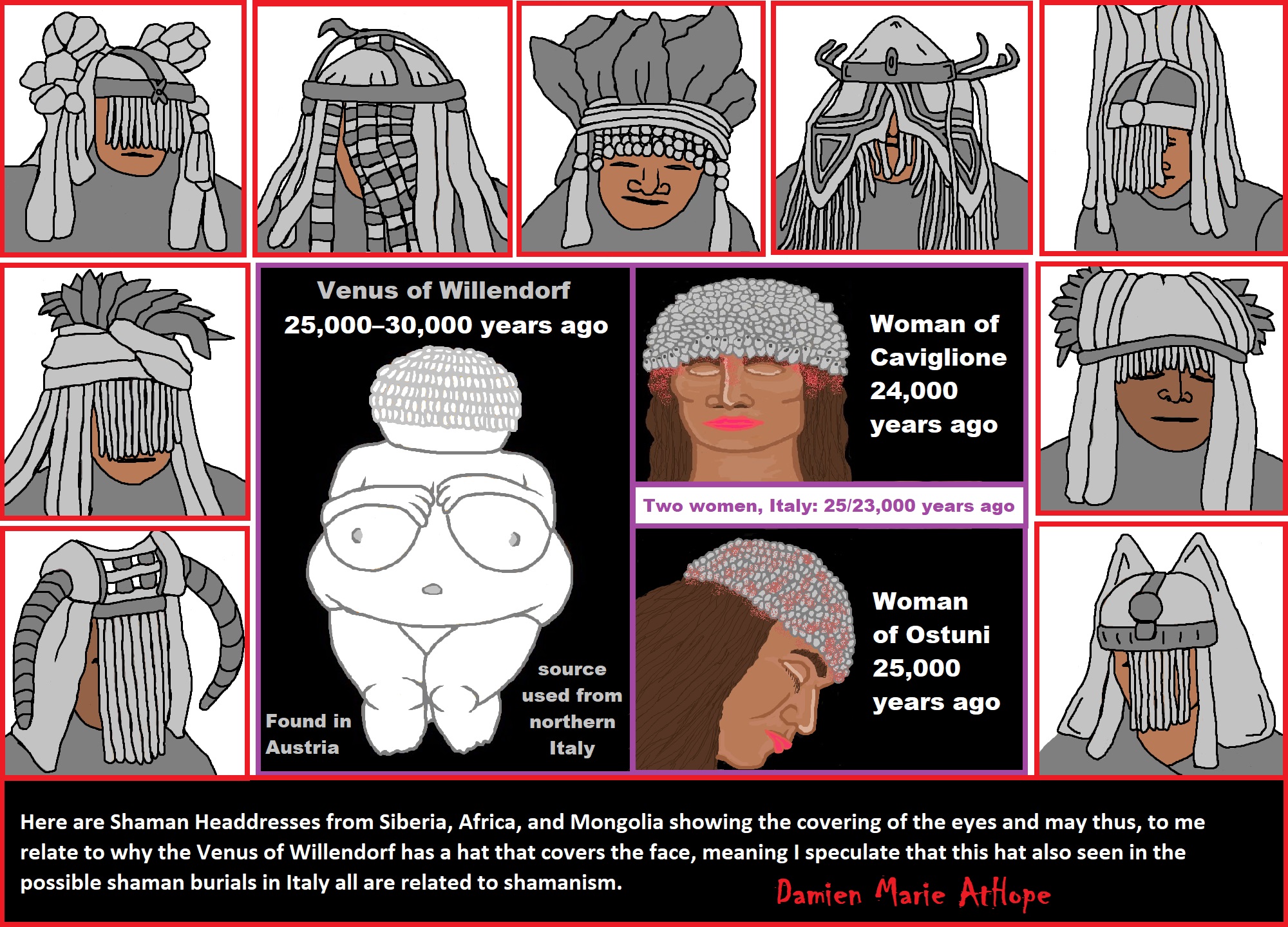
ref, ref, ref, ref, ref, ref, ref, ref, ref, ref, ref, ref, ref, ref, ref
Here are Shaman Headdresses from Siberia, Africa, and Mongolia showing the covering of the eyes and may thus, to me relate to why the Venus of Willendorf has a hat that covers the face, meaning I speculate that this hat, also seen in the possible shaman burials in Italy all are related to shamanism.
“Venus figurines have been unearthed in Europe, Siberia, and much of Eurasia.
Most date from the Gravettian period but start in the Aurignacian era, and lasts to the Magdalenian time.” ref
Venus of Willendorf: Shamanism Headdresses that Cover the Eyes?
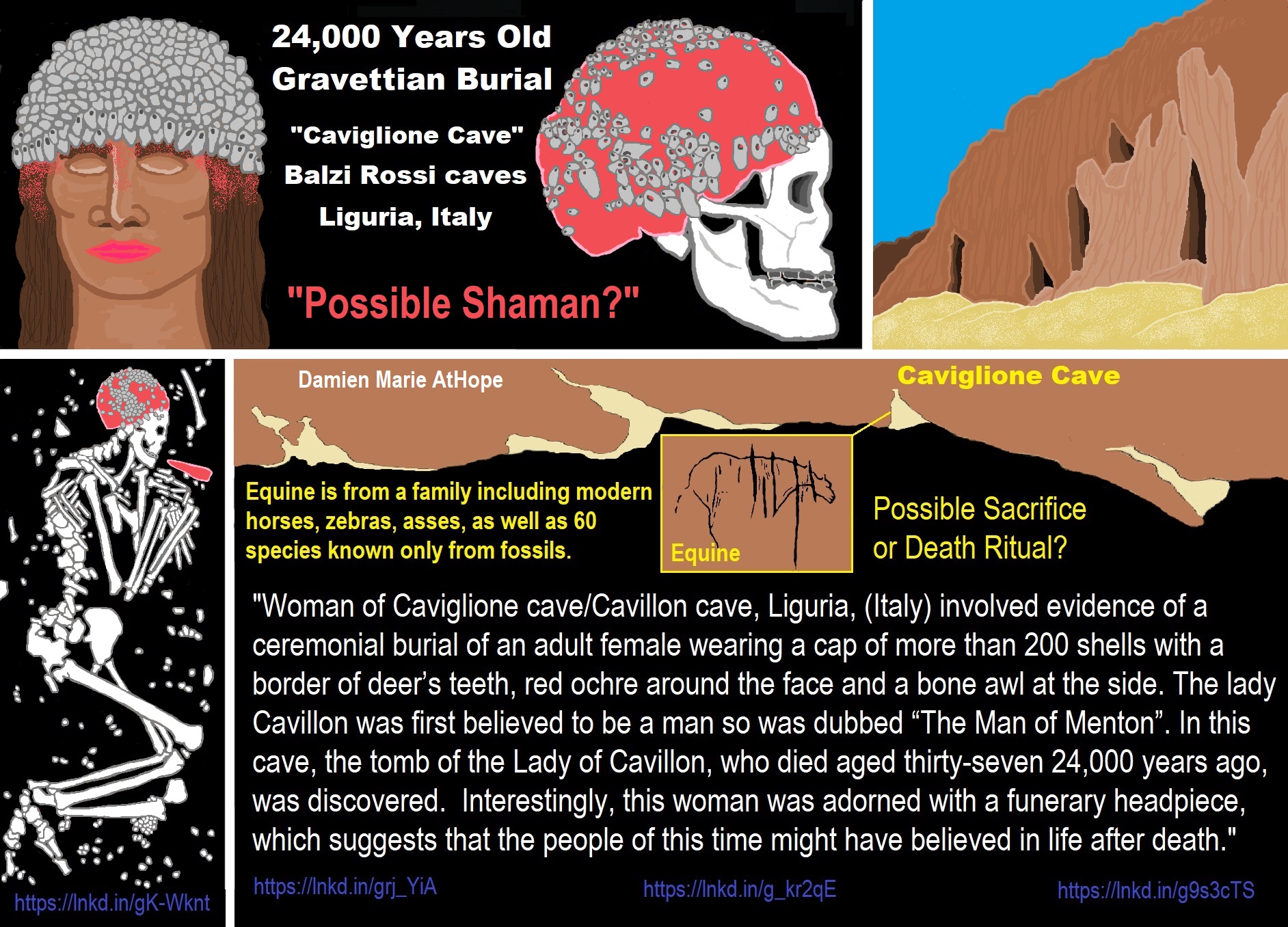
“Woman of Caviglione cave/Cavillon cave, Liguria, (Italy) involved evidence of a ceremonial burial of an adult female wearing a cap of more than 200 shells with a border of deer’s teeth, red ochre around the face and a bone awl at the side. The lady Cavillon was first believed to be a man so was dubbed “The Man of Menton”. In this cave, the tomb of the Lady of Cavillon, who died aged thirty-seven 24,000 years ago, was discovered. Interestingly, this woman was adorned with a funerary headpiece, which suggests that the people of this time might have believed in life after death.” Ref, Ref, Ref, Ref
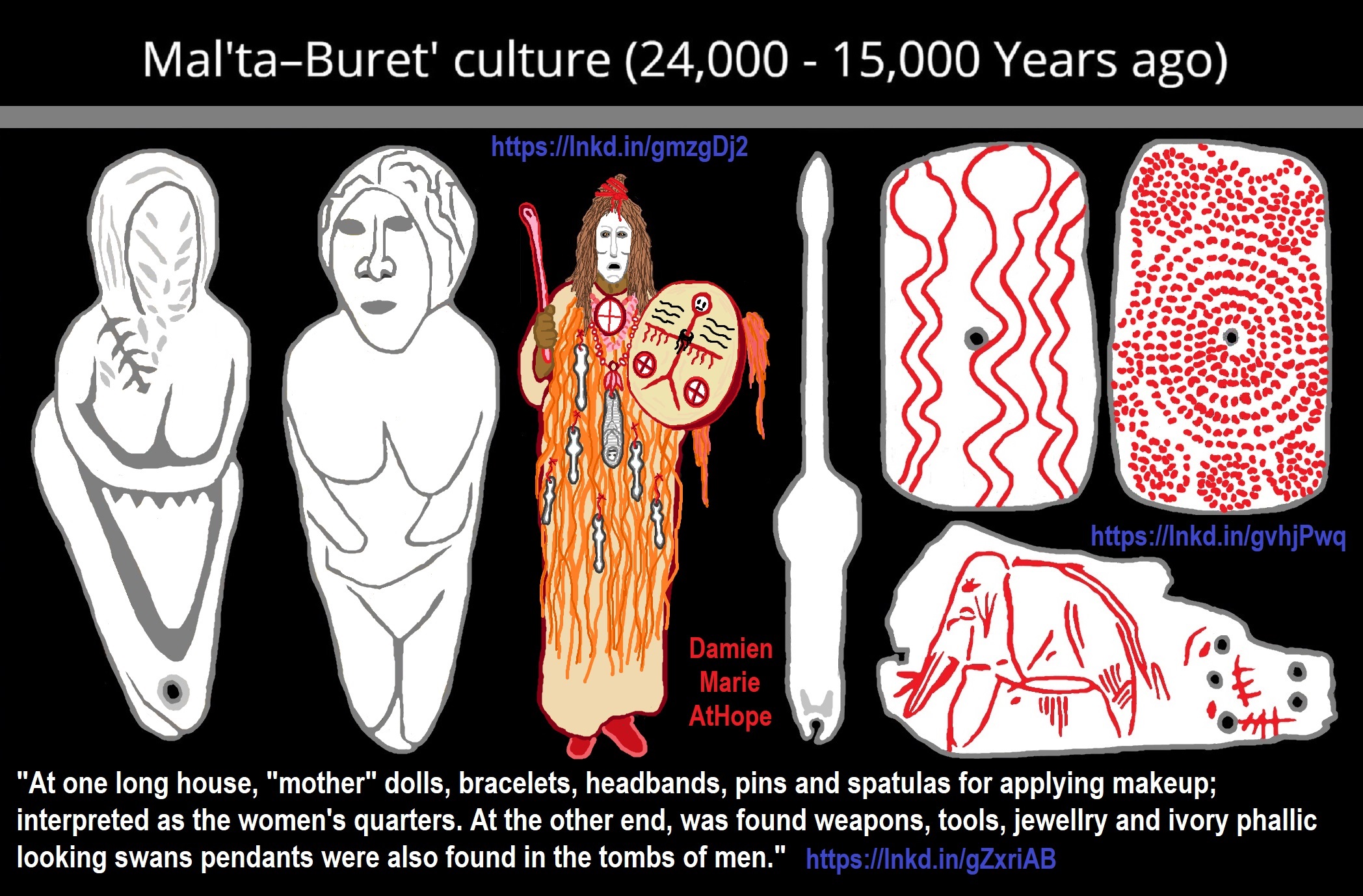


Ancient North Eurasian (ANE)
Ancient Beringian/Ancestral Native American (AB/ANA)
Eastern Hunter-Gatherer (EHG)
Western Hunter-Gatherers (WHG)
Western Steppe Herders (WSH)
Scandinavian Hunter-Gatherer (SHG)
Early European Farmers (EEF)
Jōmon people (Ainu people OF Hokkaido Island)
Neolithic Iranian farmers (Iran_N) (Iran Neolithic)
Haplogroup R possible time of origin about 27,000 years in Central Asia, South Asia, or Siberia:
- Mal’ta–Buret’ culture (24,000-15,000 years ago)
- Afontova Gora culture (21,000-12,000 years ago)
- Trialetian culture (16,000–8000 years ago)
- Samara culture (7,000-6,500 years ago)
- Khvalynsk culture (7,000-6,500 years ago)
- Afanasievo culture (5,300-4,500 years ago)
- Yamna/Yamnaya Culture (5,300-4,500 years ago)
- Andronovo culture (4,000–2,900 years ago) ref
Groups partially derived from the Ancient North Eurasians
“The ANE lineage is defined by association with the MA-1, or “Mal’ta boy”, remains of 24,000 years ago in central Siberia Mal’ta-Buret’ culture 24,000-15,000 years ago. The Ancient North Eurasians (ANE) samples (Afontova Gora 3, Mal’ta 1, and Yana-RHS) show evidence for minor gene flow from an East Asian-related group (simplified by the Amis, Han, or Tianyuan) but no evidence for ANE-related geneflow into East Asians (Amis, Han, Tianyuan), except the Ainu, of North Japan.” ref
“The ANE lineage is defined by association with the MA-1, or “Mal’ta boy”, remains of 24,000 years ago in central Siberia Mal’ta-Buret’ culture 24,000-15,000 years ago “basal to modern-day Europeans”. Some Ancient North Eurasians also carried East Asian populations, such as Tianyuan Man.” ref
“Bronze-age-steppe Yamnaya and Afanasevo cultures were ANE at around 50% and Eastern Hunter-Gatherer (EHG) at around 75% ANE. Karelia culture: Y-DNA R1a-M417 8,400 years ago, Y-DNA J, 7,200 years ago, and Samara, of Y-haplogroup R1b-P297 7,600 years ago is closely related to ANE from Afontova Gora, 18,000 years ago around the time of blond hair first seen there.” ref
Ancient North Eurasian
“In archaeogenetics, the term Ancient North Eurasian (often abbreviated as ANE) is the name given to an ancestral West Eurasian component that represents descent from the people similar to the Mal’ta–Buret’ culture and populations closely related to them, such as from Afontova Gora and the Yana Rhinoceros Horn Site. Significant ANE ancestry are found in some modern populations, including Europeans and Native Americans.” ref
“The ANE lineage is defined by association with the MA-1, or “Mal’ta boy“, the remains of an individual who lived during the Last Glacial Maximum, 24,000 years ago in central Siberia, Ancient North Eurasians are described as a lineage “which is deeply related to Paleolithic/Mesolithic hunter-gatherers in Europe,” meaning that they diverged from Paleolithic Europeans a long time ago.” ref
“The ANE population has also been described as having been “basal to modern-day Europeans” but not especially related to East Asians, and is suggested to have perhaps originated in Europe or Western Asia or the Eurasian Steppe of Central Asia. However, some samples associated with Ancient North Eurasians also carried ancestry from an ancient East Asian population, such as Tianyuan Man. Sikora et al. (2019) found that the Yana RHS sample (31,600 BP) in Northern Siberia “can be modeled as early West Eurasian with an approximately 22% contribution from early East Asians.” ref
“Populations genetically similar to MA-1 were an important genetic contributor to Native Americans, Europeans, Central Asians, South Asians, and some East Asian groups, in order of significance. Lazaridis et al. (2016:10) note “a cline of ANE ancestry across the east-west extent of Eurasia.” The ancient Bronze-age-steppe Yamnaya and Afanasevo cultures were found to have a noteworthy ANE component at ~50%.” ref
“According to Moreno-Mayar et al. 2018 between 14% and 38% of Native American ancestry may originate from gene flow from the Mal’ta–Buret’ people (ANE). This difference is caused by the penetration of posterior Siberian migrations into the Americas, with the lowest percentages of ANE ancestry found in Eskimos and Alaskan Natives, as these groups are the result of migrations into the Americas roughly 5,000 years ago.” ref
“Estimates for ANE ancestry among first wave Native Americans show higher percentages, such as 42% for those belonging to the Andean region in South America. The other gene flow in Native Americans (the remainder of their ancestry) was of East Asian origin. Gene sequencing of another south-central Siberian people (Afontova Gora-2) dating to approximately 17,000 years ago, revealed similar autosomal genetic signatures to that of Mal’ta boy-1, suggesting that the region was continuously occupied by humans throughout the Last Glacial Maximum.” ref
“The earliest known individual with a genetic mutation associated with blonde hair in modern Europeans is an Ancient North Eurasian female dating to around 16000 BCE from the Afontova Gora 3 site in Siberia. It has been suggested that their mythology may have included a narrative, found in both Indo-European and some Native American fables, in which a dog guards the path to the afterlife.” ref
“Genomic studies also indicate that the ANE component was introduced to Western Europe by people related to the Yamnaya culture, long after the Paleolithic. It is reported in modern-day Europeans (7%–25%), but not of Europeans before the Bronze Age. Additional ANE ancestry is found in European populations through paleolithic interactions with Eastern Hunter-Gatherers, which resulted in populations such as Scandinavian Hunter-Gatherers.” ref
“The Ancient North Eurasians (ANE) split from the ancestors of European peoples somewhere in the Middle East or South-central Asia, and used a northern dispersal route through Central Asia into Northern Asia and Siberia. Genetic analyses show that all ANE samples (Afontova Gora 3, Mal’ta 1, and Yana-RHS) show evidence for minor gene flow from an East Asian-related group (simplified by the Amis, Han, or Tianyuan). In contrast, no evidence for ANE-related geneflow into East Asians (Amis, Han, Tianyuan), except the Ainu, was found.” ref
“Genetic data suggests that the ANE formed during the Terminal Upper-Paleolithic (36+-1,5ka) period from a deeply European-related population, which was once widespread in Northern Eurasia, and from an early East Asian-related group, which migrated northwards into Central Asia and Siberia, merging with this deeply European-related population. These population dynamics and constant northwards geneflow of East Asian-related ancestry would later gave rise to the “Ancestral Native Americans” and Paleosiberians, which replaced the ANE as dominant population of Siberia.” ref
Groups partially derived from the Ancient North Eurasians
“Eastern Hunter-Gatherer (EHG) is a lineage derived predominantly (75%) from ANE. It is represented by two individuals from Karelia, one of Y-haplogroup R1a-M417, dated c. 8.4 kya, the other of Y-haplogroup J, dated c. 7.2 kya; and one individual from Samara, of Y-haplogroup R1b-P297, dated c. 7.6 kya. This lineage is closely related to the ANE sample from Afontova Gora, dated c. 18 kya. After the end of the Last Glacial Maximum, the Western Hunter-Gatherers (WHG) and EHG lineages merged in Eastern Europe, accounting for early presence of ANE-derived ancestry in Mesolithic Europe. Evidence suggests that as Ancient North Eurasians migrated West from Eastern Siberia, they absorbed Western Hunter-Gatherers and other West Eurasian populations as well.” ref
“Caucasian Hunter-Gatherer (CHG) is represented by the Satsurblia individual dated ~13 kya (from the Satsurblia cave in Georgia), and carried 36% ANE-derived admixture. While the rest of their ancestry is derived from the Dzudzuana cave individual dated ~26 kya, which lacked ANE-admixture, Dzudzuana affinity in the Caucasus decreased with the arrival of ANE at ~13 kya Satsurblia.” ref
“Scandinavian Hunter-Gatherer (SHG) is represented by several individuals buried at Motala, Sweden ca. 6000 BC. They were descended from Western Hunter-Gatherers who initially settled Scandinavia from the south, and later populations of EHG who entered Scandinavia from the north through the coast of Norway.” ref
“Iran Neolithic (Iran_N) individuals dated ~8.5 kya carried 50% ANE-derived admixture and 50% Dzudzuana-related admixture, marking them as different from other Near-Eastern and Anatolian Neolithics who didn’t have ANE admixture. Iran Neolithics were later replaced by Iran Chalcolithics, who were a mixture of Iran Neolithic and Near Eastern Levant Neolithic.” ref
“Ancient Beringian/Ancestral Native American are specific archaeogenetic lineages, based on the genome of an infant found at the Upward Sun River site (dubbed USR1), dated to 11,500 years ago. The AB lineage diverged from the Ancestral Native American (ANA) lineage about 20,000 years ago.” ref
“West Siberian Hunter-Gatherer (WSHG) are a specific archaeogenetic lineage, first reported in a genetic study published in Science in September 2019. WSGs were found to be of about 30% EHG ancestry, 50% ANE ancestry, and 20% to 38% East Asian ancestry.” ref
“Western Steppe Herders (WSH) is the name given to a distinct ancestral component that represents descent closely related to the Yamnaya culture of the Pontic–Caspian steppe. This ancestry is often referred to as Yamnaya ancestry or Steppe ancestry.” ref
“Late Upper Paeolithic Lake Baikal – Ust’Kyakhta-3 (UKY) 14,050-13,770 BP were mixture of 30% ANE ancestry and 70% East Asian ancestry.” ref
“Lake Baikal Holocene – Baikal Eneolithic (Baikal_EN) and Baikal Early Bronze Age (Baikal_EBA) derived 6.4% to 20.1% ancestry from ANE, while rest of their ancestry was derived from East Asians. Fofonovo_EN near by Lake Baikal were mixture of 12-17% ANE ancestry and 83-87% East Asian ancestry.” ref
“Hokkaido Jōmon people specifically refers to the Jōmon period population of Hokkaido in northernmost Japan. Though the Jōmon people themselves descended mainly from East Asian lineages, one study found an affinity between Hokkaido Jōmon with the Northern Eurasian Yana sample (an ANE-related group, related to Mal’ta), and suggest as an explanation the possibility of minor Yana gene flow into the Hokkaido Jōmon population (as well as other possibilities). A more recent study by Cooke et al. 2021, confirmed ANE-related geneflow among the Jōmon people, partially ancestral to the Ainu people. ANE ancestry among Jōmon people is estimated at 21%, however, there is a North to South cline within the Japanese archipelago, with the highest amount of ANE ancestry in Hokkaido and Tohoku.” ref
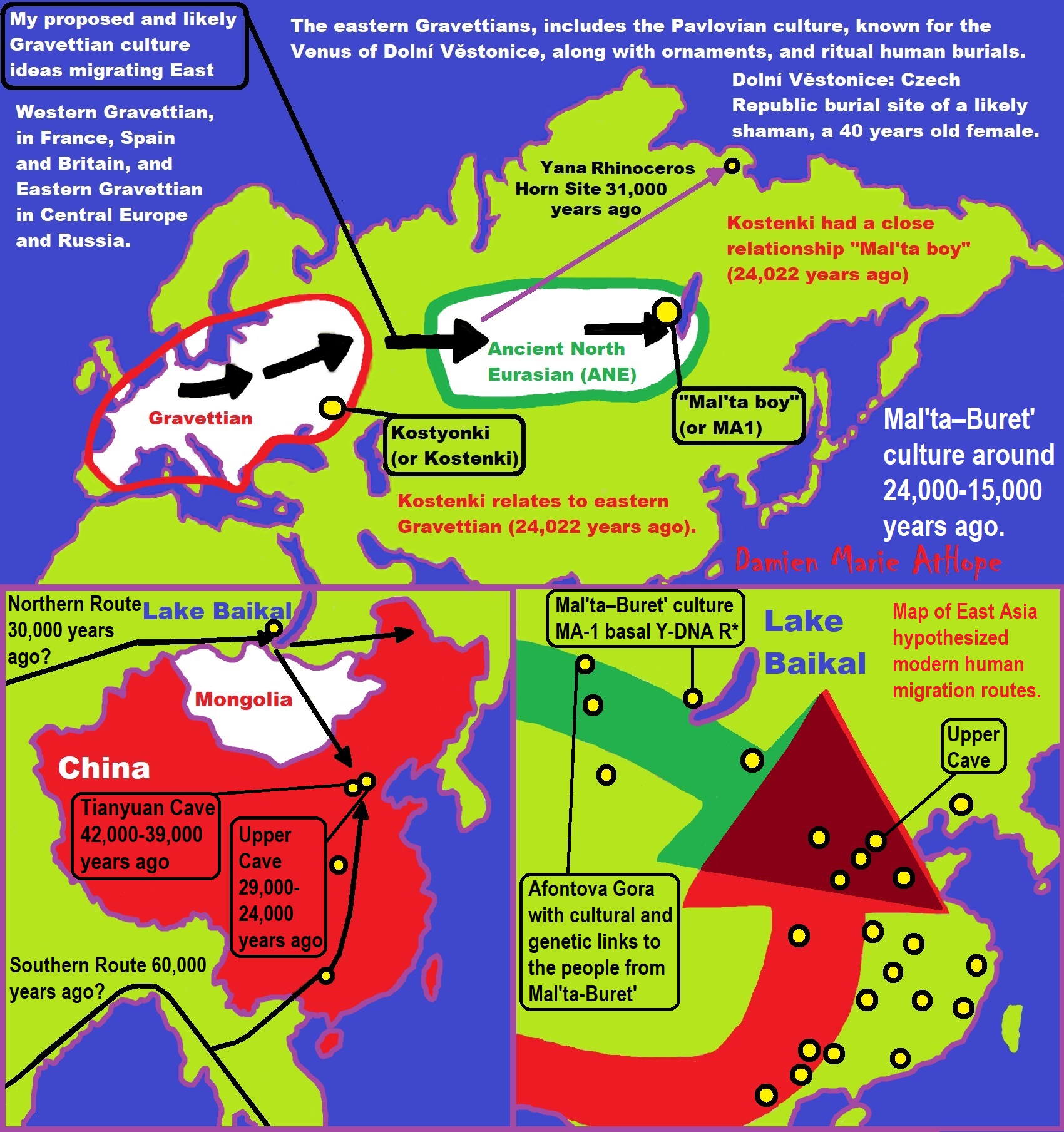
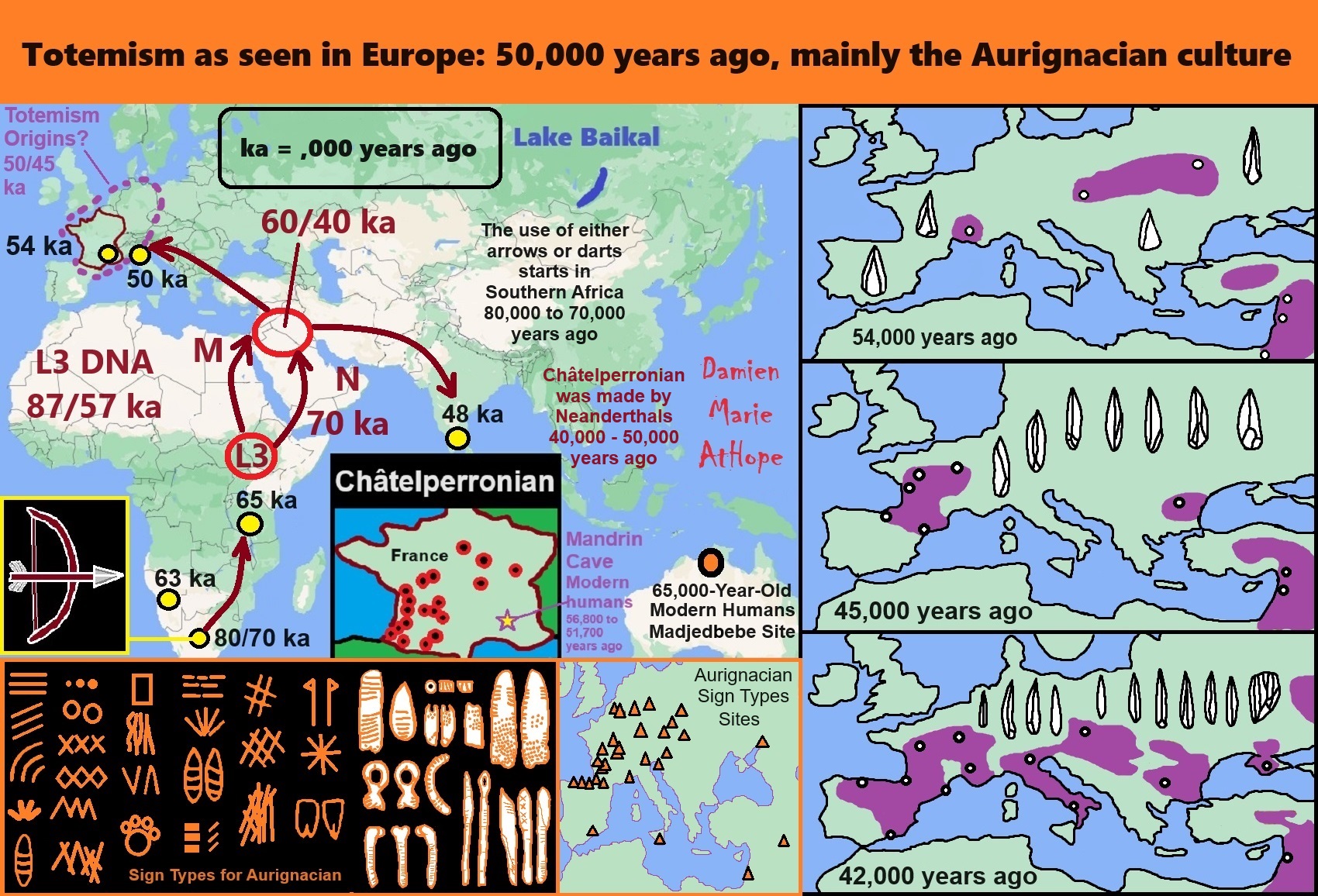
ref, ref, ref, ref, ref, ref, ref, ref, ref, ref, ref, ref, ref, ref, ref, ref, ref, ref, ref, ref, ref, ref, ref
This is my thoughts/speculations on the origins of Totemism
Totemism as seen in Europe: 50,000 years ago, mainly the Aurignacian culture
- Pre-Aurignacian “Châtelperronian” (Western Europe, mainly Spain and France, possible transitional/cultural diffusion between Neanderthals and humans around 50,000-40,000 years ago)
- Archaic–Aurignacian/Proto-Aurignacian (Europe around 46,000-35,000)
- Aurignacian “classical/early to late” (Europe and other areas around 38,000 – 26,000 years ago)
“In the realm of culture, the archeological evidence also supports a Neandertal contribution to Europe’s earliest modern human societies, which feature personal ornaments completely unknown before immigration and are characteristic of such Neandertal-associated archeological entities as the Chatelperronian and the Uluzzian.” – (PDF) Neandertals and Moderns Mixed, and It Matters: Link
Totemism as seen in Europe: 50,000 years ago, mainly the Aurignacian culture

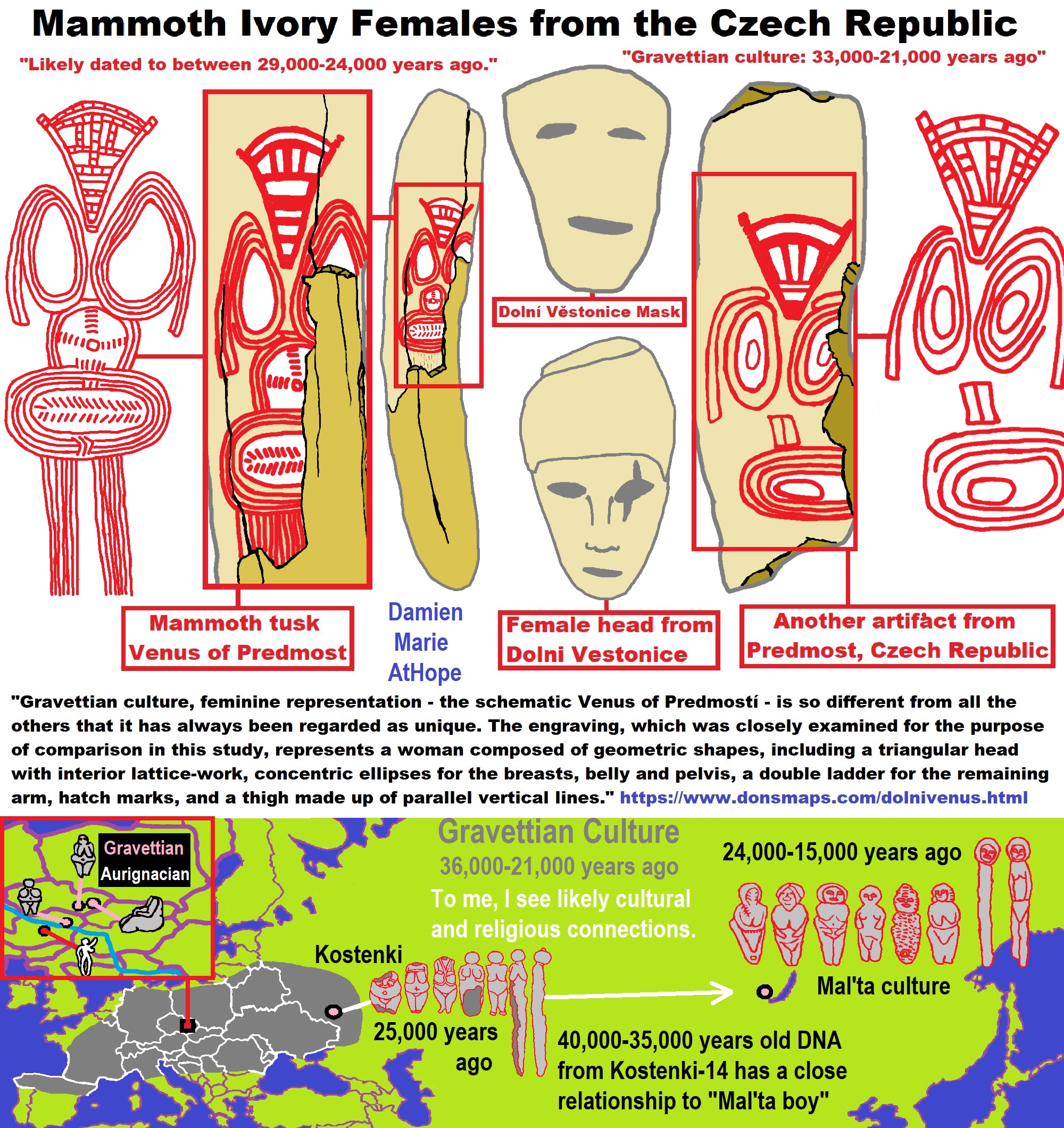
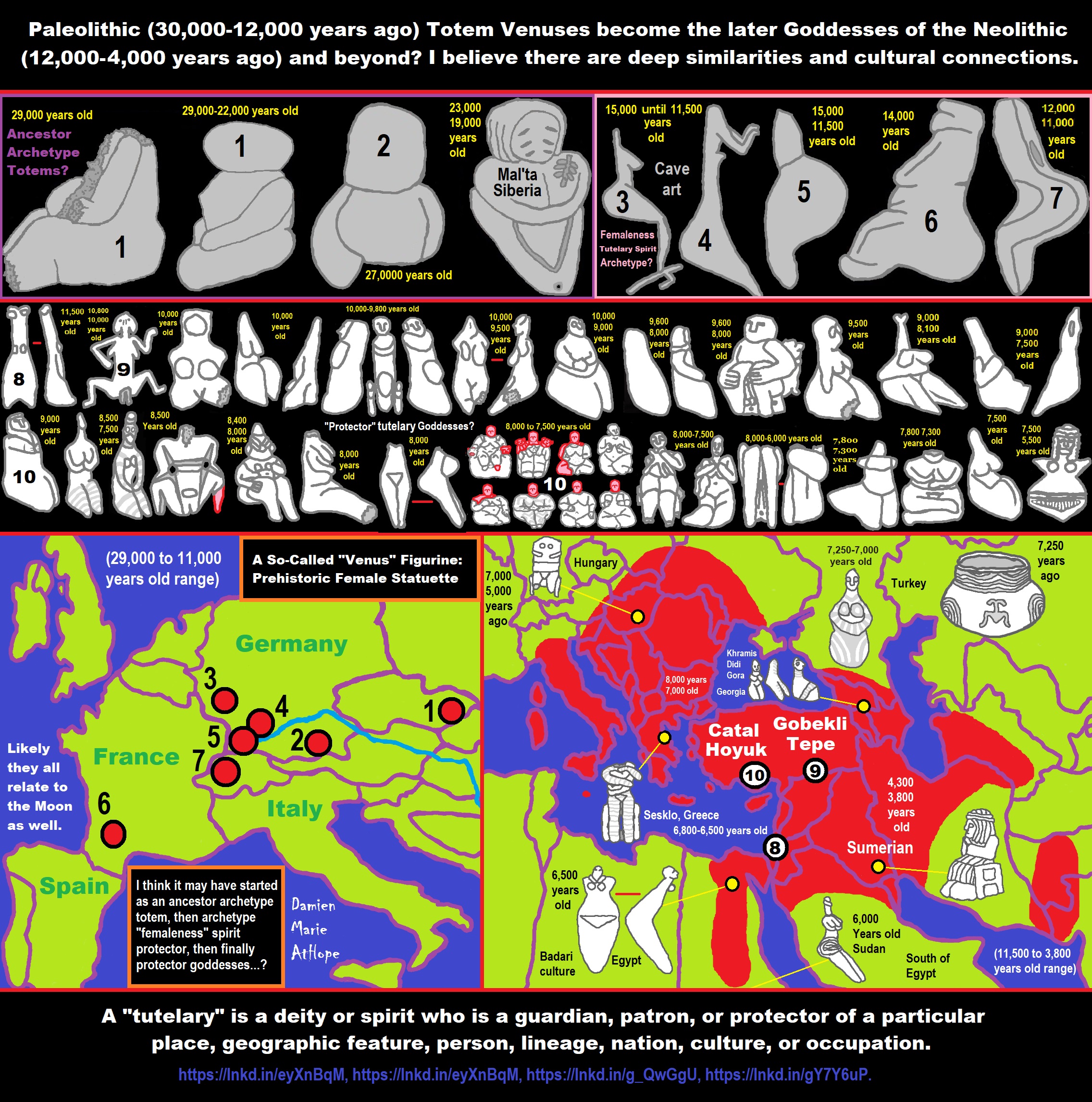
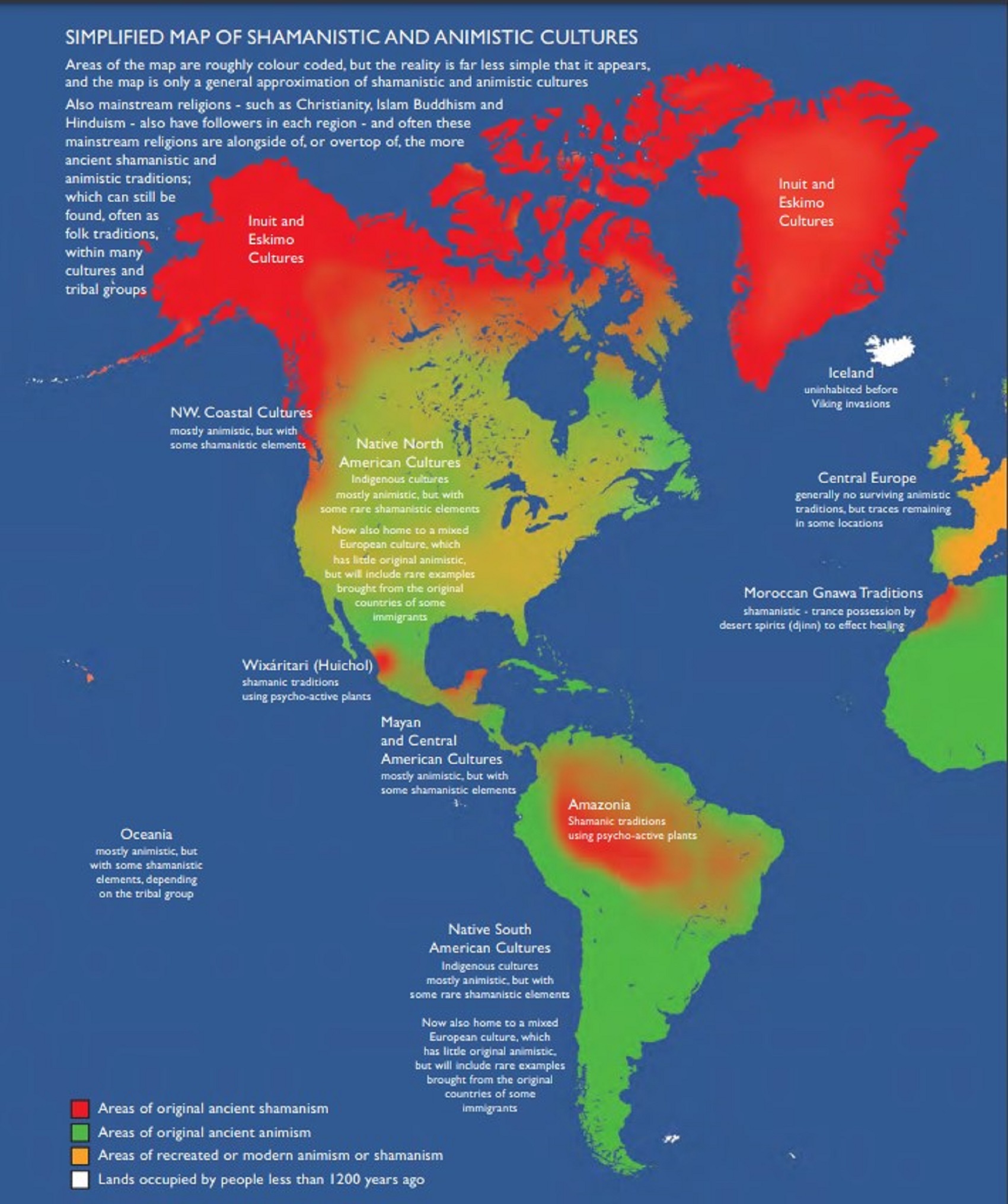
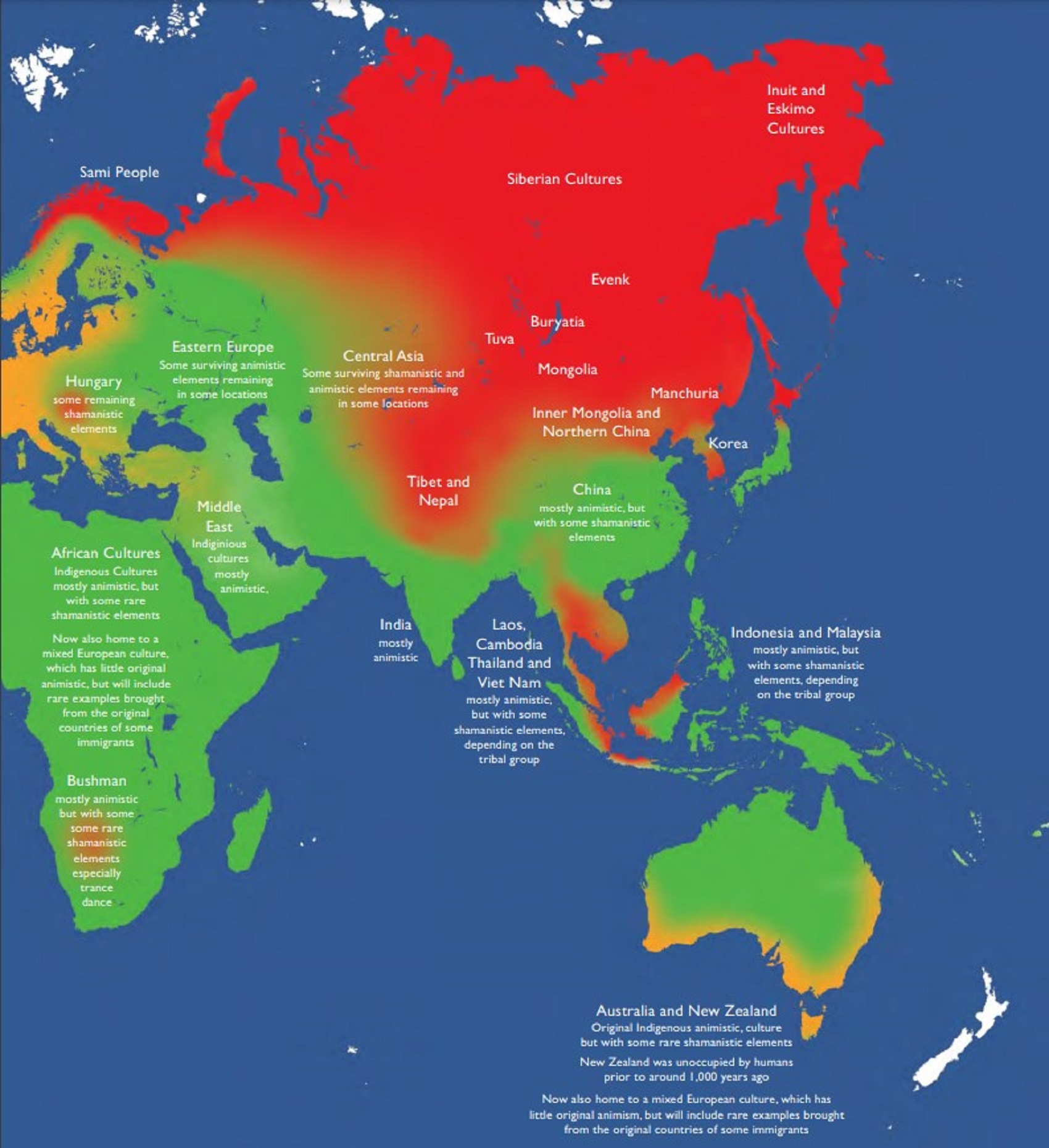
Shamanistic and Animistic Cultures map by “The Shamanism Magazine” (http://SacredHoop.org)
https://sacredhoop.org/Free-Guide-To-Shamanism/Sacred-Hoop-Free-Guide-To-Shamanism.pdf
People don’t commonly teach religious history, even that of their own claimed religion. No, rather they teach a limited “pro their religion” history of their religion from a religious perspective favorable to the religion of choice.

Do you truly think “Religious Belief” is only a matter of some personal choice?
Do you not see how coercive one’s world of choice is limited to the obvious hereditary belief, in most religious choices available to the child of religious parents or caregivers? Religion is more commonly like a family, culture, society, etc. available belief that limits the belief choices of the child and that is when “Religious Belief” is not only a matter of some personal choice and when it becomes hereditary faith, not because of the quality of its alleged facts or proposed truths but because everyone else important to the child believes similarly so they do as well simply mimicking authority beliefs handed to them. Because children are raised in religion rather than being presented all possible choices but rather one limited dogmatic brand of “Religious Belief” where children only have a choice of following the belief as instructed, and then personally claim the faith hereditary belief seen in the confirming to the belief they have held themselves all their lives. This is obvious in statements asked and answered by children claiming a faith they barely understand but they do understand that their family believes “this or that” faith, so they feel obligated to believe it too. While I do agree that “Religious Belief” should only be a matter of some personal choice, it rarely is… End Hereditary Religion!
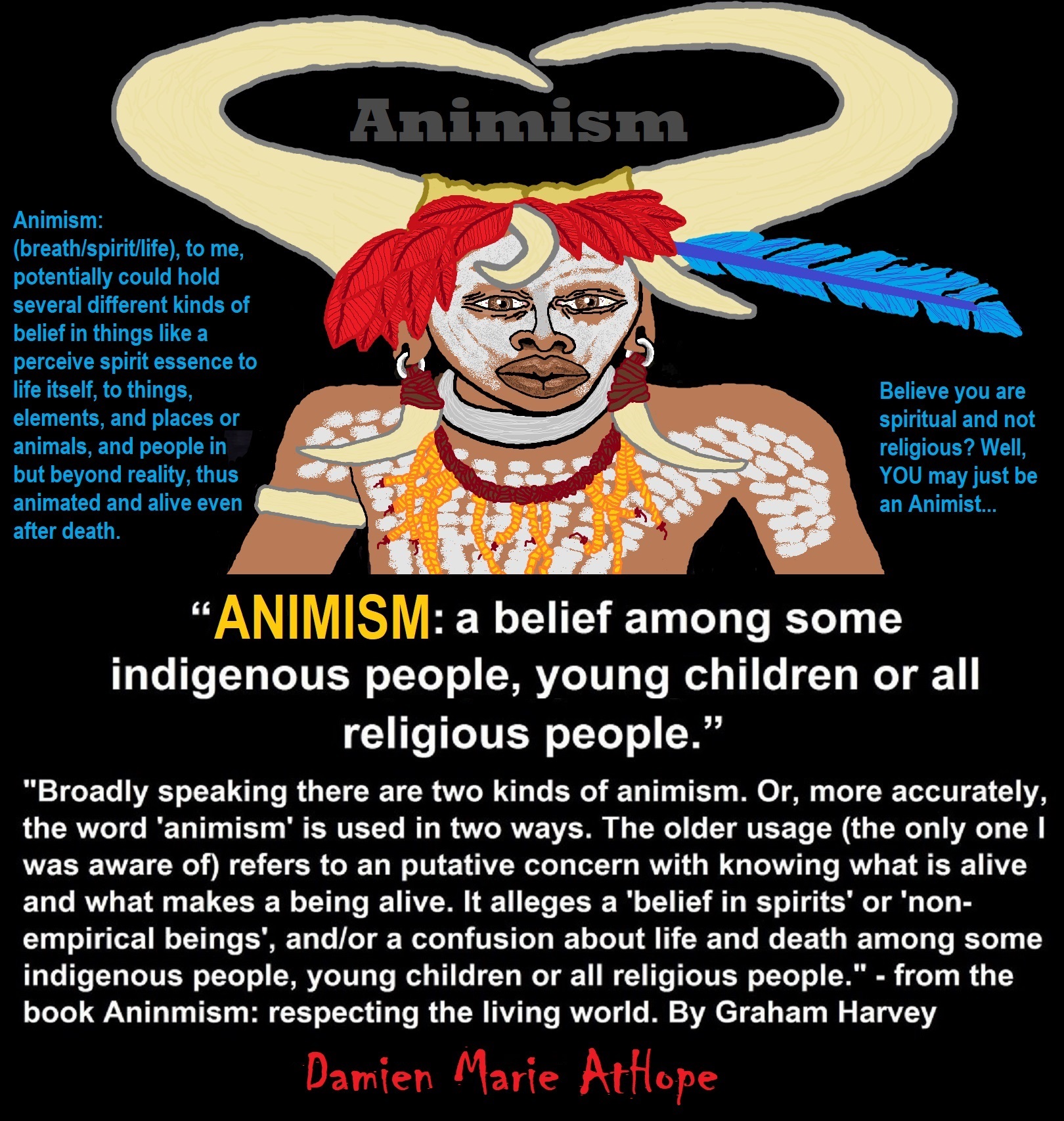
Animism: Respecting the Living World by Graham Harvey
“How have human cultures engaged with and thought about animals, plants, rocks, clouds, and other elements in their natural surroundings? Do animals and other natural objects have a spirit or soul? What is their relationship to humans? In this new study, Graham Harvey explores current and past animistic beliefs and practices of Native Americans, Maori, Aboriginal Australians, and eco-pagans. He considers the varieties of animism found in these cultures as well as their shared desire to live respectfully within larger natural communities. Drawing on his extensive casework, Harvey also considers the linguistic, performative, ecological, and activist implications of these different animisms.” ref

We are like believing machines we vacuum up ideas, like Velcro sticks to almost everything. We accumulate beliefs that we allow to negatively influence our lives, often without realizing it. Our willingness must be to alter skewed beliefs that impend our balance or reason, which allows us to achieve new positive thinking and accurate outcomes.

My thoughts on Religion Evolution with external links for more info:
- (Pre-Animism Africa mainly, but also Europe, and Asia at least 300,000 years ago), (Pre-Animism – Oxford Dictionaries)
- (Animism Africa around 100,000 years ago), (Animism – Britannica.com)
- (Totemism Europe around 50,000 years ago), (Totemism – Anthropology)
- (Shamanism Siberia around 30,000 years ago), (Shamanism – Britannica.com)
- (Paganism Turkey around 12,000 years ago), (Paganism – BBC Religion)
- (Progressed Organized Religion “Institutional Religion” Egypt around 5,000 years ago), (Ancient Egyptian Religion – Britannica.com)
- (CURRENT “World” RELIGIONS after 4,000 years ago) (Origin of Major Religions – Sacred Texts)
- (Early Atheistic Doubting at least by 2,600 years ago) (History of Atheism – Wikipedia)
“Religion is an Evolved Product” and Yes, Religion is Like Fear Given Wings…
Atheists talk about gods and religions for the same reason doctors talk about cancer, they are looking for a cure, or a firefighter talks about fires because they burn people and they care to stop them. We atheists too often feel a need to help the victims of mental slavery, held in the bondage that is the false beliefs of gods and the conspiracy theories of reality found in religions.
Understanding Religion Evolution:
- Pre-Animism (at least 300,000 years ago)
- Animism (Africa: 100,000 years ago)
- Totemism (Europe: 50,000 years ago)
- Shamanism (Siberia: 30,000 years ago)
- Paganism (Turkey: 12,000 years ago)
- Progressed organized religion (Egypt: 5,000 years ago), (Egypt, the First Dynasty 5,150 years ago)
- CURRENT “World” RELIGIONS (after 4,000 years ago)
- Early Atheistic Doubting (at least by 2,600 years ago)
“An Archaeological/Anthropological Understanding of Religion Evolution”
It seems ancient peoples had to survived amazing threats in a “dangerous universe (by superstition perceived as good and evil),” and human “immorality or imperfection of the soul” which was thought to affect the still living, leading to ancestor worship. This ancestor worship presumably led to the belief in supernatural beings, and then some of these were turned into the belief in gods. This feeble myth called gods were just a human conceived “made from nothing into something over and over, changing, again and again, taking on more as they evolve, all the while they are thought to be special,” but it is just supernatural animistic spirit-belief perceived as sacred.
Quick Evolution of Religion?
Pre-Animism (at least 300,000 years ago) pre-religion is a beginning that evolves into later Animism. So, Religion as we think of it, to me, all starts in a general way with Animism (Africa: 100,000 years ago) (theoretical belief in supernatural powers/spirits), then this is physically expressed in or with Totemism (Europe: 50,000 years ago) (theoretical belief in mythical relationship with powers/spirits through a totem item), which then enlists a full-time specific person to do this worship and believed interacting Shamanism (Siberia/Russia: 30,000 years ago) (theoretical belief in access and influence with spirits through ritual), and then there is the further employment of myths and gods added to all the above giving you Paganism (Turkey: 12,000 years ago) (often a lot more nature-based than most current top world religions, thus hinting to their close link to more ancient religious thinking it stems from). My hypothesis is expressed with an explanation of the building of a theatrical house (modern religions development). Progressed organized religion (Egypt: 5,000 years ago) with CURRENT “World” RELIGIONS (after 4,000 years ago).
Historically, in large city-state societies (such as Egypt or Iraq) starting around 5,000 years ago culminated to make religion something kind of new, a sociocultural-governmental-religious monarchy, where all or at least many of the people of such large city-state societies seem familiar with and committed to the existence of “religion” as the integrated life identity package of control dynamics with a fixed closed magical doctrine, but this juggernaut integrated religion identity package of Dogmatic-Propaganda certainly did not exist or if developed to an extent it was highly limited in most smaller prehistoric societies as they seem to lack most of the strong control dynamics with a fixed closed magical doctrine (magical beliefs could be at times be added or removed). Many people just want to see developed religious dynamics everywhere even if it is not. Instead, all that is found is largely fragments until the domestication of religion.
Religions, as we think of them today, are a new fad, even if they go back to around 6,000 years in the timeline of human existence, this amounts to almost nothing when seen in the long slow evolution of religion at least around 70,000 years ago with one of the oldest ritual worship. Stone Snake of South Africa: “first human worship” 70,000 years ago. This message of how religion and gods among them are clearly a man-made thing that was developed slowly as it was invented and then implemented peace by peace discrediting them all. Which seems to be a simple point some are just not grasping how devastating to any claims of truth when we can see the lie clearly in the archeological sites.
I wish people fought as hard for the actual values as they fight for the group/clan names political or otherwise they think support values. Every amount spent on war is theft to children in need of food or the homeless kept from shelter.
Here are several of my blog posts on history:
- To Find Truth You Must First Look
- (Magdalenian/Iberomaurusian) Connections to the First Paganists of the early Neolithic Near East Dating from around 17,000 to 12,000 Years Ago
- Natufians: an Ancient People at the Origins of Agriculture and Sedentary Life
- Possible Clan Leader/Special “MALE” Ancestor Totem Poles At Least 13,500 years ago?
- Jewish People with DNA at least 13,200 years old, Judaism, and the Origins of Some of its Ideas
- Baltic Reindeer Hunters: Swiderian, Lyngby, Ahrensburgian, and Krasnosillya cultures 12,020 to 11,020 years ago are evidence of powerful migratory waves during the last 13,000 years and a genetic link to Saami and the Finno-Ugric peoples.
- The Rise of Inequality: patriarchy and state hierarchy inequality
- Fertile Crescent 12,500 – 9,500 Years Ago: fertility and death cult belief system?
- 12,400 – 11,700 Years Ago – Kortik Tepe (Turkey) Pre/early-Agriculture Cultic Ritualism
- Ritualistic Bird Symbolism at Gobekli Tepe and its “Ancestor Cult”
- Male-Homosexual (female-like) / Trans-woman (female) Seated Figurine from Gobekli Tepe
- Could a 12,000-year-old Bull Geoglyph at Göbekli Tepe relate to older Bull and Female Art 25,000 years ago and Later Goddess and the Bull cults like Catal Huyuk?
- Sedentism and the Creation of goddesses around 12,000 years ago as well as male gods after 7,000 years ago.
- Alcohol, where Agriculture and Religion Become one? Such as Gobekli Tepe’s Ritualistic use of Grain as Food and Ritual Drink
- Neolithic Ritual Sites with T-Pillars and other Cultic Pillars
- Paganism: Goddesses around 12,000 years ago then Male Gods after 7,000 years ago
- First Patriarchy: Split of Women’s Status around 12,000 years ago & First Hierarchy: fall of Women’s Status around 5,000 years ago.
- Natufians: an Ancient People at the Origins of Agriculture and Sedentary Life
- J DNA and the Spread of Agricultural Religion (paganism)
- Paganism: an approximately 12,000-year-old belief system
- Paganism 12,000 years old: related to “Anarchism and Socialism” (Pre-Capitalism)
- Shaman burial in Israel 12,000 years ago and the Shamanism Phenomena
- Need to Mythicized: gods and goddesses
- 12,000 – 7,000 Years Ago – Paleo-Indian Culture (The Americas)
- 12,000 – 2,000 Years Ago – Indigenous-Scandinavians (Nordic)
- Norse did not wear helmets with horns?
- Pre-Pottery Neolithic Skull Cult around 11,500 to 8,400 Years Ago?
- 10,400 – 10,100 Years Ago, in Turkey the Nevail Cori Religious Settlement
- 9,000-6,500 Years Old Submerged Pre-Pottery/Pottery Neolithic Ritual Settlements off Israel’s Coast
- Catal Huyuk “first religious designed city” around 9,500 to 7,700 years ago (Turkey)
- Cultic Hunting at Catal Huyuk “first religious designed city”
- Special Items and Art as well as Special Elite Burials at Catal Huyuk
- New Rituals and Violence with the appearance of Pottery and People?
- Haplogroup N and its related Uralic Languages and Cultures
- Ainu people, Sámi people, Native Americans, the Ancient North Eurasians, and Paganistic-Shamanism with Totemism
- Ideas, Technology and People from Turkey, Europe, to China and Back again 9,000 to 5,000 years ago?
- First Pottery of Europe and the Related Cultures
- 9,000 years old Neolithic Artifacts Judean Desert and Hills Israel
- 9,000-7,000 years-old Sex and Death Rituals: Cult Sites in Israel, Jordan, and the Sinai
- 9,000-8500 year old Horned Female shaman Bad Dürrenberg Germany
- Neolithic Jewelry and the Spread of Farming in Europe Emerging out of West Turkey
- 8,600-year-old Tortoise Shells in Neolithic graves in central China have Early Writing and Shamanism
- Swing of the Mace: the rise of Elite, Forced Authority, and Inequality begin to Emerge 8,500 years ago?
- Migrations and Changing Europeans Beginning around 8,000 Years Ago
- My “Steppe-Anatolian-Kurgan hypothesis” 8,000/7,000 years ago
- Around 8,000-year-old Shared Idea of the Mistress of Animals, “Ritual” Motif
- Pre-Columbian Red-Paint (red ochre) Maritime Archaic Culture 8,000-3,000 years ago
- 7,522-6,522 years ago Linear Pottery culture which I think relates to Arcane Capitalism’s origins
- Arcane Capitalism: Primitive socialism, Primitive capital, Private ownership, Means of production, Market capitalism, Class discrimination, and Petite bourgeoisie (smaller capitalists)
- 7,500-4,750 years old Ritualistic Cucuteni-Trypillian culture of Moldova, Romania, and Ukraine
- Roots of a changing early society 7,200-6,700 years ago Jordan and Israel
- Agriculture religion (Paganism) with farming reached Britain between about 7,000 to 6,500 or so years ago and seemingly expressed in things like Western Europe’s Long Barrows
- My Thoughts on Possible Migrations of “R” DNA and Proto-Indo-European?
- “Millet” Spreading from China 7,022 years ago to Europe and related Language may have Spread with it leading to Proto-Indo-European
- Proto-Indo-European (PIE), ancestor of Indo-European languages: DNA, Society, Language, and Mythology
- The Dnieper–Donets culture and Asian varieties of Millet from China to the Black Sea region of Europe by 7,022 years ago
- Kurgan 6,000 years ago/dolmens 7,000 years ago: funeral, ritual, and other?
- 7,020 to 6,020-year-old Proto-Indo-European Homeland of Urheimat or proposed home of their Language and Religion
- Ancient Megaliths: Kurgan, Ziggurat, Pyramid, Menhir, Trilithon, Dolman, Kromlech, and Kromlech of Trilithons
- The Mytheme of Ancient North Eurasian Sacred-Dog belief and similar motifs are found in Indo-European, Native American, and Siberian comparative mythology
- Elite Power Accumulation: Ancient Trade, Tokens, Writing, Wealth, Merchants, and Priest-Kings
- Sacred Mounds, Mountains, Kurgans, and Pyramids may hold deep connections?
- Between 7,000-5,000 Years ago, rise of unequal hierarchy elite, leading to a “birth of the State” or worship of power, strong new sexism, oppression of non-elites, and the fall of Women’s equal status
- Paganism 7,000-5,000 years old: related to “Anarchism and Socialism” (Capitalism) (World War 0) Elite & their slaves
- Hell and Underworld mythologies starting maybe as far back as 7,000 to 5,000 years ago with the Proto-Indo-Europeans?
- The First Expression of the Male God around 7,000 years ago?
- White (light complexion skin) Bigotry and Sexism started 7,000 years ago?
- Around 7,000-year-old Shared Idea of the Divine Bird (Tutelary and/or Trickster spirit/deity), “Ritual” Motif
- Nekhbet an Ancient Egyptian Vulture Goddess and Tutelary Deity
- 6,720 to 4,920 years old Ritualistic Hongshan Culture of Inner Mongolia with 5,000-year-old Pyramid Mounds and Temples
- First proto-king in the Balkans, Varna culture around 6,500 years ago?
- 6,500–5,800 years ago in Israel Late Chalcolithic (Copper Age) Period in the Southern Levant Seems to Express Northern Levant Migrations, Cultural and Religious Transfer
- KING OF BEASTS: Master of Animals “Ritual” Motif, around 6,000 years old or older…
- Around 6000-year-old Shared Idea of the Solid Wheel & the Spoked Wheel-Shaped Ritual Motif
- “The Ghassulian Star,” a mysterious 6,000-year-old mural from Jordan; a Proto-Star of Ishtar, Star of Inanna or Star of Venus?
- Religious/Ritual Ideas, including goddesses and gods as well as ritual mounds or pyramids from Northeastern Asia at least 6,000 years old, seemingly filtering to Iran, Iraq, the Mediterranean, Europe, Egypt, and the Americas?
- Maykop (5,720–5,020 years ago) Caucasus region Bronze Age culture-related to Copper Age farmers from the south, influenced by the Ubaid period and Leyla-Tepe culture, as well as influencing the Kura-Araxes culture
- 5-600-year-old Tomb, Mummy, and First Bearded Male Figurine in a Grave
- Kura-Araxes Cultural 5,520 to 4,470 years old DNA traces to the Canaanites, Arabs, and Jews
- Minoan/Cretan (Keftiu) Civilization and Religion around 5,520 to 3,120 years ago
- Evolution Of Science at least by 5,500 years ago
- 5,500 Years old birth of the State, the rise of Hierarchy, and the fall of Women’s status
- “Jiroft culture” 5,100 – 4,200 years ago and the History of Iran
- Stonehenge: Paganistic Burial and Astrological Ritual Complex, England (5,100-3,600 years ago)
- Around 5,000-year-old Shared Idea of the “Tree of Life” Ritual Motif
- Complex rituals for elite, seen from China to Egypt, at least by 5,000 years ago
- Around 5,000 years ago: “Birth of the State” where Religion gets Military Power and Influence
- The Center of the World “Axis Mundi” and/or “Sacred Mountains” Mythology Could Relate to the Altai Mountains, Heart of the Steppe
- Progressed organized religion starts, an approximately 5,000-year-old belief system
- China’s Civilization between 5,000-3,000 years ago, was a time of war and class struggle, violent transition from free clans to a Slave or Elite society
- Origin of Logics is Naturalistic Observation at least by around 5,000 years ago.
- Paganism 5,000 years old: progressed organized religion and the state: related to “Anarchism and Socialism” (Kings and the Rise of the State)
- Ziggurats (multi-platform temples: 4,900 years old) to Pyramids (multi-platform tombs: 4,700 years old)
- Did a 4,520–4,420-year-old Volcano In Turkey Inspire the Bible God?
- Finland’s Horned Shaman and Pre-Horned-God at least 4,500 years ago?
- 4,000-year-Old Dolmens in Israel: A Connected Dolmen Religious Phenomenon?
- Creation myths: From chaos, Ex nihilo, Earth-diver, Emergence, World egg, and World parent
- Bronze Age “Ritual” connections of the Bell Beaker culture with the Corded Ware/Single Grave culture, which were related to the Yamnaya culture and Proto-Indo-European Languages/Religions
- Low Gods (Earth/ Tutelary deity), High Gods (Sky/Supreme deity), and Moralistic Gods (Deity enforcement/divine order)
- The exchange of people, ideas, and material-culture including, to me, the new god (Sky Father) and goddess (Earth Mother) religion between the Cucuteni-Trypillians and others which is then spread far and wide
- Koryaks: Indigenous People of the Russian Far East and Big Raven myths also found in Tlingit, Haida, Tsimshian, and other Indigenous People of North America
- 42 Principles Of Maat (Egyptian Goddess of the justice) around 4,400 years ago, 2000 Years Before Ten Commandments
- “Happy Easter” Well Happy Eostre/Ishter
- 4,320-3,820 years old “Shimao” (North China) site with Totemistic-Shamanistic Paganism and a Stepped Pyramid
- 4,250 to 3,400 Year old Stonehenge from Russia: Arkaim?
- 4,100-year-old beaker with medicinal & flowering plants in a grave of a woman in Scotland
- Early European Farmer ancestry, Kelif el Boroud people with the Cardial Ware culture, and the Bell Beaker culture Paganists too, spread into North Africa, then to the Canary Islands off West Africa
- Flood Accounts: Gilgamesh epic (4,100 years ago) Noah in Genesis (2,600 years ago)
- Paganism 4,000 years old: related to “Anarchism and Socialism” (First Moralistic gods, then the Origin time of Monotheism)
- When was the beginning: TIMELINE OF CURRENT RELIGIONS, which start around 4,000 years ago.
- Early Religions Thought to Express Proto-Monotheistic Systems around 4,000 years ago
- Kultepe? An archaeological site with a 4,000 years old women’s rights document.
- Single God Religions (Monotheism) = “Man-o-theism” started around 4,000 years ago with the Great Sky Spirit/God Tiān (天)?
- Confucianism’s Tiān (Shangdi god 4,000 years old): Supernaturalism, Pantheism or Theism?
- Yes, Your Male God is Ridiculous
- Mythology, a Lunar Deity is a Goddess or God of the Moon
- Sacred Land, Hills, and Mountains: Sami Mythology (Paganistic Shamanism)
- Horse Worship/Sacrifice: mythical union of Ruling Elite/Kingship and the Horse
- The Amorite/Amurru people’s God Amurru “Lord of the Steppe”, relates to the Origins of the Bible God?
- Bronze Age Exotic Trade Routes Spread Quite Far as well as Spread Religious Ideas with Them
- Sami and the Northern Indigenous Peoples Landscape, Language, and its Connection to Religion
- Prototype of Ancient Analemmatic Sundials around 3,900-3,150 years ago and a Possible Solar Connection to gods?
- Judaism is around 3,450 or 3,250 years old. (“Paleo-Hebrew” 3,000 years ago and Torah 2,500 years ago)
- The Weakening of Ancient Trade and the Strengthening of Religions around 3000 years ago?
- Are you aware that there are religions that worship women gods, explain now religion tears women down?
- Animistic, Totemistic, and Paganistic Superstition Origins of bible god and the bible’s Religion.
- Myths and Folklore: “Trickster gods and goddesses”
- Jews, Judaism, and the Origins of Some of its Ideas
- An Old Branch of Religion Still Giving Fruit: Sacred Trees
- Dating the BIBLE: naming names and telling times (written less than 3,000 years ago, provable to 2,200 years ago)
- Did a Volcano Inspire the bible god?
- Dené–Yeniseian language, Old Copper Complex, and Pre-Columbian Mound Builders?
- No “dinosaurs and humans didn’t exist together just because some think they are in the bible itself”
- Sacred Shit and Sacred Animals?
- Everyone Killed in the Bible Flood? “Nephilim” (giants)?
- Hey, Damien dude, I have a question for you regarding “the bible” Exodus.
- Archaeology Disproves the Bible
- Bible Battle, Just More, Bible Babble
- The Jericho Conquest lie?
- Canaanites and Israelites?
- Accurate Account on how did Christianity Began?
- Let’s talk about Christianity.
- So the 10 commandments isn’t anything to go by either right?
- Misinformed christian
- Debunking Jesus?
- Paulism vs Jesus
- Ok, you seem confused so let’s talk about Buddhism.
- Unacknowledged Buddhism: Gods, Savior, Demons, Rebirth, Heavens, Hells, and Terrorism
- His Foolishness The Dalai Lama
- Yin and Yang is sexist with an ORIGIN around 2,300 years ago?
- I Believe Archaeology, not Myths & Why Not, as the Religious Myths Already Violate Reason!
- Archaeological, Scientific, & Philosophic evidence shows the god myth is man-made nonsense.
- Aquatic Ape Theory/Hypothesis? As Always, Just Pseudoscience.
- Ancient Aliens Conspiracy Theorists are Pseudohistorians
- The Pseudohistoric and Pseudoscientific claims about “Bakoni Ruins” of South Africa
- Why do people think Religion is much more than supernaturalism and superstitionism?
- Religion is an Evolved Product
- Was the Value of Ancient Women Different?
- 1000 to 1100 CE, human sacrifice Cahokia Mounds a pre-Columbian Native American site
- Feminist atheists as far back as the 1800s?
- Promoting Religion as Real is Mentally Harmful to a Flourishing Humanity
- Screw All Religions and Their Toxic lies, they are all fraud
- Forget Religions’ Unfounded Myths, I Have Substantiated “Archaeology Facts.”
- Religion Dispersal throughout the World
- I Hate Religion Just as I Hate all Pseudoscience
- Exposing Scientology, Eckankar, Wicca and Other Nonsense?
- Main deity or religious belief systems
- Quit Trying to Invent Your God From the Scraps of Science.
- Archaeological, Scientific, & Philosophic evidence shows the god myth is man-made nonsense.
- Ancient Alien Conspiracy Theorists: Misunderstanding, Rhetoric, Misinformation, Fabrications, and Lies
- Misinformation, Distortion, and Pseudoscience in Talking with a Christian Creationist
- Judging the Lack of Goodness in Gods, Even the Norse God Odin
- Challenging the Belief in God-like Aliens and Gods in General
- A Challenge to Christian use of Torture Devices?
- Yes, Hinduism is a Religion
- Trump is One of the Most Reactionary Forces of Far-right Christian Extremism
- Was the Bull Head a Symbol of God? Yes!
- Primate Death Rituals
- Christian – “God and Christianity are objectively true”
- Australopithecus afarensis Death Ritual?
- You Claim Global Warming is a Hoax?
- Doubter of Science and Defamer of Atheists?
- I think that sounds like the Bible?
- History of the Antifa (“anti-fascist”) Movements
- Indianapolis Anti-Blasphemy Laws #Free Soheil Rally
- Damien, you repeat the golden rule in so many forms then you say religion is dogmatic?
- Science is a Trustable Methodology whereas Faith is not Trustable at all!
- Was I ever a believer, before I was an atheist?
- Atheists rise in reason
- Mistrust of science?
- Open to Talking About the Definition of ‘God’? But first, we address Faith.
- ‘United Monarchy’ full of splendor and power – Saul, David, and Solomon? Most likely not.
- Is there EXODUS ARCHAEOLOGY? The short answer is “no.”
- Lacking Proof of Bigfoots, Unicorns, and Gods is Just a Lack of Research?
- Religion and Politics: Faith Beliefs vs. Rational Thinking
- Hammer of Truth that lying pig RELIGION: challenged by an archaeologist
- “The Hammer of Truth” -ontology question- What do You Mean by That?
- Navigation of a bad argument: Ad Hominem vs. Attack
- Why is it Often Claimed that Gods have a Gender?
- Why are basically all monotheistic religions ones that have a male god?
- Shifting through the Claims in support of Faith
- Dear Mr. AtHope, The 20th Century is an Indictment of Secularism and a Failed Atheist Century
- An Understanding of the Worldwide Statistics and Dynamics of Terrorist Incidents and Suicide Attacks
- Intoxication and Evolution? Addressing and Assessing the “Stoned Ape” or “Drunken Monkey” Theories as Catalysts in Human Evolution
- Sacred Menstrual cloth? Inanna’s knot, Isis knot, and maybe Ma’at’s feather?
- Damien, why don’t the Hebrews accept the bible stories?
- Dealing with a Troll and Arguing Over Word Meaning
- Knowledge without Belief? Justified beliefs or disbeliefs worthy of Knowledge?
- Afrocentrism and African Religions
- Crecganford @crecganford offers history & stories of the people, places, gods, & culture
- Empiricism-Denier?
I am not an academic. I am a revolutionary that teaches in public, in places like social media, and in the streets. I am not a leader by some title given but from my commanding leadership style of simply to start teaching everywhere to everyone, all manner of positive education.

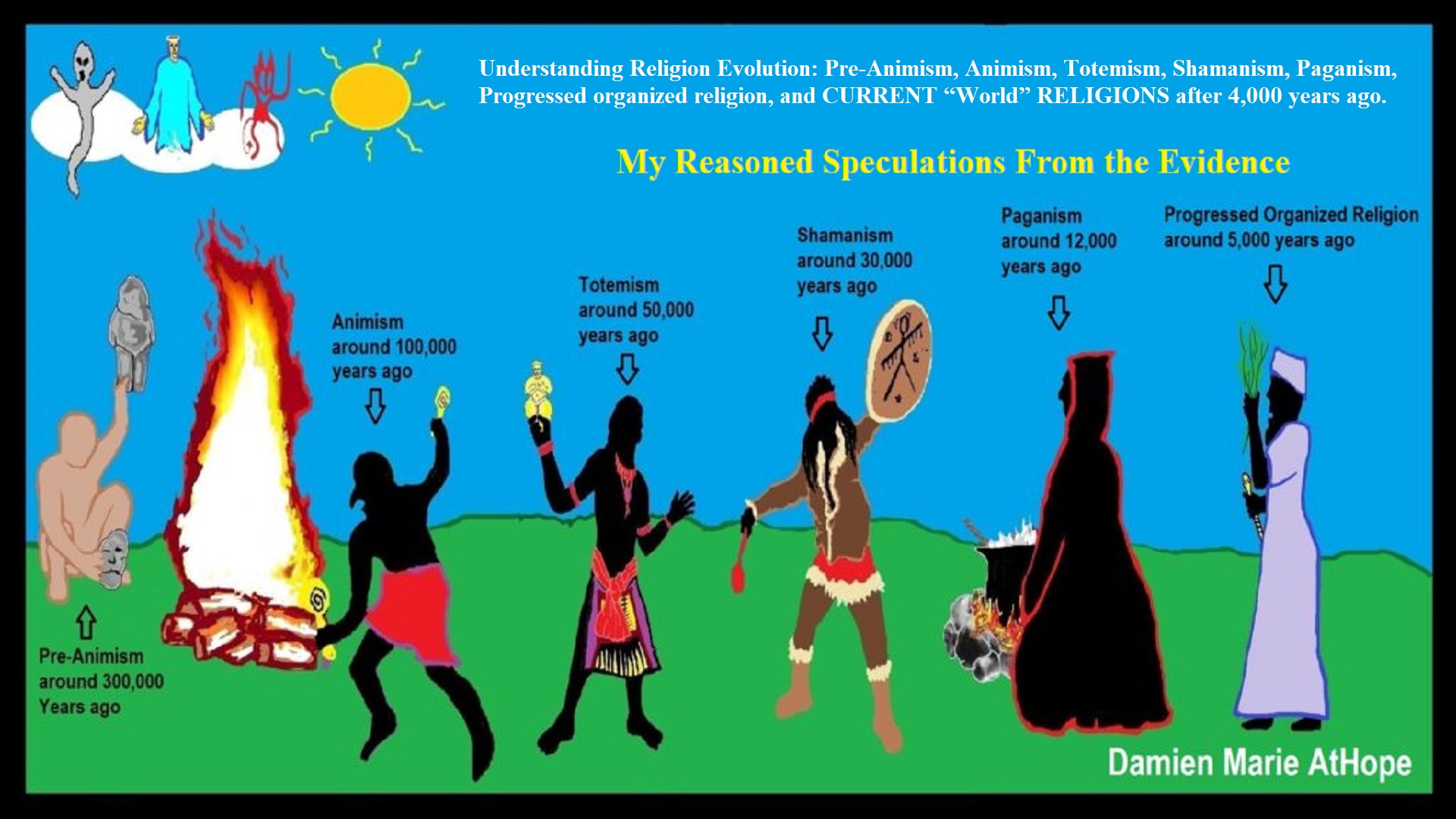
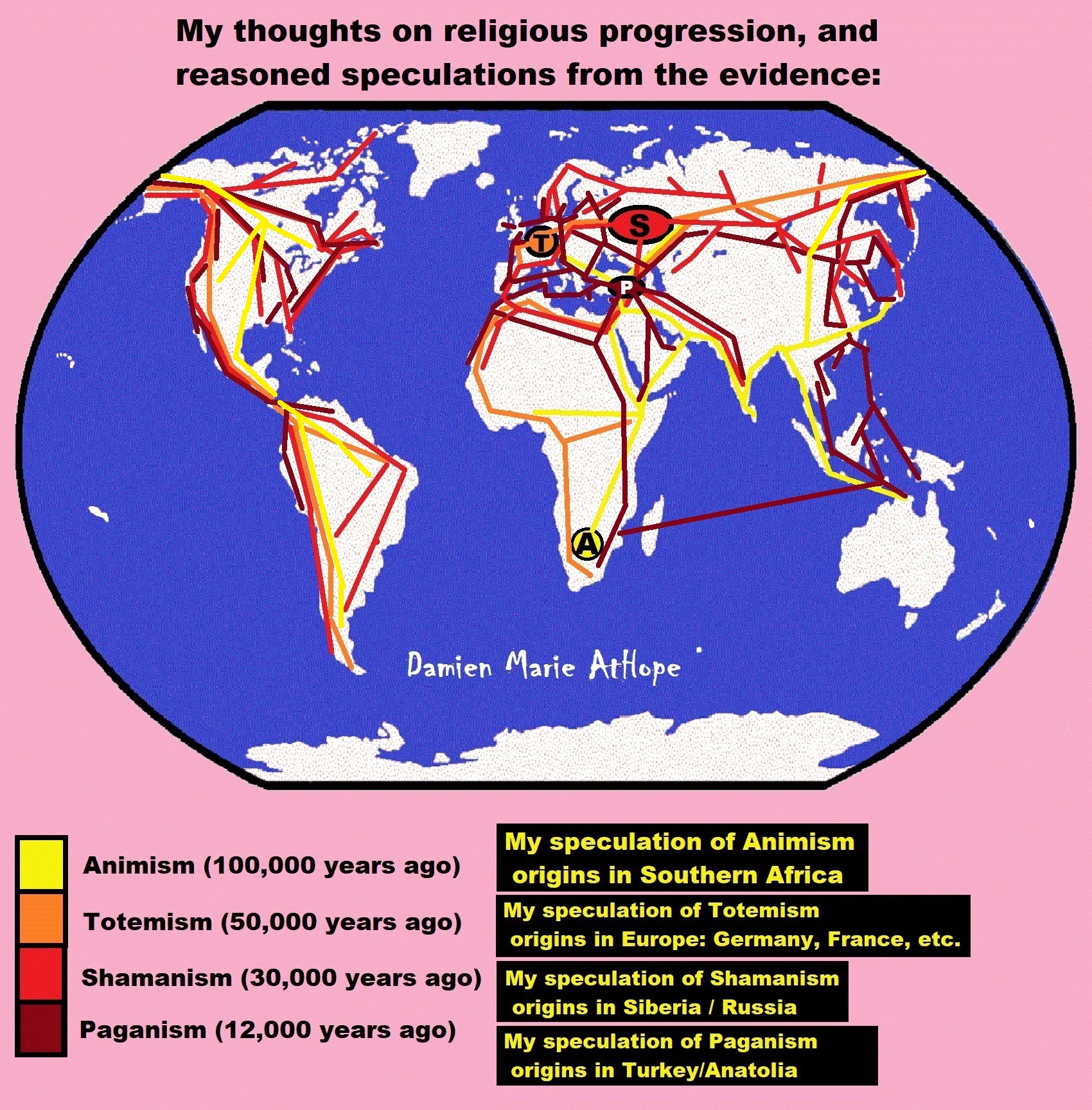
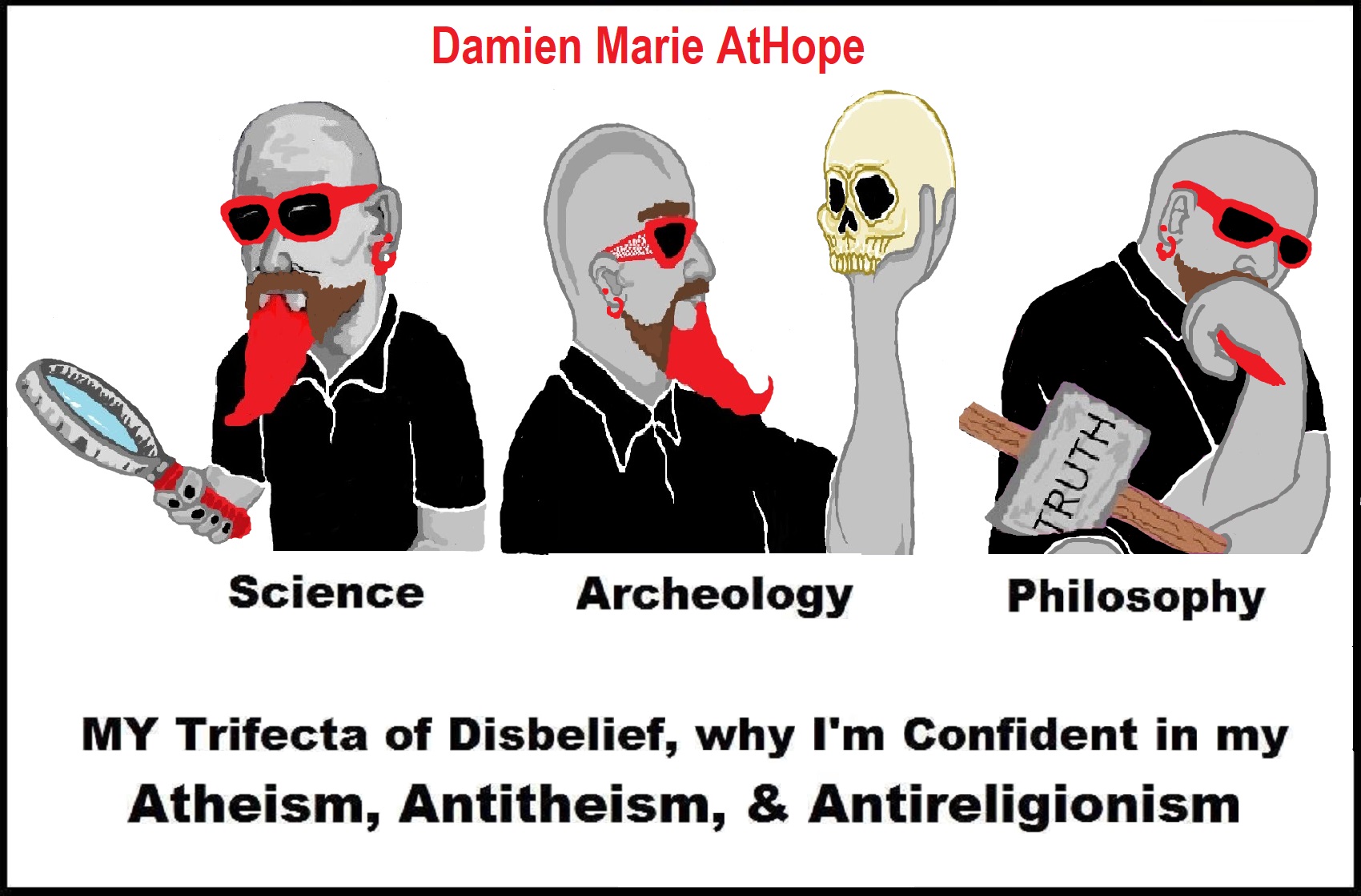
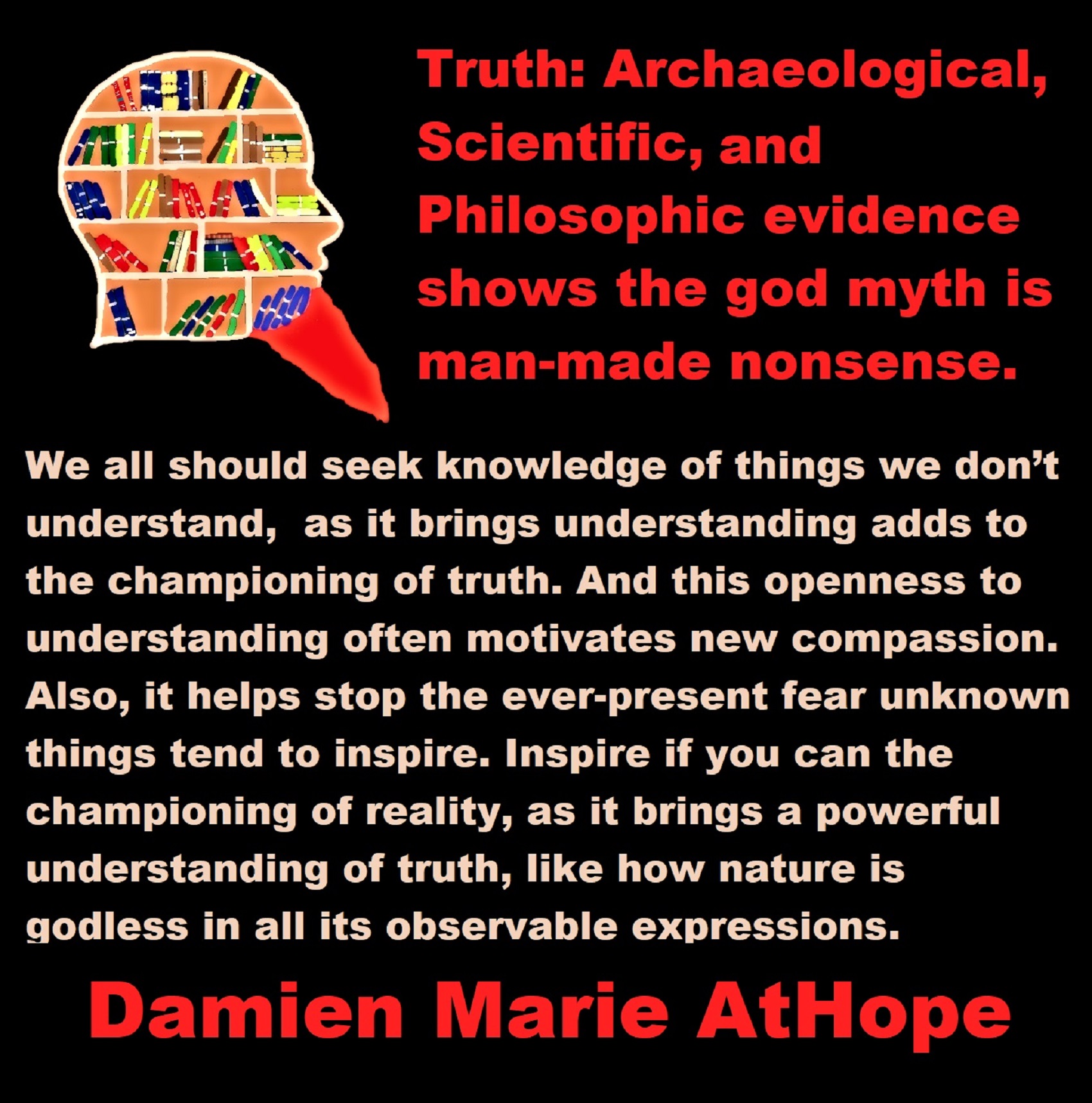

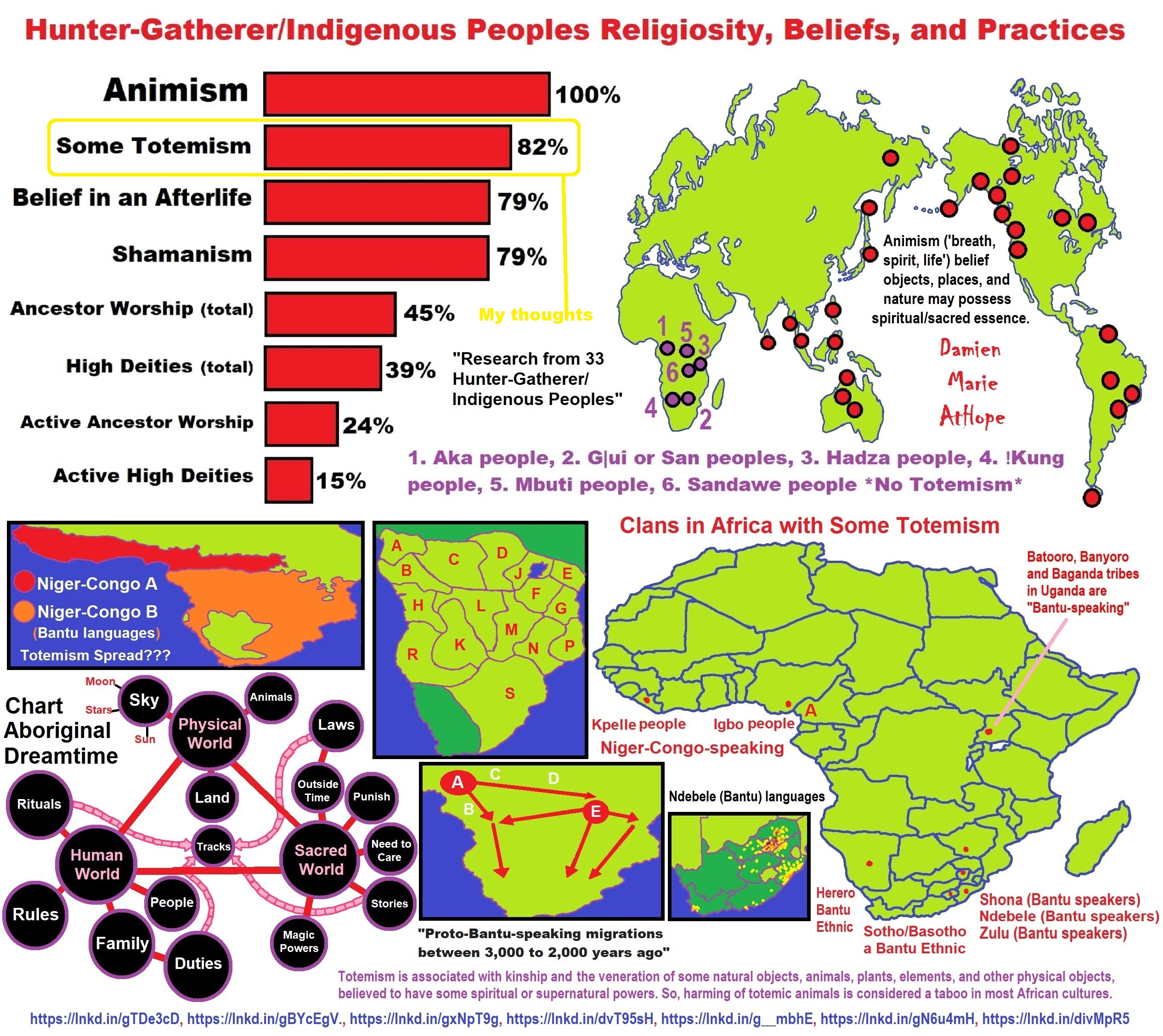
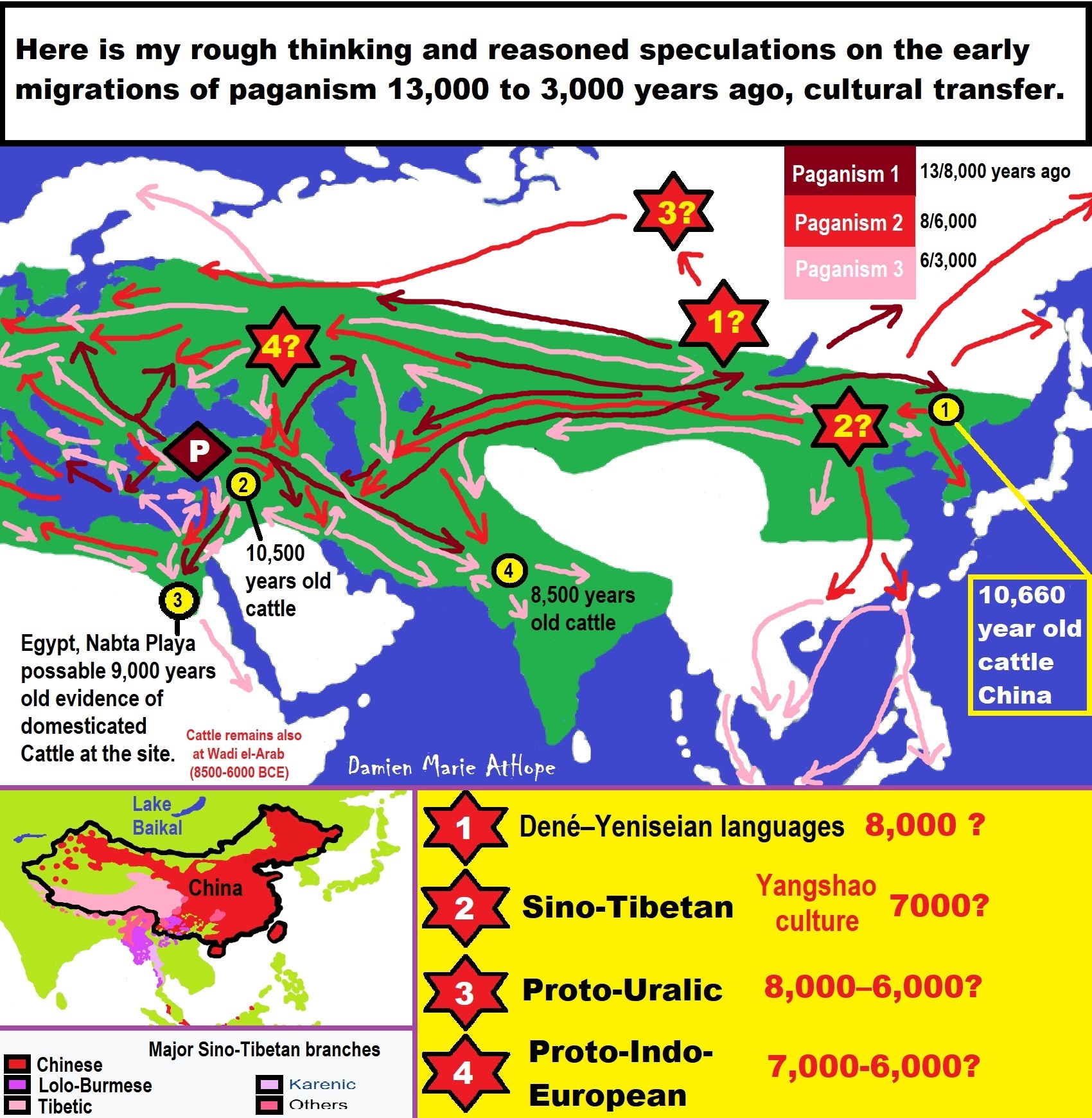

ref, ref, ref, ref, ref, ref, ref, ref, ref, ref, ref, ref, ref, ref, ref, ref, ref, ref, ref, ref, ref
Low Gods “Earth” or Tutelary deity and High Gods “Sky” or Supreme deity
“An Earth goddess is a deification of the Earth. Earth goddesses are often associated with the “chthonic” deities of the underworld. Ki and Ninhursag are Mesopotamian earth goddesses. In Greek mythology, the Earth is personified as Gaia, corresponding to Roman Terra, Indic Prithvi/Bhūmi, etc. traced to an “Earth Mother” complementary to the “Sky Father” in Proto-Indo-European religion. Egyptian mythology exceptionally has a sky goddess and an Earth god.” ref
“A mother goddess is a goddess who represents or is a personification of nature, motherhood, fertility, creation, destruction or who embodies the bounty of the Earth. When equated with the Earth or the natural world, such goddesses are sometimes referred to as Mother Earth or as the Earth Mother. In some religious traditions or movements, Heavenly Mother (also referred to as Mother in Heaven or Sky Mother) is the wife or feminine counterpart of the Sky father or God the Father.” ref
“Any masculine sky god is often also king of the gods, taking the position of patriarch within a pantheon. Such king gods are collectively categorized as “sky father” deities, with a polarity between sky and earth often being expressed by pairing a “sky father” god with an “earth mother” goddess (pairings of a sky mother with an earth father are less frequent). A main sky goddess is often the queen of the gods and may be an air/sky goddess in her own right, though she usually has other functions as well with “sky” not being her main. In antiquity, several sky goddesses in ancient Egypt, Mesopotamia, and the Near East were called Queen of Heaven. Neopagans often apply it with impunity to sky goddesses from other regions who were never associated with the term historically. The sky often has important religious significance. Many religions, both polytheistic and monotheistic, have deities associated with the sky.” ref
“In comparative mythology, sky father is a term for a recurring concept in polytheistic religions of a sky god who is addressed as a “father”, often the father of a pantheon and is often either a reigning or former King of the Gods. The concept of “sky father” may also be taken to include Sun gods with similar characteristics, such as Ra. The concept is complementary to an “earth mother“. “Sky Father” is a direct translation of the Vedic Dyaus Pita, etymologically descended from the same Proto-Indo-European deity name as the Greek Zeûs Pater and Roman Jupiter and Germanic Týr, Tir or Tiwaz, all of which are reflexes of the same Proto-Indo-European deity’s name, *Dyēus Ph₂tḗr. While there are numerous parallels adduced from outside of Indo-European mythology, there are exceptions (e.g. In Egyptian mythology, Nut is the sky mother and Geb is the earth father).” ref
Tutelary deity
“A tutelary (also tutelar) is a deity or spirit who is a guardian, patron, or protector of a particular place, geographic feature, person, lineage, nation, culture, or occupation. The etymology of “tutelary” expresses the concept of safety and thus of guardianship. In late Greek and Roman religion, one type of tutelary deity, the genius, functions as the personal deity or daimon of an individual from birth to death. Another form of personal tutelary spirit is the familiar spirit of European folklore.” ref
“A tutelary (also tutelar) in Korean shamanism, jangseung and sotdae were placed at the edge of villages to frighten off demons. They were also worshiped as deities. Seonangshin is the patron deity of the village in Korean tradition and was believed to embody the Seonangdang. In Philippine animism, Diwata or Lambana are deities or spirits that inhabit sacred places like mountains and mounds and serve as guardians. Such as: Maria Makiling is the deity who guards Mt. Makiling and Maria Cacao and Maria Sinukuan. In Shinto, the spirits, or kami, which give life to human bodies come from nature and return to it after death. Ancestors are therefore themselves tutelaries to be worshiped. And similarly, Native American beliefs such as Tonás, tutelary animal spirit among the Zapotec and Totems, familial or clan spirits among the Ojibwe, can be animals.” ref
“A tutelary (also tutelar) in Austronesian beliefs such as: Atua (gods and spirits of the Polynesian peoples such as the Māori or the Hawaiians), Hanitu (Bunun of Taiwan‘s term for spirit), Hyang (Kawi, Sundanese, Javanese, and Balinese Supreme Being, in ancient Java and Bali mythology and this spiritual entity, can be either divine or ancestral), Kaitiaki (New Zealand Māori term used for the concept of guardianship, for the sky, the sea, and the land), Kawas (mythology) (divided into 6 groups: gods, ancestors, souls of the living, spirits of living things, spirits of lifeless objects, and ghosts), Tiki (Māori mythology, Tiki is the first man created by either Tūmatauenga or Tāne and represents deified ancestors found in most Polynesian cultures). ” ref, ref, ref, ref, ref, ref, ref
Mesopotamian Tutelary Deities can be seen as ones related to City-States
“Historical city-states included Sumerian cities such as Uruk and Ur; Ancient Egyptian city-states, such as Thebes and Memphis; the Phoenician cities (such as Tyre and Sidon); the five Philistine city-states; the Berber city-states of the Garamantes; the city-states of ancient Greece (the poleis such as Athens, Sparta, Thebes, and Corinth); the Roman Republic (which grew from a city-state into a vast empire); the Italian city-states from the Middle Ages to the early modern period, such as Florence, Siena, Ferrara, Milan (which as they grew in power began to dominate neighboring cities) and Genoa and Venice, which became powerful thalassocracies; the Mayan and other cultures of pre-Columbian Mesoamerica (including cities such as Chichen Itza, Tikal, Copán and Monte Albán); the central Asian cities along the Silk Road; the city-states of the Swahili coast; Ragusa; states of the medieval Russian lands such as Novgorod and Pskov; and many others.” ref
“The Uruk period (ca. 4000 to 3100 BCE; also known as Protoliterate period) of Mesopotamia, named after the Sumerian city of Uruk, this period saw the emergence of urban life in Mesopotamia and the Sumerian civilization. City-States like Uruk and others had a patron tutelary City Deity along with a Priest-King.” ref
“Chinese folk religion, both past, and present, includes myriad tutelary deities. Exceptional individuals, highly cultivated sages, and prominent ancestors can be deified and honored after death. Lord Guan is the patron of military personnel and police, while Mazu is the patron of fishermen and sailors. Such as Tu Di Gong (Earth Deity) is the tutelary deity of a locality, and each individual locality has its own Earth Deity and Cheng Huang Gong (City God) is the guardian deity of an individual city, worshipped by local officials and locals since imperial times.” ref
“A tutelary (also tutelar) in Hinduism, personal tutelary deities are known as ishta-devata, while family tutelary deities are known as Kuladevata. Gramadevata are guardian deities of villages. Devas can also be seen as tutelary. Shiva is the patron of yogis and renunciants. City goddesses include: Mumbadevi (Mumbai), Sachchika (Osian); Kuladevis include: Ambika (Porwad), and Mahalakshmi. In NorthEast India Meitei mythology and religion (Sanamahism) of Manipur, there are various types of tutelary deities, among which Lam Lais are the most predominant ones. Tibetan Buddhism has Yidam as a tutelary deity. Dakini is the patron of those who seek knowledge.” ref
“A tutelary (also tutelar) The Greeks also thought deities guarded specific places: for instance, Athena was the patron goddess of the city of Athens. Socrates spoke of hearing the voice of his personal spirit or daimonion:
You have often heard me speak of an oracle or sign which comes to me … . This sign I have had ever since I was a child. The sign is a voice which comes to me and always forbids me to do something which I am going to do, but never commands me to do anything, and this is what stands in the way of my being a politician.” ref
“Tutelary deities who guard and preserve a place or a person are fundamental to ancient Roman religion. The tutelary deity of a man was his Genius, that of a woman her Juno. In the Imperial era, the Genius of the Emperor was a focus of Imperial cult. An emperor might also adopt a major deity as his personal patron or tutelary, as Augustus did Apollo. Precedents for claiming the personal protection of a deity were established in the Republican era, when for instance the Roman dictator Sulla advertised the goddess Victory as his tutelary by holding public games (ludi) in her honor.” ref
“Each town or city had one or more tutelary deities, whose protection was considered particularly vital in time of war and siege. Rome itself was protected by a goddess whose name was to be kept ritually secret on pain of death (for a supposed case, see Quintus Valerius Soranus). The Capitoline Triad of Juno, Jupiter, and Minerva were also tutelaries of Rome. The Italic towns had their own tutelary deities. Juno often had this function, as at the Latin town of Lanuvium and the Etruscan city of Veii, and was often housed in an especially grand temple on the arx (citadel) or other prominent or central location. The tutelary deity of Praeneste was Fortuna, whose oracle was renowned.” ref
“The Roman ritual of evocatio was premised on the belief that a town could be made vulnerable to military defeat if the power of its tutelary deity were diverted outside the city, perhaps by the offer of superior cult at Rome. The depiction of some goddesses such as the Magna Mater (Great Mother, or Cybele) as “tower-crowned” represents their capacity to preserve the city. A town in the provinces might adopt a deity from within the Roman religious sphere to serve as its guardian, or syncretize its own tutelary with such; for instance, a community within the civitas of the Remi in Gaul adopted Apollo as its tutelary, and at the capital of the Remi (present-day Rheims), the tutelary was Mars Camulus.” ref
Household deity (a kind of or related to a Tutelary deity)
“A household deity is a deity or spirit that protects the home, looking after the entire household or certain key members. It has been a common belief in paganism as well as in folklore across many parts of the world. Household deities fit into two types; firstly, a specific deity – typically a goddess – often referred to as a hearth goddess or domestic goddess who is associated with the home and hearth, such as the ancient Greek Hestia.” ref
“The second type of household deities are those that are not one singular deity, but a type, or species of animistic deity, who usually have lesser powers than major deities. This type was common in the religions of antiquity, such as the Lares of ancient Roman religion, the Gashin of Korean shamanism, and Cofgodas of Anglo-Saxon paganism. These survived Christianisation as fairy-like creatures existing in folklore, such as the Anglo-Scottish Brownie and Slavic Domovoy.” ref
“Household deities were usually worshipped not in temples but in the home, where they would be represented by small idols (such as the teraphim of the Bible, often translated as “household gods” in Genesis 31:19 for example), amulets, paintings, or reliefs. They could also be found on domestic objects, such as cosmetic articles in the case of Tawaret. The more prosperous houses might have a small shrine to the household god(s); the lararium served this purpose in the case of the Romans. The gods would be treated as members of the family and invited to join in meals, or be given offerings of food and drink.” ref
“In many religions, both ancient and modern, a god would preside over the home. Certain species, or types, of household deities, existed. An example of this was the Roman Lares. Many European cultures retained house spirits into the modern period. Some examples of these include:
- Brownie (Scotland and England) or Hob (England) / Kobold (Germany) / Goblin / Hobgoblin
- Domovoy (Slavic)
- Nisse (Norwegian or Danish) / Tomte (Swedish) / Tonttu (Finnish)
- Húsvættir (Norse)” ref
“Although the cosmic status of household deities was not as lofty as that of the Twelve Olympians or the Aesir, they were also jealous of their dignity and also had to be appeased with shrines and offerings, however humble. Because of their immediacy they had arguably more influence on the day-to-day affairs of men than the remote gods did. Vestiges of their worship persisted long after Christianity and other major religions extirpated nearly every trace of the major pagan pantheons. Elements of the practice can be seen even today, with Christian accretions, where statues to various saints (such as St. Francis) protect gardens and grottos. Even the gargoyles found on older churches, could be viewed as guardians partitioning a sacred space.” ref
“For centuries, Christianity fought a mop-up war against these lingering minor pagan deities, but they proved tenacious. For example, Martin Luther‘s Tischreden have numerous – quite serious – references to dealing with kobolds. Eventually, rationalism and the Industrial Revolution threatened to erase most of these minor deities, until the advent of romantic nationalism rehabilitated them and embellished them into objects of literary curiosity in the 19th century. Since the 20th century this literature has been mined for characters for role-playing games, video games, and other fantasy personae, not infrequently invested with invented traits and hierarchies somewhat different from their mythological and folkloric roots.” ref
“In contradistinction to both Herbert Spencer and Edward Burnett Tylor, who defended theories of animistic origins of ancestor worship, Émile Durkheim saw its origin in totemism. In reality, this distinction is somewhat academic, since totemism may be regarded as a particularized manifestation of animism, and something of a synthesis of the two positions was attempted by Sigmund Freud. In Freud’s Totem and Taboo, both totem and taboo are outward expressions or manifestations of the same psychological tendency, a concept which is complementary to, or which rather reconciles, the apparent conflict. Freud preferred to emphasize the psychoanalytic implications of the reification of metaphysical forces, but with particular emphasis on its familial nature. This emphasis underscores, rather than weakens, the ancestral component.” ref
“William Edward Hearn, a noted classicist, and jurist, traced the origin of domestic deities from the earliest stages as an expression of animism, a belief system thought to have existed also in the neolithic, and the forerunner of Indo-European religion. In his analysis of the Indo-European household, in Chapter II “The House Spirit”, Section 1, he states:
The belief which guided the conduct of our forefathers was … the spirit rule of dead ancestors.” ref
“In Section 2 he proceeds to elaborate:
It is thus certain that the worship of deceased ancestors is a vera causa, and not a mere hypothesis. …
In the other European nations, the Slavs, the Teutons, and the Kelts, the House Spirit appears with no less distinctness. … [T]he existence of that worship does not admit of doubt. … The House Spirits had a multitude of other names which it is needless here to enumerate, but all of which are more or less expressive of their friendly relations with man. … In [England] … [h]e is the Brownie. … In Scotland this same Brownie is well known. He is usually described as attached to particular families, with whom he has been known to reside for centuries, threshing the corn, cleaning the house, and performing similar household tasks. His favorite gratification was milk and honey.” ref
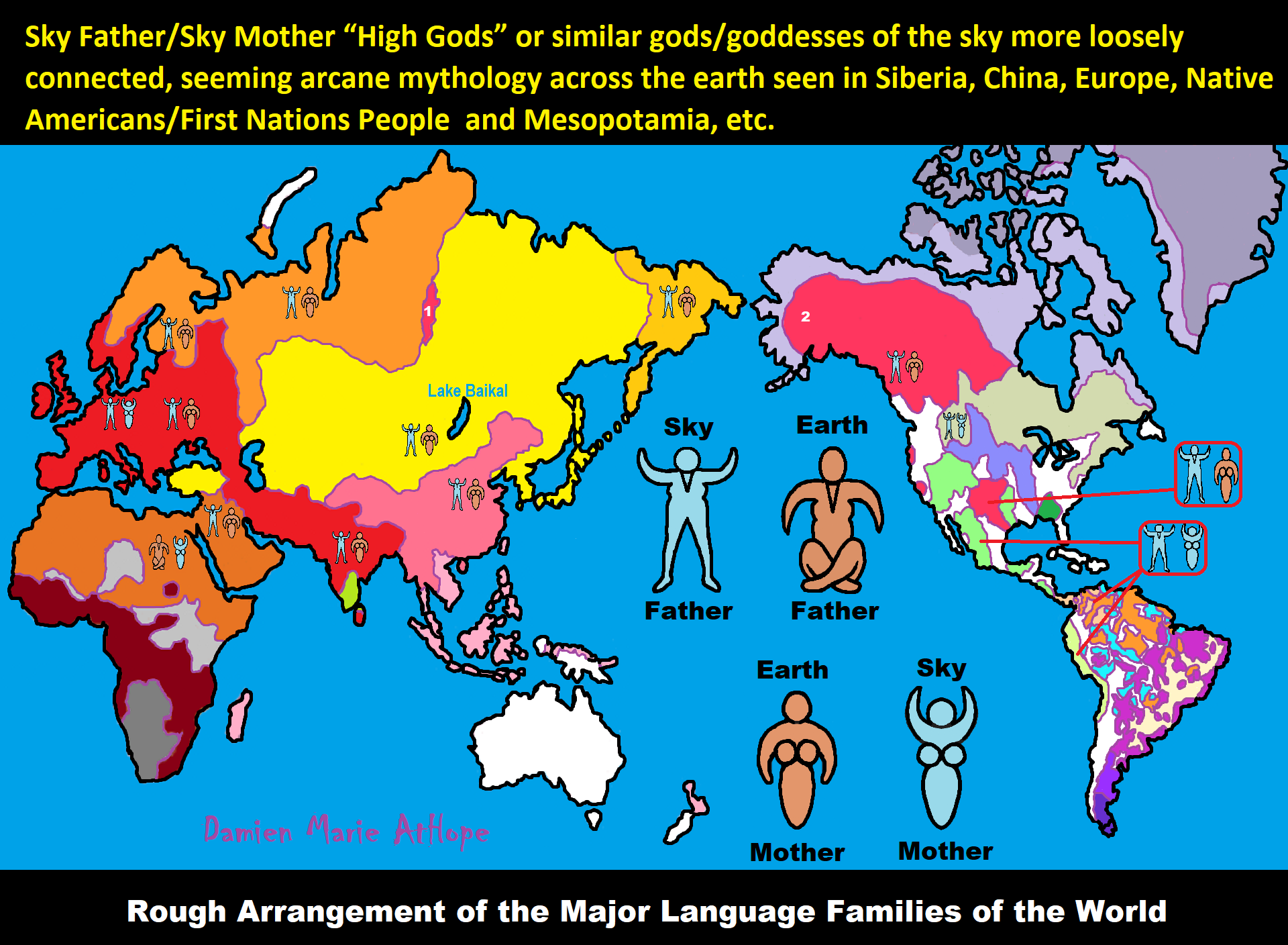
ref, ref, ref, ref, ref, ref, ref, ref, ref, ref, ref, ref, ref, ref, ref, ref, ref
“These ideas are my speculations from the evidence.”
I am still researching the “god‘s origins” all over the world. So you know, it is very complicated but I am smart and willing to look, DEEP, if necessary, which going very deep does seem to be needed here, when trying to actually understand the evolution of gods and goddesses. I am sure of a few things and less sure of others, but even in stuff I am not fully grasping I still am slowly figuring it out, to explain it to others. But as I research more I am understanding things a little better, though I am still working on understanding it all or something close and thus always figuring out more.
Sky Father/Sky God?
“Egyptian: (Nut) Sky Mother and (Geb) Earth Father” (Egypt is different but similar)
Turkic/Mongolic: (Tengri/Tenger Etseg) Sky Father and (Eje/Gazar Eej) Earth Mother *Transeurasian*
Hawaiian: (Wākea) Sky Father and (Papahānaumoku) Earth Mother *Austronesian*
New Zealand/ Māori: (Ranginui) Sky Father and (Papatūānuku) Earth Mother *Austronesian*
Proto-Indo-European: (Dyḗus/Dyḗus ph₂tḗr) Sky Father and (Dʰéǵʰōm/Pleth₂wih₁) Earth Mother
Indo-Aryan: (Dyaus Pita) Sky Father and (Prithvi Mata) Earth Mother *Indo-European*
Italic: (Jupiter) Sky Father and (Juno) Sky Mother *Indo-European*
Etruscan: (Tinia) Sky Father and (Uni) Sky Mother *Tyrsenian/Italy Pre–Indo-European*
Hellenic/Greek: (Zeus) Sky Father and (Hera) Sky Mother who started as an “Earth Goddess” *Indo-European*
Nordic: (Dagr) Sky Father and (Nótt) Sky Mother *Indo-European*
Slavic: (Perun) Sky Father and (Mokosh) Earth Mother *Indo-European*
Illyrian: (Deipaturos) Sky Father and (Messapic Damatura’s “earth-mother” maybe) Earth Mother *Indo-European*
Albanian: (Zojz) Sky Father and (?) *Indo-European*
Baltic: (Perkūnas) Sky Father and (Saulė) Sky Mother *Indo-European*
Germanic: (Týr) Sky Father and (?) *Indo-European*
Colombian-Muisca: (Bochica) Sky Father and (Huythaca) Sky Mother *Chibchan*
Aztec: (Quetzalcoatl) Sky Father and (Xochiquetzal) Sky Mother *Uto-Aztecan*
Incan: (Viracocha) Sky Father and (Mama Runtucaya) Sky Mother *Quechuan*
China: (Tian/Shangdi) Sky Father and (Dì) Earth Mother *Sino-Tibetan*
Sumerian, Assyrian and Babylonian: (An/Anu) Sky Father and (Ki) Earth Mother
Finnish: (Ukko) Sky Father and (Akka) Earth Mother *Finno-Ugric*
Sami: (Horagalles) Sky Father and (Ravdna) Earth Mother *Finno-Ugric*
Puebloan-Zuni: (Ápoyan Ta’chu) Sky Father and (Áwitelin Tsíta) Earth Mother
Puebloan-Hopi: (Tawa) Sky Father and (Kokyangwuti/Spider Woman/Grandmother) Earth Mother *Uto-Aztecan*
Puebloan-Navajo: (Tsohanoai) Sky Father and (Estsanatlehi) Earth Mother *Na-Dene*
ref, ref, ref, ref, ref, ref, ref, ref, ref, ref, ref, ref, ref, ref, ref, ref, ref, ref, ref, ref, ref, ref, ref, ref, ref, ref, ref

Hinduism around 3,700 to 3,500 years old. ref
Judaism around 3,450 or 3,250 years old. (The first writing in the bible was “Paleo-Hebrew” dated to around 3,000 years ago Khirbet Qeiyafa is the site of an ancient fortress city overlooking the Elah Valley. And many believe the religious Jewish texts were completed around 2,500) ref, ref
Judaism is around 3,450 or 3,250 years old. (“Paleo-Hebrew” 3,000 years ago and Torah 2,500 years ago)
“Judaism is an Abrahamic, its roots as an organized religion in the Middle East during the Bronze Age. Some scholars argue that modern Judaism evolved from Yahwism, the religion of ancient Israel and Judah, by the late 6th century BCE, and is thus considered to be one of the oldest monotheistic religions.” ref
“Yahwism is the name given by modern scholars to the religion of ancient Israel, essentially polytheistic, with a plethora of gods and goddesses. Heading the pantheon was Yahweh, the national god of the Israelite kingdoms of Israel and Judah, with his consort, the goddess Asherah; below them were second-tier gods and goddesses such as Baal, Shamash, Yarikh, Mot, and Astarte, all of whom had their own priests and prophets and numbered royalty among their devotees, and a third and fourth tier of minor divine beings, including the mal’ak, the messengers of the higher gods, who in later times became the angels of Judaism, Christianity and Islam. Yahweh, however, was not the ‘original’ god of Israel “Isra-El”; it is El, the head of the Canaanite pantheon, whose name forms the basis of the name “Israel”, and none of the Old Testament patriarchs, the tribes of Israel, the Judges, or the earliest monarchs, have a Yahwistic theophoric name (i.e., one incorporating the name of Yahweh).” ref
“El is a Northwest Semitic word meaning “god” or “deity“, or referring (as a proper name) to any one of multiple major ancient Near Eastern deities. A rarer form, ‘ila, represents the predicate form in Old Akkadian and in Amorite. The word is derived from the Proto-Semitic *ʔil-, meaning “god”. Specific deities known as ‘El or ‘Il include the supreme god of the ancient Canaanite religion and the supreme god of East Semitic speakers in Mesopotamia’s Early Dynastic Period. ʼĒl is listed at the head of many pantheons. In some Canaanite and Ugaritic sources, ʼĒl played a role as father of the gods, of creation, or both. For example, in the Ugaritic texts, ʾil mlk is understood to mean “ʼĒl the King” but ʾil hd as “the god Hadad“. The Semitic root ʾlh (Arabic ʾilāh, Aramaic ʾAlāh, ʾElāh, Hebrew ʾelōah) may be ʾl with a parasitic h, and ʾl may be an abbreviated form of ʾlh. In Ugaritic the plural form meaning “gods” is ʾilhm, equivalent to Hebrew ʾelōhîm “powers”. In the Hebrew texts this word is interpreted as being semantically singular for “god” by biblical commentators. However the documentary hypothesis for the Old Testament (corresponds to the Jewish Torah) developed originally in the 1870s, identifies these that different authors – the Jahwist, Elohist, Deuteronomist, and the Priestly source – were responsible for editing stories from a polytheistic religion into those of a monotheistic religion. Inconsistencies that arise between monotheism and polytheism in the texts are reflective of this hypothesis.” ref
Jainism around 2,599 – 2,527 years old. ref
Confucianism around 2,600 – 2,551 years old. ref
Buddhism around 2,563/2,480 – 2,483/2,400 years old. ref
Christianity around 2,o00 years old. ref
Shinto around 1,305 years old. ref
Islam around 1407–1385 years old. ref

Knowledge to Ponder:
Stars/Astrology:
- Possibly, around 30,000 years ago (in simpler form) to 6,000 years ago, Stars/Astrology are connected to Ancestors, Spirit Animals, and Deities.
- The star also seems to be a possible proto-star for Star of Ishtar, Star of Inanna, or Star of Venus.
- Around 7,000 to 6,000 years ago, Star Constellations/Astrology have connections to the “Kurgan phenomenon” of below-ground “mound” stone/wood burial structures and “Dolmen phenomenon” of above-ground stone burial structures.
- Around 6,500–5,800 years ago, The Northern Levant migrations into Jordon and Israel in the Southern Levant brought new cultural and religious transfer from Turkey and Iran.
- “The Ghassulian Star,” a mysterious 6,000-year-old mural from Jordan may have connections to the European paganstic kurgan/dolmens phenomenon.
“Astrology is a range of divinatory practices, recognized as pseudoscientific since the 18th century, that claim to discern information about human affairs and terrestrial events by studying the apparent positions of celestial objects. Different cultures have employed forms of astrology since at least the 2nd millennium BCE, these practices having originated in calendrical systems used to predict seasonal shifts and to interpret celestial cycles as signs of divine communications. Most, if not all, cultures have attached importance to what they observed in the sky, and some—such as the Hindus, Chinese, and the Maya—developed elaborate systems for predicting terrestrial events from celestial observations. Western astrology, one of the oldest astrological systems still in use, can trace its roots to 19th–17th century BCE Mesopotamia, from where it spread to Ancient Greece, Rome, the Islamicate world and eventually Central and Western Europe. Contemporary Western astrology is often associated with systems of horoscopes that purport to explain aspects of a person’s personality and predict significant events in their lives based on the positions of celestial objects; the majority of professional astrologers rely on such systems.” ref
Around 5,500 years ago, Science evolves, The first evidence of science was 5,500 years ago and was demonstrated by a body of empirical, theoretical, and practical knowledge about the natural world. ref
Around 5,000 years ago, Origin of Logics is a Naturalistic Observation (principles of valid reasoning, inference, & demonstration) ref
Around 4,150 to 4,000 years ago: The earliest surviving versions of the Sumerian Epic of Gilgamesh, which was originally titled “He who Saw the Deep” (Sha naqba īmuru) or “Surpassing All Other Kings” (Shūtur eli sharrī) were written. ref
Hinduism:
- 3,700 years ago or so, the oldest of the Hindu Vedas (scriptures), the Rig Veda was composed.
- 3,500 years ago or so, the Vedic Age began in India after the collapse of the Indus Valley Civilization.
Judaism:
- around 3,000 years ago, the first writing in the bible was “Paleo-Hebrew”
- around 2,500 years ago, many believe the religious Jewish texts were completed
Myths: The bible inspired religion is not just one religion or one myth but a grouping of several religions and myths
- Around 3,450 or 3,250 years ago, according to legend, is the traditionally accepted period in which the Israelite lawgiver, Moses, provided the Ten Commandments.
- Around 2,500 to 2,400 years ago, a collection of ancient religious writings by the Israelites based primarily upon the Hebrew Bible, Tanakh, or Old Testament is the first part of Christianity’s bible.
- Around 2,400 years ago, the most accepted hypothesis is that the canon was formed in stages, first the Pentateuch (Torah).
- Around 2,140 to 2,116 years ago, the Prophets was written during the Hasmonean dynasty, and finally the remaining books.
- Christians traditionally divide the Old Testament into four sections:
- The first five books or Pentateuch (Torah).
- The proposed history books telling the history of the Israelites from their conquest of Canaan to their defeat and exile in Babylon.
- The poetic and proposed “Wisdom books” dealing, in various forms, with questions of good and evil in the world.
- The books of the biblical prophets, warning of the consequences of turning away from God:
- Henotheism:
- Exodus 20:23 “You shall not make other gods besides Me (not saying there are no other gods just not to worship them); gods of silver or gods of gold, you shall not make for yourselves.”
- Polytheism:
- Judges 10:6 “Then the sons of Israel again did evil in the sight of the LORD, served the Baals and the Ashtaroth, the gods of Aram, the gods of Sidon, the gods of Moab, the gods of the sons of Ammon, and the gods of the Philistines; thus they forsook the LORD and did not serve Him.”
- 1 Corinthians 8:5 “For even if there are so-called gods whether in heaven or on earth, as indeed there are many gods and many lords.”
- Monotheism:
- Isaiah 43:10 “You are my witnesses,” declares the LORD, “and my servant whom I have chosen, so that you may know and believe me and understand that I am he. Before me no god was formed, nor will there be one after me.
Around 2,570 to 2,270 Years Ago, there is a confirmation of atheistic doubting as well as atheistic thinking, mainly by Greek philosophers. However, doubting gods is likely as old as the invention of gods and should destroy the thinking that belief in god(s) is the “default belief”. The Greek word is apistos (a “not” and pistos “faithful,”), thus not faithful or faithless because one is unpersuaded and unconvinced by a god(s) claim. Short Definition: unbelieving, unbeliever, or unbelief.

Expressions of Atheistic Thinking:
- Around 2,600 years ago, Ajita Kesakambali, ancient Indian philosopher, who is the first known proponent of Indian materialism. ref
- Around 2,535 to 2,475 years ago, Heraclitus, Greek pre-Socratic philosopher, a native of the Greek city Ephesus, Ionia, on the coast of Anatolia, also known as Asia Minor or modern Turkey. ref
- Around 2,500 to 2,400 years ago, according to The Story of Civilization book series certain African pygmy tribes have no identifiable gods, spirits, or religious beliefs or rituals, and even what burials accrue are without ceremony. ref
- Around 2,490 to 2,430 years ago, Empedocles, Greek pre-Socratic philosopher and a citizen of Agrigentum, a Greek city in Sicily. ref
- Around 2,460 to 2,370 years ago, Democritus, Greek pre-Socratic philosopher considered to be the “father of modern science” possibly had some disbelief amounting to atheism. ref
- Around 2,399 years ago or so, Socrates, a famous Greek philosopher was tried for sinfulness by teaching doubt of state gods. ref
- Around 2,341 to 2,270 years ago, Epicurus, a Greek philosopher known for composing atheistic critics and famously stated, “Is God willing to prevent evil, but not able? Then he is not omnipotent. Is he able, but not willing? Then he is malevolent. Is he both able and willing? Then whence cometh evil? Is he neither able nor willing? Then why call him god?” ref
This last expression by Epicurus, seems to be an expression of Axiological Atheism. To understand and utilize value or actually possess “Value Conscious/Consciousness” to both give a strong moral “axiological” argument (the problem of evil) as well as use it to fortify humanism and positive ethical persuasion of human helping and care responsibilities. Because value-blindness gives rise to sociopathic/psychopathic evil.
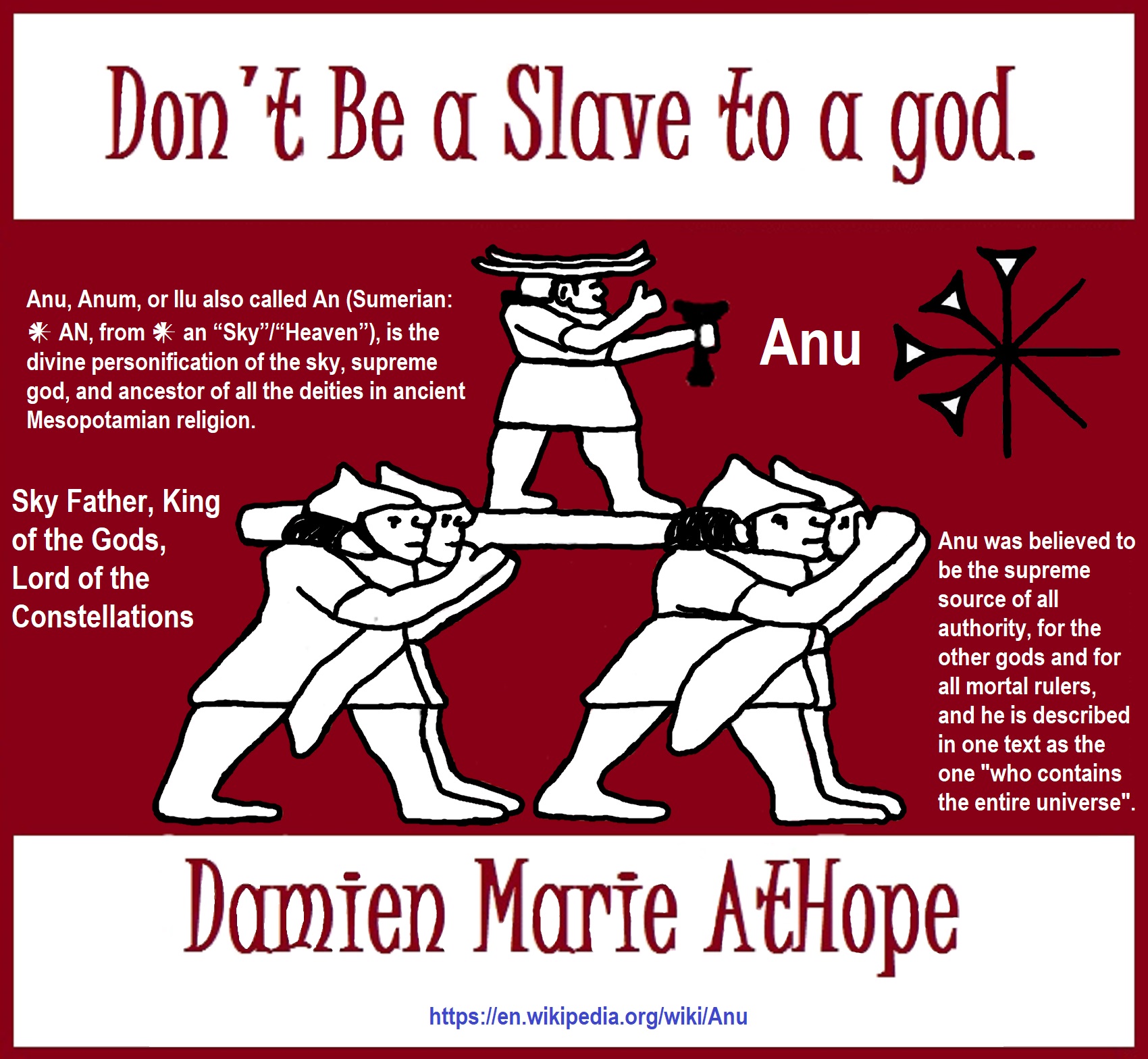
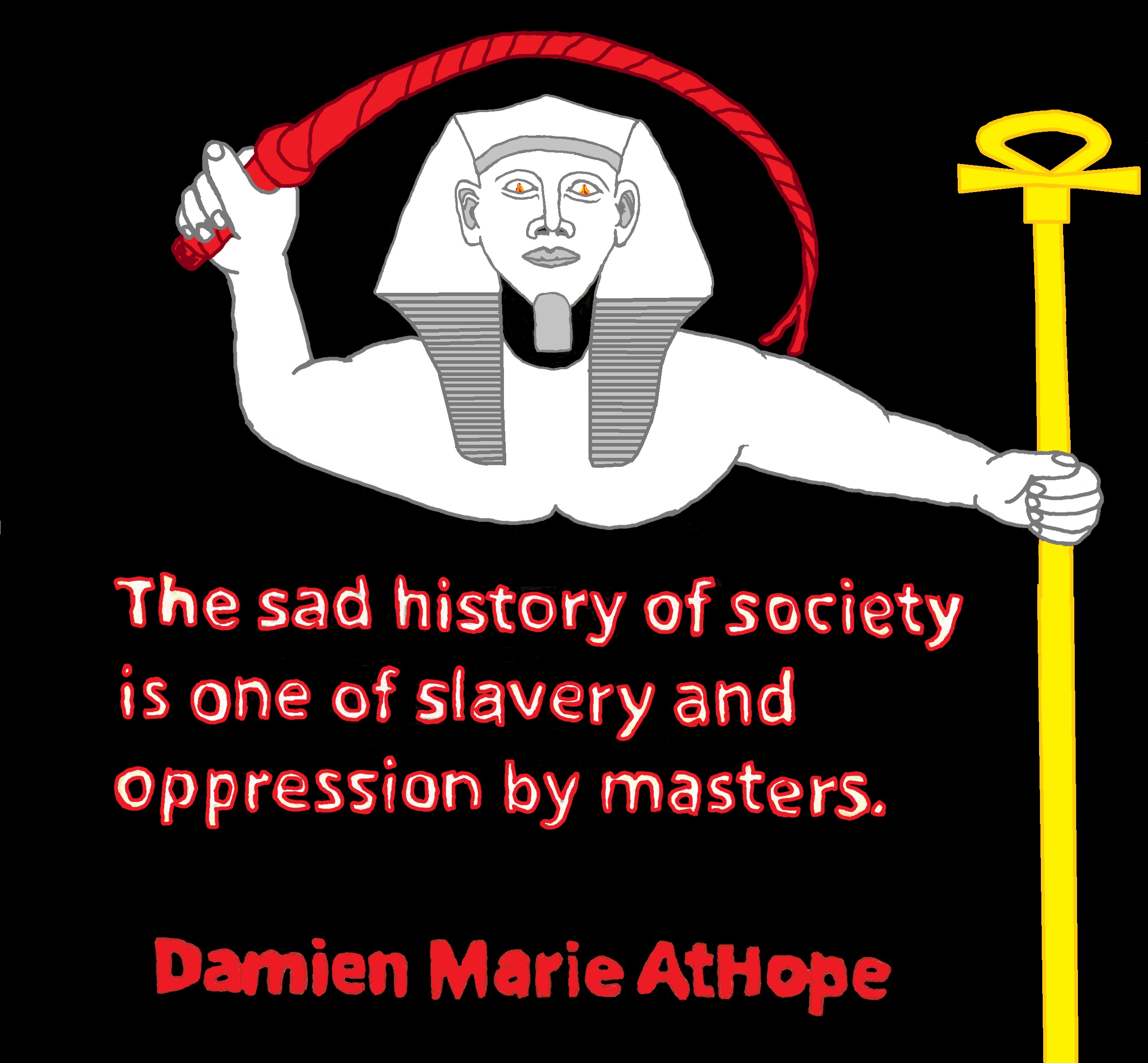

While hallucinogens are associated with shamanism, it is alcohol that is associated with paganism.
The Atheist-Humanist-Leftist Revolutionaries Shows in the prehistory series:
Show two: Pre-animism 300,000 years old and animism 100,000 years old: related to “Anarchism and Socialism”
Show tree: Totemism 50,000 years old: related to “Anarchism and Socialism”
Show four: Shamanism 30,000 years old: related to “Anarchism and Socialism”
Show five: Paganism 12,000 years old: related to “Anarchism and Socialism”
Show six: Emergence of hierarchy, sexism, slavery, and the new male god dominance: Paganism 7,000-5,000 years old: related to “Anarchism and Socialism” (Capitalism) (World War 0) Elite and their slaves!
Prehistory: related to “Anarchism and Socialism” the division of labor, power, rights, and recourses: VIDEO
Pre-animism 300,000 years old and animism 100,000 years old: related to “Anarchism and Socialism”: VIDEO
Totemism 50,000 years old: related to “Anarchism and Socialism”: VIDEO
Shamanism 30,000 years old: related to “Anarchism and Socialism”: VIDEO
Paganism 12,000 years old: related to “Anarchism and Socialism” (Pre-Capitalism): VIDEO
Paganism 7,000-5,000 years old: related to “Anarchism and Socialism” (Capitalism) (World War 0) Elite and their slaves: VIEDO
Paganism 5,000 years old: progressed organized religion and the state: related to “Anarchism and Socialism” (Kings and the Rise of the State): VIEDO
Paganism 4,000 years old: related to “Anarchism and Socialism” (First Moralistic gods, then the Origin time of Monotheism): VIEDO
I do not hate simply because I challenge and expose myths or lies any more than others being thought of as loving simply because of the protection and hiding from challenge their favored myths or lies.
The truth is best championed in the sunlight of challenge.
An archaeologist once said to me “Damien religion and culture are very different”
My response, So are you saying that was always that way, such as would you say Native Americans’ cultures are separate from their religions? And do you think it always was the way you believe?
I had said that religion was a cultural product. That is still how I see it and there are other archaeologists that think close to me as well. Gods too are the myths of cultures that did not understand science or the world around them, seeing magic/supernatural everywhere.
I personally think there is a goddess and not enough evidence to support a male god at Çatalhöyük but if there was both a male and female god and goddess then I know the kind of gods they were like Proto-Indo-European mythology.
This series idea was addressed in, Anarchist Teaching as Free Public Education or Free Education in the Public: VIDEO
Our 12 video series: Organized Oppression: Mesopotamian State Force and the Politics of power (9,000-4,000 years ago), is adapted from: The Complete and Concise History of the Sumerians and Early Bronze Age Mesopotamia (7000-2000 BC): https://www.youtube.com/watch?v=szFjxmY7jQA by “History with Cy“
Show #1: Mesopotamian State Force and the Politics of Power (Samarra, Halaf, Ubaid)
Show #2: Mesopotamian State Force and the Politics of Power
Show #3: Mesopotamian State Force and the Politics of Power (Uruk and the First Cities)
Show #4: Mesopotamian State Force and the Politics of Power (First Kings)
Show #5: Mesopotamian State Force and the Politics of Power (Early Dynastic Period)
Show #6: Mesopotamian State Force and the Politics of Power
Show #7: Mesopotamian State Force and the Politics of Power (Sargon and Akkadian Rule)
Show #9: Mesopotamian State Force and the Politics of Power (Gudea of Lagash and Utu-hegal)
Show #12: Mesopotamian State Force and the Politics of Power (Aftermath and Legacy of Sumer)

The “Atheist-Humanist-Leftist Revolutionaries”
Cory Johnston ☭ Ⓐ Atheist Leftist @Skepticallefty & I (Damien Marie AtHope) @AthopeMarie (my YouTube & related blog) are working jointly in atheist, antitheist, antireligionist, antifascist, anarchist, socialist, and humanist endeavors in our videos together, generally, every other Saturday.
Why Does Power Bring Responsibility?
Think, how often is it the powerless that start wars, oppress others, or commit genocide? So, I guess the question is to us all, to ask, how can power not carry responsibility in a humanity concept? I know I see the deep ethical responsibility that if there is power their must be a humanistic responsibility of ethical and empathic stewardship of that power. Will I be brave enough to be kind? Will I possess enough courage to be compassionate? Will my valor reach its height of empathy? I as everyone, earns our justified respect by our actions, that are good, ethical, just, protecting, and kind. Do I have enough self-respect to put my love for humanity’s flushing, over being brought down by some of its bad actors? May we all be the ones doing good actions in the world, to help human flourishing.
I create the world I want to live in, striving for flourishing. Which is not a place but a positive potential involvement and promotion; a life of humanist goal precision. To master oneself, also means mastering positive prosocial behaviors needed for human flourishing. I may have lost a god myth as an atheist, but I am happy to tell you, my friend, it is exactly because of that, leaving the mental terrorizer, god belief, that I truly regained my connected ethical as well as kind humanity.
Cory and I will talk about prehistory and theism, addressing the relevance to atheism, anarchism, and socialism.
At the same time as the rise of the male god, 7,000 years ago, there was also the very time there was the rise of violence, war, and clans to kingdoms, then empires, then states. It is all connected back to 7,000 years ago, and it moved across the world.
Cory Johnston: https://damienmarieathope.com/2021/04/cory-johnston-mind-of-a-skeptical-leftist/?v=32aec8db952d
The Mind of a Skeptical Leftist (YouTube)
Cory Johnston: Mind of a Skeptical Leftist @Skepticallefty
The Mind of a Skeptical Leftist By Cory Johnston: “Promoting critical thinking, social justice, and left-wing politics by covering current events and talking to a variety of people. Cory Johnston has been thoughtfully talking to people and attempting to promote critical thinking, social justice, and left-wing politics.” http://anchor.fm/skepticalleft
Cory needs our support. We rise by helping each other.
Cory Johnston ☭ Ⓐ @Skepticallefty Evidence-based atheist leftist (he/him) Producer, host, and co-host of 4 podcasts @skeptarchy @skpoliticspod and @AthopeMarie
Damien Marie AtHope (“At Hope”) Axiological Atheist, Anti-theist, Anti-religionist, Secular Humanist. Rationalist, Writer, Artist, Poet, Philosopher, Advocate, Activist, Psychology, and Armchair Archaeology/Anthropology/Historian.
Damien is interested in: Freedom, Liberty, Justice, Equality, Ethics, Humanism, Science, Atheism, Antiteism, Antireligionism, Ignosticism, Left-Libertarianism, Anarchism, Socialism, Mutualism, Axiology, Metaphysics, LGBTQI, Philosophy, Advocacy, Activism, Mental Health, Psychology, Archaeology, Social Work, Sexual Rights, Marriage Rights, Woman’s Rights, Gender Rights, Child Rights, Secular Rights, Race Equality, Ageism/Disability Equality, Etc. And a far-leftist, “Anarcho-Humanist.”
I am not a good fit in the atheist movement that is mostly pro-capitalist, I am anti-capitalist. Mostly pro-skeptic, I am a rationalist not valuing skepticism. Mostly pro-agnostic, I am anti-agnostic. Mostly limited to anti-Abrahamic religions, I am an anti-religionist.
To me, the “male god” seems to have either emerged or become prominent around 7,000 years ago, whereas the now favored monotheism “male god” is more like 4,000 years ago or so. To me, the “female goddess” seems to have either emerged or become prominent around 11,000-10,000 years ago or so, losing the majority of its once prominence around 2,000 years ago due largely to the now favored monotheism “male god” that grow in prominence after 4,000 years ago or so.
My Thought on the Evolution of Gods?
Animal protector deities from old totems/spirit animal beliefs come first to me, 13,000/12,000 years ago, then women as deities 11,000/10,000 years ago, then male gods around 7,000/8,000 years ago. Moralistic gods around 5,000/4,000 years ago, and monotheistic gods around 4,000/3,000 years ago.

Damien Marie AtHope (Said as “At” “Hope”)/(Autodidact Polymath but not good at math):
Axiological Atheist, Anti-theist, Anti-religionist, Secular Humanist, Rationalist, Writer, Artist, Jeweler, Poet, “autodidact” Philosopher, schooled in Psychology, and “autodidact” Armchair Archaeology/Anthropology/Pre-Historian (Knowledgeable in the range of: 1 million to 5,000/4,000 years ago). I am an anarchist socialist politically. Reasons for or Types of Atheism
My Website, My Blog, & Short-writing or Quotes, My YouTube, Twitter: @AthopeMarie, and My Email: damien.marie.athope@gmail.com

